|
MIGHTY OAKS FROM LITTLE
ACORNS GROW
|
IN THE BEGINNING - circa 1848
Early settlers in rural
Hillsborough County had to homestead their land just
like the pioneers of the West. And like the West,
Florida had an extensive Native American population long before
the first settlers arrived. Although historical records
are inconsistent regarding the degree of conflict
between the them and the early settlers, their presence did have a direct impact of the patterns
of settlements throughout the state and in Hillsborough
County. Due to the threat (or perceived threat) of attack, most of the
early settlements were located in close to forts such as
Fort Dade, Fort Pierce, Fort Meade, and Fort Brooke in
Tampa.
|
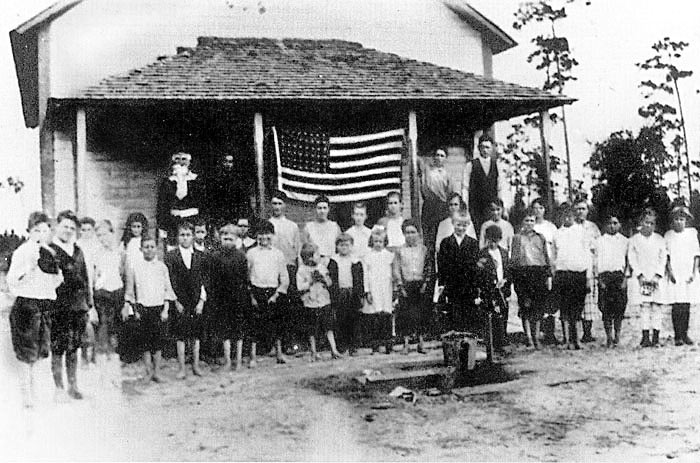 |
|
Santa Claus poses on the porch of Stemper
School A with faculty and students in the
early 1910s, where the teacher would ride
her white horse to the school every morning
from her home at Lake Magdalene. The first settlement in the area now known
as Lutz was originally a Catholic mission
started in the late 1880's by Luxembourg
Catholic priest Francis Xavier A. Stemper.
Stemper bought quite a bit of acreage on the
west side of Lake Bruing in section 13 of
township 27, range 18 east for the purpose
of starting a Catholic colony. Later,
the area on the north side of Stemper became
Lutz. Photo
courtesy of Nealie Squires from Citrus,
Sawmills, Critters & Crackers - Life in
early Lutz and Central Pasco County, by
Elizabeth & Susan MacManus, Univ. of Tampa
Press, 1998.
See History of Lutz at TampaPix.com
|
In the first
half-century or so after the establishment of a Hillsborough County Board of
Education and a Schools Superintendent, there were many
private schools being conducted in homes, churches, community buildings,
etc, scattered around the county. The teachers, if not volunteers,
and maintenance costs, were being
paid from tuition fees.
Most were one-room school houses with
children of all ages at various levels of achievement. Some had
very few students and were taught in private homes.
Many had students of any age, but could have all been on the same
or nearly the same basic educational
level, just starting to read and write, and understand math. Some may
have had a more advanced course being taught to the older students, but
in the same room (if only one teacher) or in separate rooms at the same
time, if more than one teacher was available. Many were
exclusively for females or for males.
The students
attending those schools became some of the first pupils under the
newly developing county education system; a system whose "seed" schools were
those private schools, from in the heart of
Tampa, to outlying areas of the county--and the county was much
bigger than it is now. It was
some of these very same private schools, which over a period of years,
appointed trustees, and petitioned the county for funding, and were approved by the County School Board.
They underwent a transition from private,
tuition-based funding to county funding. They went from privately
owned buildings, to county financed, newly constructed buildings.
They went from privately employed teachers whose pay came solely from
tuition, to partially or fully paid from the county payroll--and this
didn't happen at the same time.
Mention of
"public"
schools in Tampa exists in various records as early as the 1850s,
By 1848,
a school was in operation in the county courthouse. Counts of
the student population exist as early as 1866. In 1868, the
State of Florida's constitution provided for a board of public
instruction, and in the same year, Hillsborough County elected a
County Board of Public Instruction and a superintendent.
The first written
Hillsborough County record
of education held in a "public facility" was
established in 1848 when an educated Englishman, William
P. Wilson, opened a school and was allowed the use of the County Courthouse in
Tampa.
1850
Census of William P. Wilson, Tampa
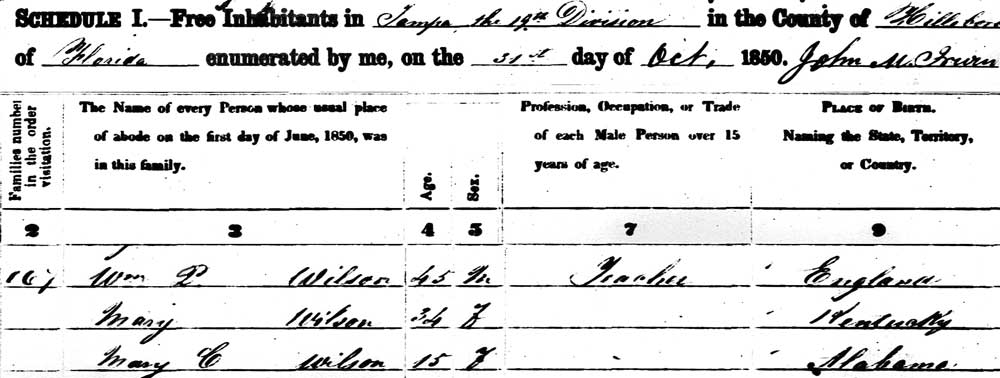
William P. Wilson was 45, occupation teacher, born
in England. His wife, Mary Wilson, was 34, born in
KY. Their daughter, Mary C. Wilson, was 15, born
in AL.
The courthouse
he would have used in 1848 was one built by Scotsman James McKay on the
property bounded by Franklin St, Lafayette (now
Kennedy Blvd.), Monroe St. (now Florida Ave.) and
Madison Street. This became known as "Court house
square" and the building referred to as the "McKay
courthouse." There are no known existing photos of this
courthouse. The
streets back then were no more than wide, sandy, cleared paths through the brush and palmetto scrub.
In
these years, the Hillsborough County Commission served
as the Board of Education until 1869. Unfortunately, shortly after
Wilson's school opened, instruction was halted by the
disastrous hurricane of Sept. 25, 1848 that destroyed
most of the buildings close to the bay.
Read about this hurricane at
The Final Battle for Fort Brooke and
This Old House - The Historic Stringer House
(in the process up being updated.)
|
|
|
THE FIRST TWO HILLSBOROUGH COUNTY COURTHOUSES
THE LOG CABIN COURTHOUSE
The first county
courthouse was built in Tampa largely by the efforts of
Judge Augustus Steele, soon after the County of
Hillsborough was organized
from Alachua and Monroe counties on January 25, 1834,
during the U.S. territorial period (1822–1845). The new county was named for
Wills Hill, the Earl of Hillsborough, who served as
British Secretary of State for the Colonies from 1768 to
1772.
That little log courthouse
was burned by the Indians at the outbreak of the Second
Seminole War (1835-1842). At that time, fewer than a thousand
people lived in Hillsborough County and cattlemen came
to the courthouse most often to complain about stolen
livestock. And, of course, judges and attorneys traveled
long distances by horseback or stagecoach to cover their
“circuit," a name still in use today.
THE "MCKAY" COURTHOUSE
When the first County Commissioners met in 1846, the
general topics were taxes, transportation, a new
courthouse and jail, and town development. The next
year, the Commissioners accepted the bid of Captain
James McKay to construct a two-story courthouse, which
was 20 ft x 45 ft. at a cost to taxpayers of $1,358.
This is the courthouse most refer to as the "The McKay
Courthouse" or the "First courthouse"
although it was really the second one. No
photos have ever been found of this courthouse.
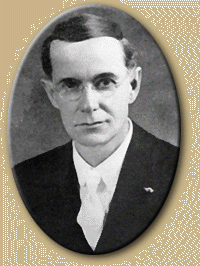 From
E. L. Robinson's History of Hillsborough County: From
E. L. Robinson's History of Hillsborough County:
This courthouse was completed and accepted
from James McKay on January 3, 1848 and his bill paid;
including ten dollars allowed for additional work.
This,
the "first court house" of Hillsborough County, was
erected on the block bounded by Lafayette, Franklin,
Madison and Florida (Monroe St. back then). The entrance was on the
south side and there was one large room for a court room
and two small rooms on the west side for offices and
jury rooms. The material for this building was brought
to Tampa from Mobile by Captain McKay who had come to
Tampa in 1846.
This building was soon
outgrown and no longer adequate for the increasing
business of the county. When a new building was ordered
this building was sold to John H. Redbrook who moved it
to Franklin street. Later it was moved to the comer of
Zack street and Florida avenue and used as a store house
for the Peninsular Telephone Company.
|
|
About a year after the 1848
hurricane, Wilson was once again permitted to use
the courthouse for his school.
Nov. 20, 1849 -
Minutes of the County Commissioners meeting:
"Ordered
by the Board that W. P. Wilson be permitted to continue
his school in the courthouse (when not occupied for
public purposes,) until the first Monday in April, 1850,
which time the citizens of Tampa must furnish a
schoolhouse or be deprived of a school."
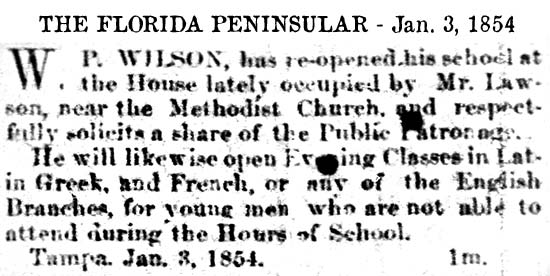 In
1854, Wilson reopened his school in Mr. Lawson's
house near the Methodist church. He also
offered evening classes in Latin, Greek and French,
or any of the English branches,, for young men not
able to attend during the normal hours. In
1854, Wilson reopened his school in Mr. Lawson's
house near the Methodist church. He also
offered evening classes in Latin, Greek and French,
or any of the English branches,, for young men not
able to attend during the normal hours.
Later
in 1858, he resigned to open a private school
believed to be in the Mango area.
Over the next
twenty years, small one-room schools sprung up around
the county in such remote areas as Safety Harbor,
Alafia, Plant City, and Socrum. W. P. Wilson's school program
was funded entirely by tuition fees. In this
sense, it was private. However, the County Commissioners
allowed Wilson to use the courthouse free of charge,
which constitutes the first use of public resources for
educational purposes.
|
|
THE FIRST REPORTED EXPENDITURES PROVIDED FOR
PUBLIC EDUCATION - 1853
Nov. 29, 1853
- From minutes of the County Commissioners meeting:
There were 560 children to be educated in the county for
which the State contributed $107.04. The
County Commissioners added $200 for a total of
$307.04 for the 1853-54 school year. This
worked out to 55 cents per pupil.
Assuming a public school can be any school
funded by the county, regardless of where it's
held,
then
the first public schools in Hillsborough County
were all located in public and private buildings
that had extra space available. All of the
limited funds were directed to teacher salaries
and expenses for operation. Although
Seminole War Gen. Jessie Carter constructed a
school building privately during this period,
the County Commission, and later, the Board of
Education, did not finance construction of a
building until 25 years later.
In 1853, Jasper Glover
opened a school known as the "Tampa Academy"
with 45 students on the first floor of the
Mason's Lodge at Franklin & Whiting streets.
Later, Emelia Porter founded a private school
for girls in the same facility. According
to a legend, children from both programs
feared the goat that reportedly lived upstairs
in the Lodge room.
THE FIRST SUPERINTENDENT OF PUBLIC INSTRUCTION
 On Oct. 29, 1853,
the President of the Board of County
Commissioners, Simon Turman (Jr.), was named the first
Superintendent of Public Instruction. In
1854 he earned a salary of $53 for his duties. On Oct. 29, 1853,
the President of the Board of County
Commissioners, Simon Turman (Jr.), was named the first
Superintendent of Public Instruction. In
1854 he earned a salary of $53 for his duties.
Turman was also a merchant and publisher/editor of the Tampa newspaper "The Florida
Peninsular." His father was a county
probate judge. In the 1860s Turman Jr. was
a Hillsborough County delegate to the Florida
convention on secession.
It is important to keep in mind that a "school"
refers to the institution, or the collection of
teachers, administrators, and students, and not
necessarily a building or structure in which
classes were held.
In 1854, the
County Commission approved schools to be placed
in the following ten districts:
|
1.
Old Tampa (Safety Harbor) |
6. Itchepucksassa (Plant City) |
|
2.
Edward's school house
|
7. Soak Rum (Socrum, N. of
Lakeland) |
|
3.
Spanish Town (Hyde Park) |
8. Peas Creek (Ft. Meade-Peace
creek) |
|
4.
Three schools in Tampa proper |
9. Alafia |
|
5.
Sparkman (near Sydney--SW of Plant
City |
10.
Manatee |
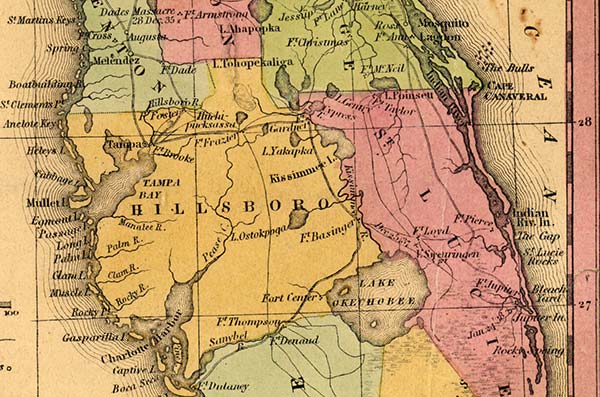
According
to Tampa historian Tony Pizzo, the County
Commission "boasted of three approved schools"
under its jurisdiction, each receiving $33 for
its term of operation. Due to the vast
size of Hillsborough County in the 1850s, the
Commission provided little supervision of the
schools.
Crop of Copperthwaite's Florida 1850 county map
from Florida Memory, State Library & Archives of
Florida
|
|
THE THIRD COUNTY
COURTHOUSE
A third county courthouse
was built in 1854 by John Breaker (sometimes referred to as
"the Breaker courthouse") at a cost of $5,000
and was used until 1891. Of course, it also had a
picket fence to keep the animals out of the courtyard.
Tampa historian
Tony Pizzo stated in his article "James McKay, the
Scottish Chief": In 1870, a visitor commented:
"The first building
to attract my attention was the courthouse, a frame
building set in a clearing in a big scrub. It had a
cupola or belfry, and was the first house I had ever
seen built of anything but logs."

Hillsborough County Courthouse, Lafayette Street
entrance, looking east from intersection with
Franklin Street, 1886.
This is the courthouse that would have held school
classes during the late 1860s and 1870s for
Hillsborough County.
Burgert Brothers photo from University of South
Florida Digital Collection |
|
THE TAMPA HERALD -
WEDNESDAY, JUNE 7, 1854. |
Our Court House |
|
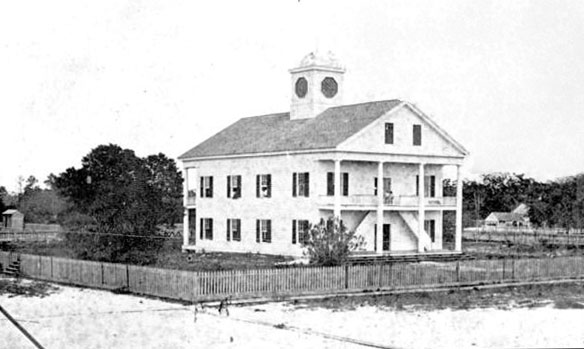
(State
Archives of Florida) |
Through the kindness of
Mr. [John H.] Breaker, contractor and builder of
this magnificent Court House, we are enabled to furnish
our readers with a full description of its order, size,
various offices, etc. etc. The building is 76 ft. long,
by 45 wide, and two stories high. The 1st. story is 12
ft. between joints; the second is 14 1-2 ft. On the 1st
floor is the City Hall, Judge of Probates, Clerks’, and
Sheriff Offices, and Grand Jurors’ room. A spacious Hall
extends from the Southern entrance of the building,
between the four offices to the City Hall.
On the 2nd floor is the
Court Room, 42 by 45 ft., and two spacious Jury rooms,
with a passage extending from the south entrance,
between the jury rooms to the Court-room. A projecting
Portico, an each end, the whole width of the building
supported by heavy Grecian Columns.
|
|
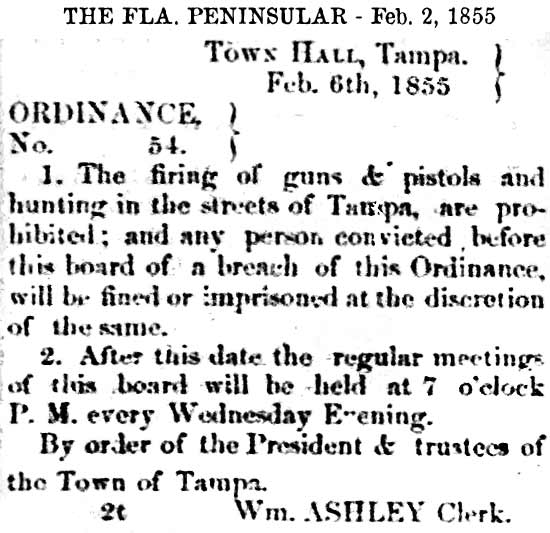 A double flight of
stairs ascends from each end of the building, landing -
on the 2nd floor of the porticos. The roof is mounted
with a dome and tower, 18 ft in diameter, and 24 ft
high, covered with tin, or zinc. A double flight of
stairs ascends from each end of the building, landing -
on the 2nd floor of the porticos. The roof is mounted
with a dome and tower, 18 ft in diameter, and 24 ft
high, covered with tin, or zinc.
The extreme height of
the building, from the pinnacle of the tower to the
ground is 68 feet; and the whole is being beautifully
finished in a combination of the Grecian, Ionic, and
Corinthian orders. The plan was drawn by the contractor,
Mr. Breaker, who has engaged to erect the building, for
a sum less than $5000. The execution of this contract,
we are satisfied, will be attended with considerable
loss to the builder, unless the generosity and
liberality of the County Commissioner’s shall interpose
to prevent it, for the credit of our Town and County, we
hope they will, and not in any stingy manner.
Tampa had no City Hall
building, it had "Town Hall" which was located in this
courthouse. |
"The History of Hillsborough
County Public Schools" shows an image
(below, left) described as "Courthouse built in
1855" which is from Yesterday's Tampa
by Hampton Dunn. But the photo is actually
one of the old Palmetto Hotel at the
northeast corner of Florida Ave. and
Polk St.. Due to
the way the images were arranged
across the page spread in
Dunn's book, the authors of the
school history book misinterpreted
the image descriptions.
|
 |
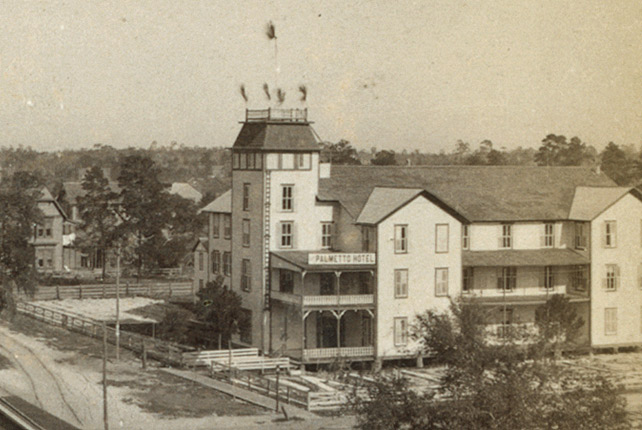 |
| At
right is a
crop of a photo of the
Palmetto Hotel from the ROBERT N.
DENNIS COLLECTION OF
STEREOSCOPIC VIEWS (filtered
for Tampa) at The
New York Public
Library Digital
Collections.
See the whole picture. |
As it
did in 1848, the courthouse served
as the primary public school for the
students in Tampa. It is probable
that the students paid tuition as
they did at the courthouse before
the hurricane.
However, some historians viewed the
use of a public building for
educational purposes as "public
education."
1855 - THE STATE APPROPRIATES FUNDING FOR
SCHOOLS
Three schools offer a tuition-free 4 week term
In 1855 the state appropriated $239.71 to the
Hillsborough County Commission and the County
Commission added $160.29 for a total funding of
$400 for the 1854-55 school year. The funds were
divided among the schools with each school
receiving between $36 and $40. Districts
throughout the state were permitted to charge
tuition if their schools and teachers required
additional funds for salaries and operations.
This Jan. 20, 1855 article in the Tampa Herald
announced the funding of three schools by the
County from the public school fund. J.K.
Glover, James Petty, and W.P. Wilson offered a
4-week period of free schooling to children over
5 to under 18. The Herald hailed this as "the
first step in the practical commencement of the
Public School system..." and urged parents who
could not afford to pay for their child's
education not to delay in sending their children
to school now. Similar arrangements were
to be made in other parts of the County.
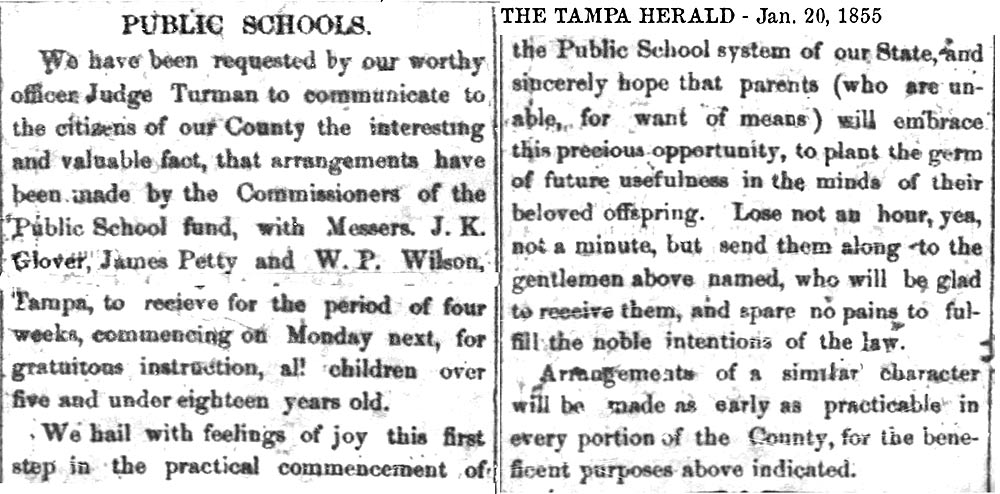
The four weeks
having expired, these 3 schools were back to
tuition-based funding.
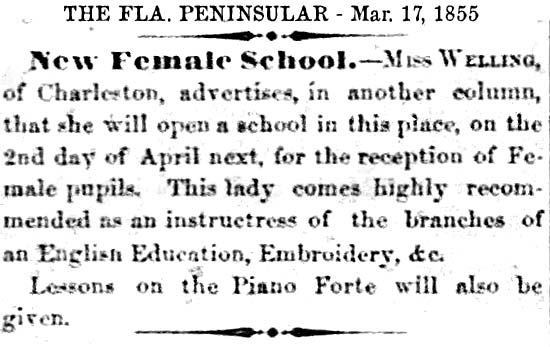
|
This
ad in early 1855 announced that Mary
Griffin had opened a school for
females with all the "ordinary
branches of an English educations."
She also offered courses in music,
if enough students enrolled, on the
piano-forte, which was the
predecessor to the modern day piano.
The school was located in a house
formerly occupied by Mr. Alexander. |
J. K.
Glover had another profession,
probably a
bit more lucrative than teaching, |
|
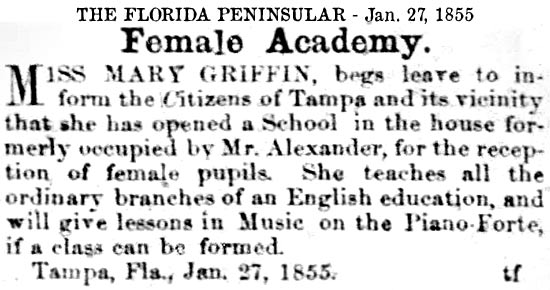 |
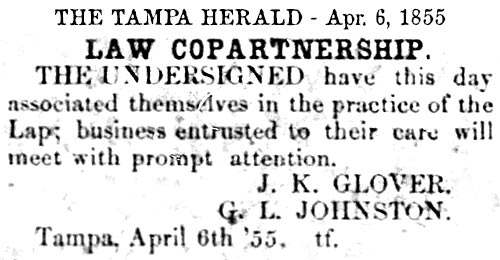
|
| |
|
|
Anna
Welling opened her private school
for girls in Tampa in April, 1855,
in the residence of Mr. T.C.
Andrews. |
March
3, 1855 Job Wanted ad by two
graduates in
S. Carolina looking for teaching
positions. |
|
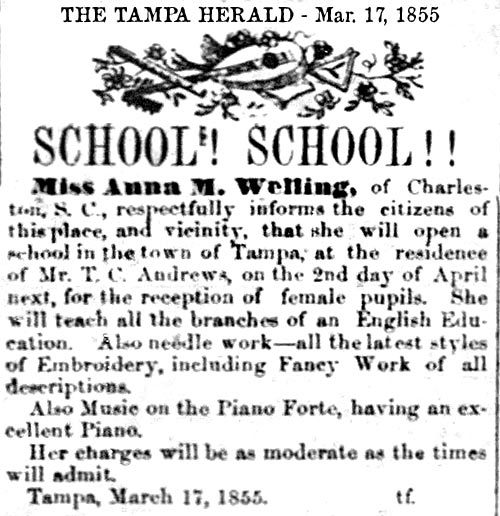 |
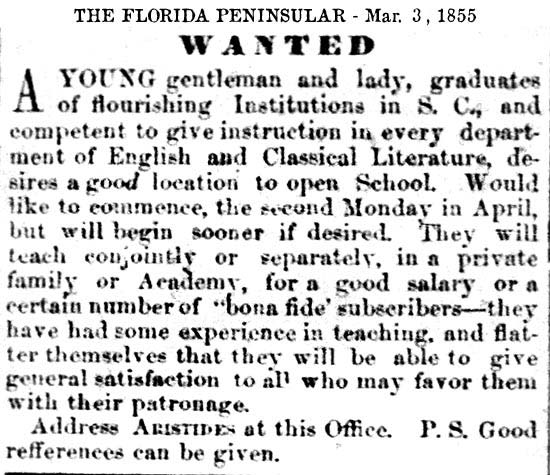 |
| |
|
|
This
Jun. 30, 1855 ad by J.K. Glover
indicated that the Tampa Academy was
financed by tuition and was teaching
high school level courses--Grammar,
Geography, Philosophy, Algebra,
Chemistry, Ancient Geography and
Geometry. His was a 3-month
course--at least. |
This W. P.
Wilson ad announced an 11-week term
would begin on Dec. 3, 1855 "at the
school house near the Methodist
Church." |
|
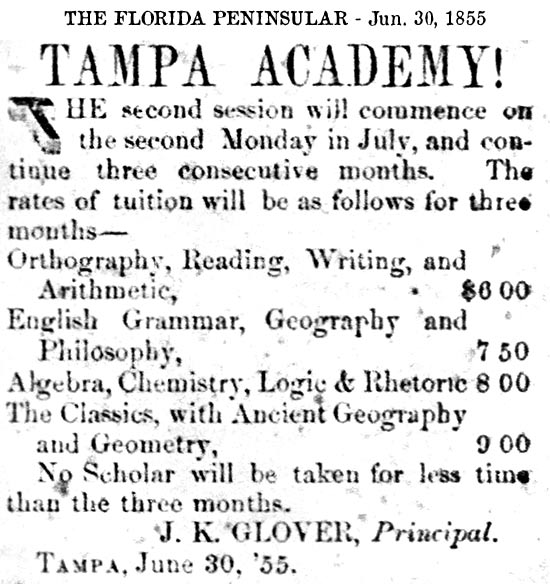 |

THE PERIOD OF THE THIRD SEMINOLE
WAR,
1855 to 1858
Interest in public education
decreased during the third Seminole
Indian War. The county contributed
some funds to the schools during
these years, but state funding was
allowed to accumulate. Most
teachers' salaries and school
expenses were provided totally
through tuition. In other districts,
teachers received $53 per year from
public funds, but also received
compensation from tuition. In
addition to poor pay, teachers were
faced with severe social and
behavioral restrictions. Reports
stated that teachers were not
permitted to go out on school
nights, nor were they permitted to
dance or play cards. Due to the
minimal pay, many teachers boarded
with families in their communities,
which further restricted the social
lives of the teachers.
|
|
During
the 1850s, it was difficult to
locate qualified teachers for these
new schools. For the most part,
individuals qualified to teach if
they could read and do basic
arithmetic. However, there were a
few exceptions of quality teachers
with good credentials. Francis
C. Boggess was remembered as an
outstanding schoolmaster who taught
at Alafia, Fort Dade, and Fort
Meade. W.P. Wilson, the
Englishman who founded the 1848
school at the courthouse, became so
popular that he later opened a
 private
school of higher studies known as
the "Wilson Academy." private
school of higher studies known as
the "Wilson Academy."
In
1857, Mary McAuley opened the "Tampa
School for Young Ladies" in the same
Masonic Lodge used earlier by J.K. Glover.
Also in Tampa.
|
|
JESSIE CARTER'S SCHOOL FOR GIRLS - 1858
Seminole
wars Gen. Jesse Carter built a schoolhouse in early 1858 on the west bank of the
Hillsborough River.
It's located on
what would become the
grounds of the Tampa Bay
Hotel, now the
University of Tampa. Some writers cite a circa
1855 date or even as early as 1850, but the
wording in an 1858
newspaper ad for the
school implies a Feb.
1858 completion date.
JESSE
CARTER
On January
25, 1849
Tampa
elected five
trustees in
what is
considered
Tampa's
first City
Council,
with M .G .
Sikes
serving as
president of
the
governing
body. The
trustees
were Thomas
P . Kennedy,
Jesse
Carter, C .A
. Ramsey,
and William
Ross; James
Gettis,
first town
clerk.
A
Florida native,
Jesse Carter
resided where
the University
of Tampa is now
located. He
served as a
State Militia
Colonel and
General in the
2nd Seminole
Indian war, as
well as
Florida's
special agent on
Indian affairs
to Gov. Broome.
In 1853,
Tampans were
able for the
first time to
travel north by
stagecoach, a
line being
established then
by Jesse Carter
who got the
contract for
bringing in the
mail from the
nor them part of
the state.
Carter's line
ended at
Gainesville
where
connections were
made with other
lines running to
St. Augustine,
Jacksonville and
Tallahassee.
(Grismer,
History of
Tampa)
Carter served
repeatedly in
the legislature
in Alachua
County. In 1850
he joined other
Freemasons in
creating
Hillsborough
Lodge No. 25, F.
& A. M. Charter
members
included, among
others, James T.
Magbee, Joseph
Moore, Jesse
Carter and M. L.
Shannahan.
Carter also
operated a
boarding house.
An advocate for
transportation,
he was elected
in October 1854
as Hillsborough
County’s
Democratic
representative
in the General
Assembly. The
railroad issue
was preeminent
to Carter. Carter
served as a
ferryman for
ferry service
across the
Hillsborough
River. He also
worked to
establish
schools in
Tampa, and had a
key role in the
construction of
Tampa’s first
school building
in 1858.
(Info from The
City Council of
Tampa, etc)
|
The beautiful
photos of the school below and of the markers &
plaques are from the
Historical Marker Database website.
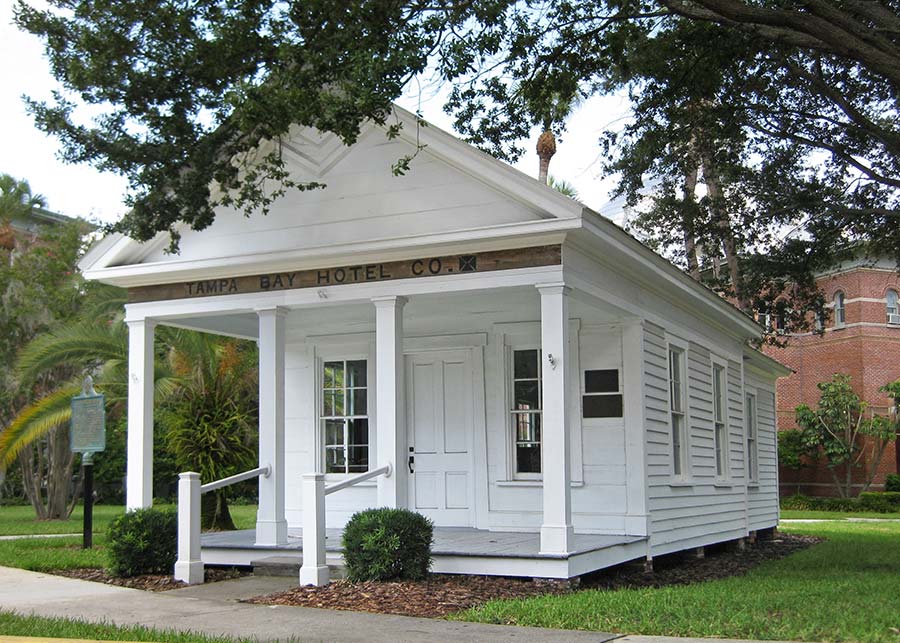
Photographer: AGS Media Taken: July 31, 2010
Caption: Old Schoolhouse and Marker. Submitted:
August 2, 2010, by Glenn Sheffield of Tampa,
Florida Photos from the
Historical Marker Database website
In the background is the University of Tampa's
Fletcher Hall. Originally at the Tampa Bay Hotel
this structure was a grand dining room.
Photographer: AGS Media Taken: July 31, 2010
Submitted:
August 2, 2010, by Glenn Sheffield of Tampa,
Florida
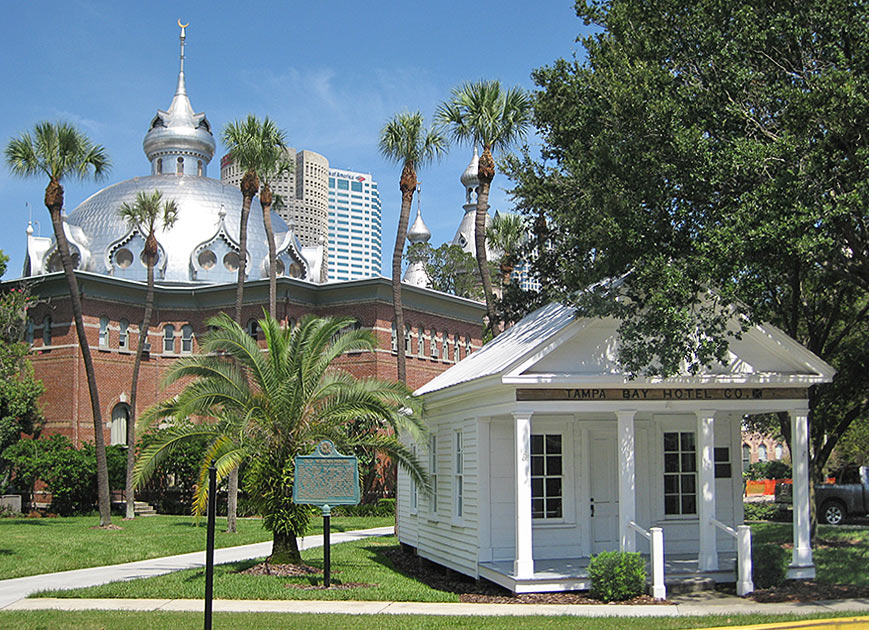
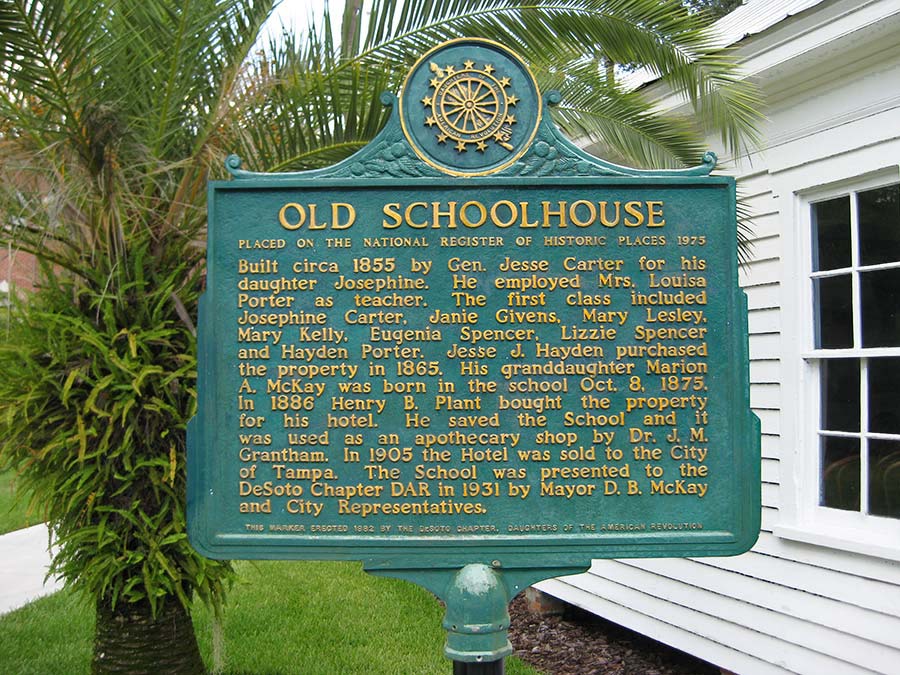
Although the
historic marker shows "circa 1855,"
the newspaper article below implies it was built in
1858.
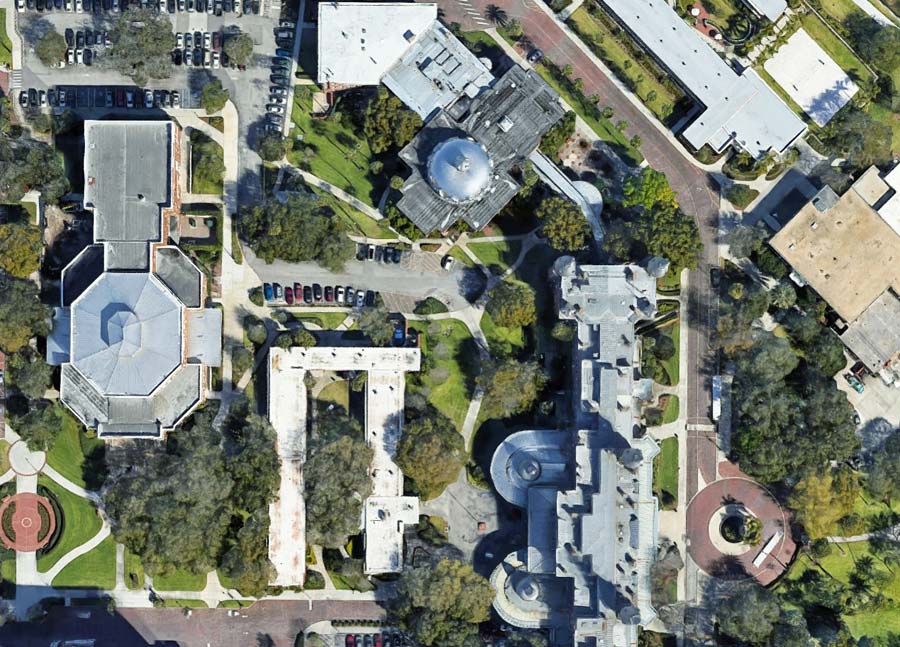
Place your cursor on the image to see where
Jesse Carter's schoolhouse is located.
|
JESSE CARTER'S SCHOOL FOR GIRLS AND
TEACHER
LOUISA PORTER
The
History of Hillsborough Co. Schools
and the
historical marker placed at the
school, state
that
General Carter built the school because he
intended to provide an education for his
daughter, Josephine.
To do this, he paid
for the construction
of a small, one-room
schoolhouse and
hired Mrs. Louisa
Porter, a teacher
from Key West.
Although this school
could be classified
as a "private
school," General
Carter opened the
school to the public
free of charge.
WHEN DID CARTER HIRE LOUISA PORTER
TO TEACH AT HIS SCHOOL?
Sources for this history don't
provide a date, but the impression
is given that it was simultaneous
with the opening of the school.
But was it?
Carter's first ad at right mentions
only, He has employed the
services of a lady to commence the
first of March, from the best
schools in Charleston, well
qualified to teach all the ordinary
branches of an English Education and
Music, who will also board in his
family.
Was
Louisa Porter from Charleston, or
was she educated in Charleston,
was she in Tampa by March 1, 1858,
and did she live in the Carter
household?
|
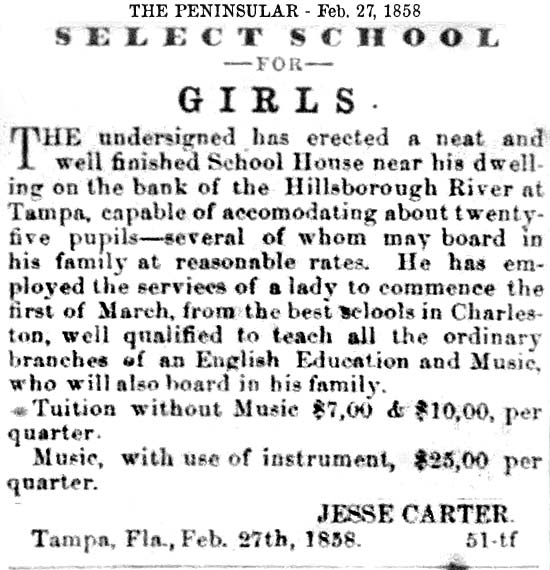 |
|
1850 U.S.
Census of
Jesse
Carter,
Tampa

Jesse was a
mail
contractor,
age 41.
His wife,
Ann M.
Carter was
from Geo.
age 35.
Here is
their
daughter,
Josephine,
age 4, for
whom sources
say he built
the school
in 1858.
Their
daughter,
Mary E.
Carter was 1
year old. |
Below
is from Very Much Attached to
Tampa, The Civil War Era
Letters of Catherine Campbell Hart, (Sunland
Tribune, Journal of the Tampa
Historical Society) and some info
from
Ossian Bingley Hart: Florida's
Loyalist Reconstruction Governor by
Prof. Canter Brown, Jr,
Kate’s (Catherine Hart's) letters
make numerous references to her
friend Lou. She had met Louisa
D. Browne in Key West during the
mid-to-late 1840s.
Louisa's life and those of her
children were closely tied to Kate &
Ossian Hart after the death of her
husband, John W. Porter.
|
|
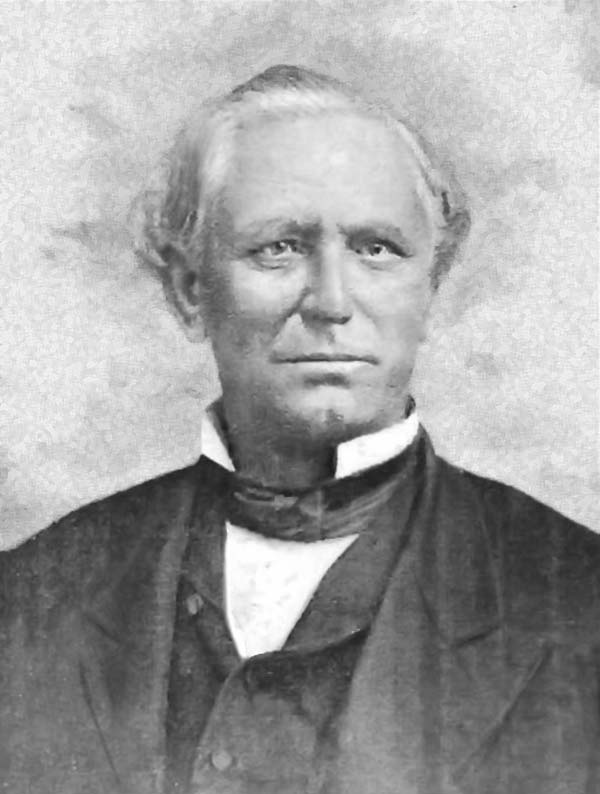
OSSIAN BINGLEY HART
Hart openly opposed
secession and as a
result endured many
hardships during the
Civil War.
After the war, he became
Florida's tenth governor,
Jan. 7, 1873 to Mar.
18, 1874.
He took an active part
in the reconstruction of
both Jacksonville's and
the state's government.
This image is a blended
composite of this
photograph and
this
painting.
When Ossian
and Catherine came to Key West,
Ossian became the port's
U.S. Customs collector. He also became friends
with Whig leader and merchant John W.
Porter. Ossian and John were of the
same age and became close friends, as also
would Kate Hart and Louisa Browne, John Porter's
wife.
Below, the marriage
record of Louisa D.
Browne to John W. Porter
at Key West, March 21,
1844.
Click the image to
see it full size.
|
CATHERINE "KATE" HART,
FRIEND OF LOUISA PORTER
Born at Newark, New Jersey in
1823, Catherine
"Kate" Campbell married Ossian B. Hart
in on Oct. 2, 1843
in Essex Co., New Jersey. Hart
was
a young lawyer and the second son of
Jacksonville’s founder Isaiah D.
Hart. Kate & Ossian had made each other’s
acquaintance when she sojourned
for her health in Hart’s
hometown of Jacksonville in 1841.
1850 U.S. Census, Duval
Co., Isaiah Hart family
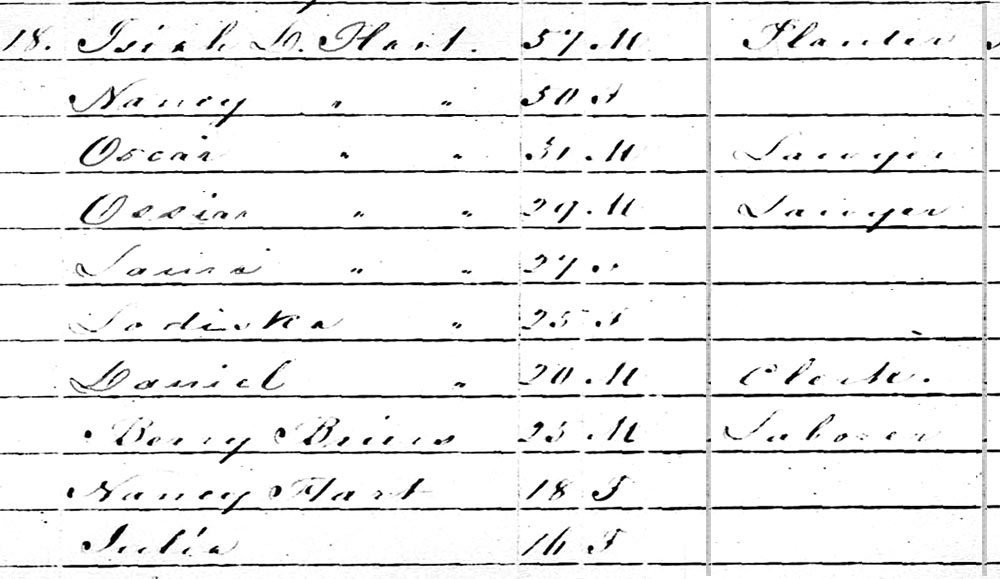
Ossian Hart is found in
Jacksonville on the 1850
Census, living with his
parents Isaiah & Nancy
Hart, and
siblings, but not with
his wife Catherine.
Ossian was probably only
in Jacksonville visiting
for a short while and
his wife probably stayed
home in Key West at this
time.
Ossian and his older
brother Oscar were both
lawyers.
Below:
1850 Census of Monroe
Co, Key West, John W.
Porter family
John W. Porter was
29, a merchant born in
SC. Louisa was 22,
b. in Fla. Their
daughter Ann (Hayden)
Porter was 5.
Listed just above the
Porters is a merchant
named F. A. Browne who
appears to be 54 or 34,
born in Virginia, and an
8 year old male
B---- Browne born in
Florida. They may
be related to Louisa
Browne Porter.
|
|
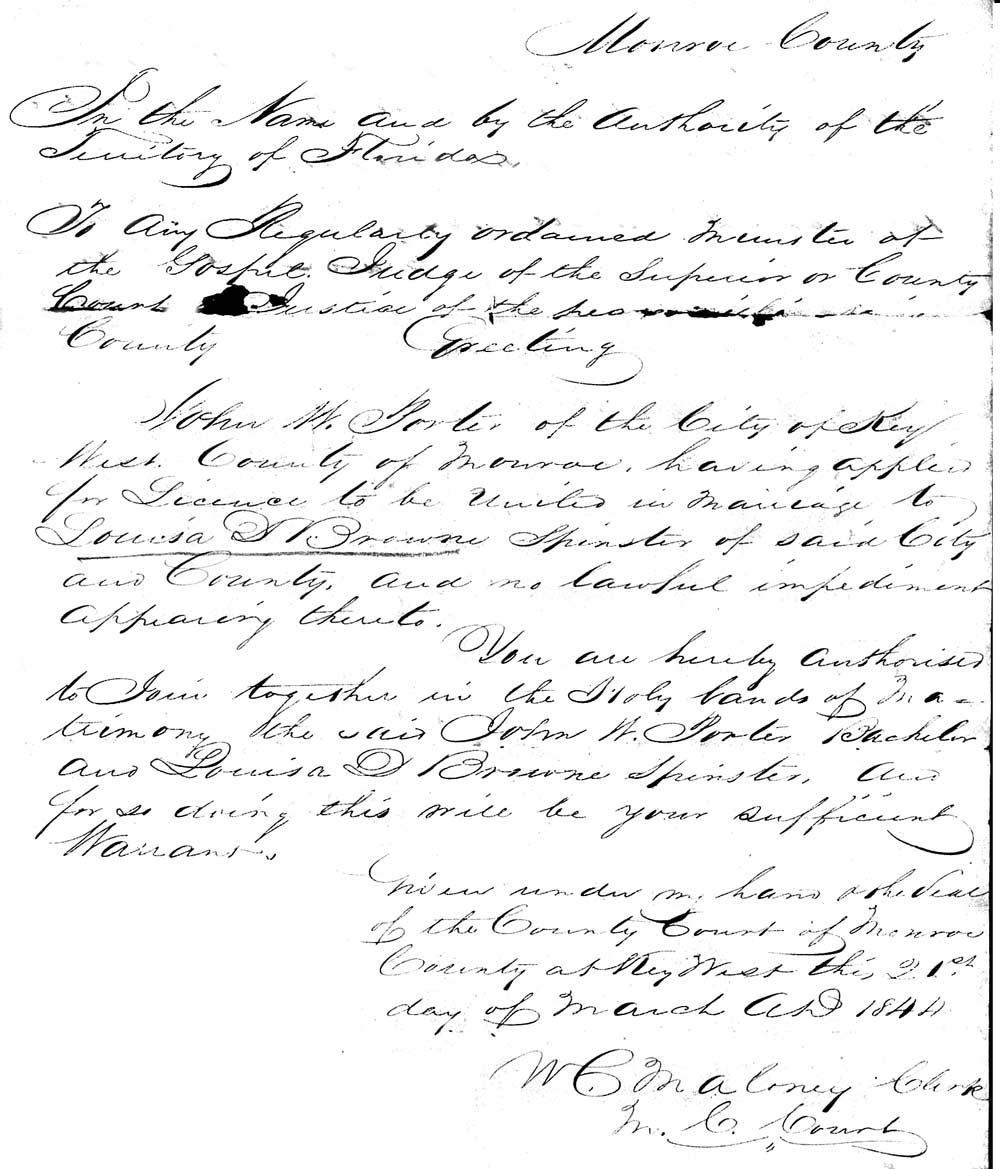 |
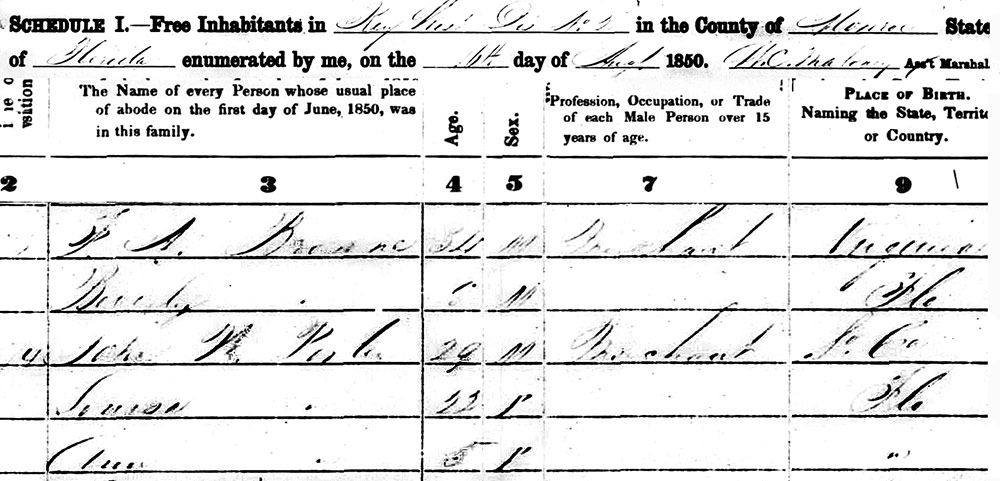
|
|
In 1853-1854 John Porter held office as Key West’s
mayor, but in
Dec. 1854, Porter was voted out
of the Mayor's office. He
died in late 1856,
leaving Louisa destitute, with
two young children.
|
|
Apparently, the Harts
took in Louisa and her
children, and the two
families would be
closely associated for
the next 10 to 15 years.
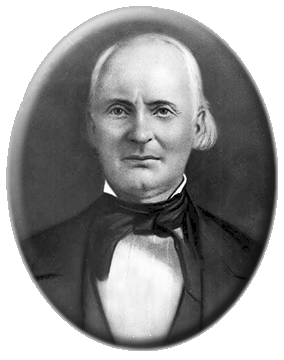
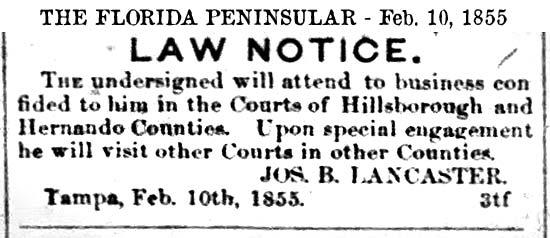 On
Nov. 25, 1856, Ossian’s
longtime mentor, the City of Tampa's first
mayor and former circuit judge
Joseph B. Lancaster, died while
in office as Tampa's first mayor. In
these circumstances, the Harts,
along with the Porters, came to Tampa
where Ossian assumed Lancaster’s
law practice. After a
short time in temporary
quarters, they purchased a home
on the northeast corner of
what was Lafayette (now Kennedy) and
Pierce Streets. On
Nov. 25, 1856, Ossian’s
longtime mentor, the City of Tampa's first
mayor and former circuit judge
Joseph B. Lancaster, died while
in office as Tampa's first mayor. In
these circumstances, the Harts,
along with the Porters, came to Tampa
where Ossian assumed Lancaster’s
law practice. After a
short time in temporary
quarters, they purchased a home
on the northeast corner of
what was Lafayette (now Kennedy) and
Pierce Streets.
THE DEATH OF MAYOR LANCASTER,
THE CITY OF TAMPA'S FIRST MAYOR
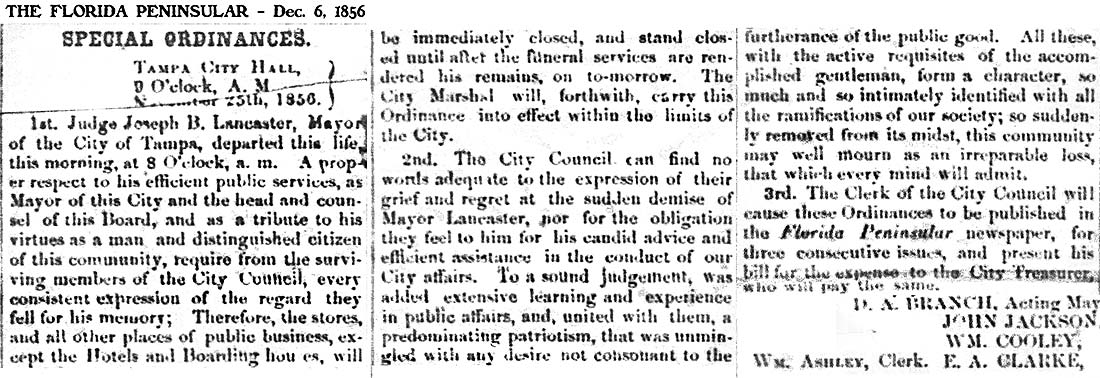
WHEN DID THE HARTS AND PORTERS
COME TO TAMPA?
A look at Ossian Hart's
advertising in Tampa
|
Dec 20, 1856 -
Hart's first ad in
the Fla. Peninsular
which appeared in
EVERY issue for 1 year mentions
practice in two
districts -- Will continue in
Southern, visit part
of Eastern Circuit.
All ads for the year
were on page 1, left
column, and varied
as the 2nd
ad to 4th ad,
usually 2nd ad.
Hart's last ad found
in the Peninsular
mentioning both
districts was on
Nov. 19, 1857
|
Jan. 2, 1858 - His ad no longer mentions both
districts, now reads in the
Courts of the State, and of the
United States. First
placed Dec. 26, 1857.
Dec. 1857 paper
missing. |
|
-PENINSULAR-Ossian-Hart-atty-ad-tampa.jpg) |
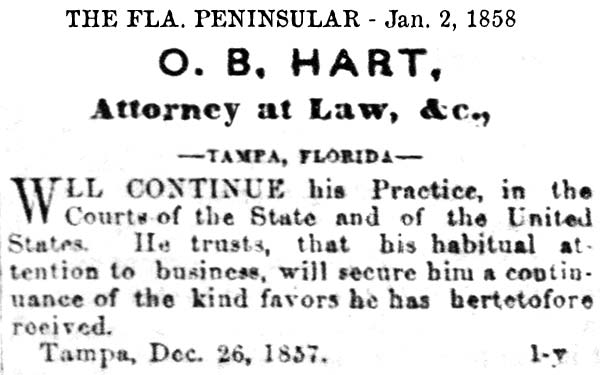 |
|
It
appears they came as
early as December
1856. |
MORE ADS BY
CARTER FOR HIS
FEMALE SCHOOL
Jesse
Carter's ad on Feb.
12, 1859, Saturday,
announced school would
start "Monday, the 13th
Inst"* (but Monday would
be the 14th.)
The school room is
very comfortable,
having a good
fireplace and
furnished with
comfortable seats,
desks, etc., and
each pupil will be
furnished; by the
undersigned, with
all necessary books,
stationery, slates,
pencils, etc.
Parents and
guardians will be
charged for all
books destroyed or
improperly damaged.
Carter repeats the same
ad verbatim on Dec. 9,
1858 (seen below), even
stating again that
school starts Monday,
the 13th Inst.
Only Mrs. Voorhees is
mentioned as teacher.
|
|
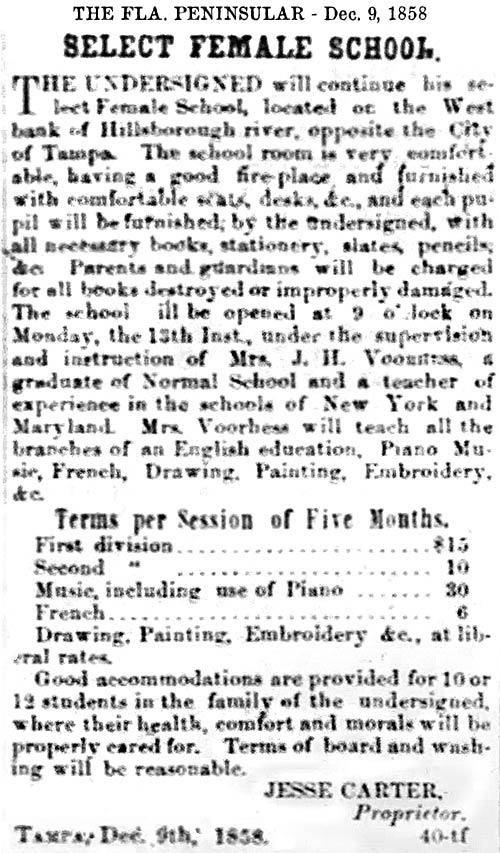
At Right:
The Aug. 15, 1859 article below
about "Mrs. Porter's
Female School" doesn't
mention the school's
location but Louisa
Porter was most likely
in Tampa by early 1857.
It doesn't seem likely
that the Peninsular
would write such a
review of Carter's
school and not mention
him at all.
Catherine Hart's mention
of Lou's school in her
Feb. 8, 1860 letter:
"her school is in a
flourishing condition
and her prospects very
flattering for the
future"
Some
of the students initially enrolled
in Jesse Carter's school went on to
marry influential members of the
Tampa community.
According to an
account by Anthony Pizzo in Special
Collections of the USF library, the
first enrollment at General Carter's
school was recorded as:
Miss Josephine
Carter (daughter of General Carter),
Miss Eugenia Spencer (married to become Mrs. H.L.
Mitchell),
Miss Lizzie Spencer (married to W.P. Henderson,
future superintendent),
Miss Mary Lesley (married to become Mrs. U. S.
Bird),
Miss Mary Jane McCarty (married Captain John
Angus McKay)
Hayden Porter (who would have been around 12
years old)
The historical
marker adds as first students Janie Givens and
Mary Kelly.
Thus far, historic
resources mentioning
Louisa Porter
teaching a school
don't mention Jesse
Carter or where
Louisa taught.
Ads by Jesse
Carter don't mention
Louisa Porter but
instead mention a
Mrs. J. H. Voorhees.
Also, Louisa's
marriage in Key West
at a young age, with
her whereabouts
known to be in Key
West the whole time
since her marriage
there (1844), pretty
much excludes her
from being the
teacher from
Charleston first
advertised in
Carter's opening
announcement for his
school in Feb. 1858.
So what would Louisa
Porter have being
doing in Tampa to
earn a living from
the time she arrived
in late Dec. 1856,
or at latest, Jan
1857, to Aug. of
1859 when the
article at right was
published?
See her 1860 census
below.
|
The same ad repeated
again on May 21,
1859, Saturday,
announcing the same
starting date,
"Monday, the 13th
Inst" which would be
next month, Monday,
June 13th.
Each mentioned Mrs.
Voorhees was the
teacher, and that
she was a teacher of
experience in the
schools of New York
and Maryland.
She does not
appear to be the
same teacher spoken
of in his first ad,
who was from
Charleston. Each
referred to the
school as being
Jesse Carter's.
This ad doesn't
indicate where Mrs.
Voorhees was
boarding, instead,
it offers students
boarding at the
Carter home.
*"Inst" was an
abbreviation for
"Instant" meaning the
very next occurrence of
the date given.
REFERENCES TO LOUISA PORTER IN
KATE HART'S LETTERS OF 1860
Notice that Kate Hart
refers to the school as being Louisa's school,
with no mention of Carter.
Tampa, Feb. 8, 1860, to her sister Charlotte "Lottie"
-
Kate writes about possibly going home (Newark)
to visit her sister Lottie next summer, but then gives various
reasons why it wouldn't be a good idea.
...and then there is Lou and her children, if I
were gone she would not think it exactly proper
to stay here alone with Ossian, and if she left
here she would find much trouble to get as
comfortable a boarding house and as cheap as we
have been doing... Lou has been suffering with a
very severe cold in her head, but is better now;
her school is in a flourishing condition and her
prospects very flattering for the future.
We also have a glee club composed of all the
principal ladies and gents of the town.
Lou and I are members and enjoy going very much,
and as the object of the society is the
improvement of our vocal powers, we are more or
less benefited by it.
Tampa, Sept. 14, 1860 to her sister Lottie.
Lou is now enjoying her vacation and will commence
teaching again the first of October, her health
is very delicate. the children are well.
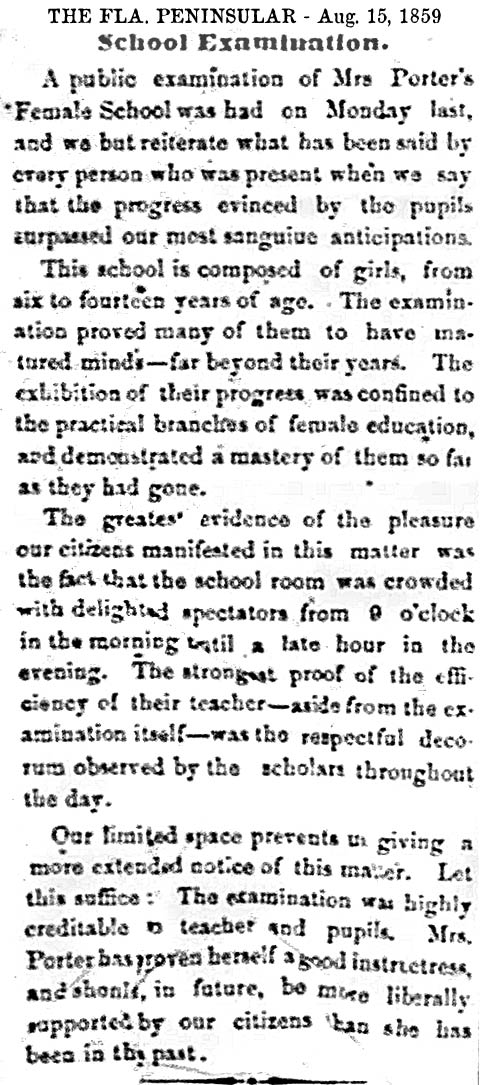
|
|
1860 U.S.
Census of the Hart and Porter
families, Tampa

The 1860 census in Tampa shows
Louisa Porter and her children
Hayden and Mary Porter living
with Ossian Hart, wife Catherine
and their daughter Inez.
Louisa's occupation was "School
mistress." Louisa's age here is
not too far off. She
married in 1844 and according to
her 1850 census, she was born
around 1826, making her approx.
18 at marriage. If she was
really 30 in 1860, she would
have been 14 when she married
and 16 when she had her daughter
Hayden (Anna Hayden Porter).
1860 U.S. Census of Jesse Carter

On this census, Carter was 50
and working as a registrar for
public land records. His
wife Ann was 44, and
Josephine was now 13.
Missing her is the Carter's
daughter Mary E. who was 1 in
1850. Perhaps she had died
in between the censuses. A
seamstress was living with the
Carters, and the next two
households visited by the
enumerator were unoccupied.
This is rarely seen on a census,
because most enumerators will as
a neighbor if they could provide
some information on those nearby
who weren't at home. On
the next census page are seven
dwellings listed as unoccupied.
CIVIL WAR
On January 10, 1861, Florida became the third state
to secede from the Union ushering in the beginning
of the Civil War. During The Civil War years, there
was no mention of the schools in the records of the
County Commission. It is thought that most schools
closed during these years. Those that remained open
operated on a minimal budget with funds provided
completely through tuition. According to historian
Canter Brown, even W.P. Wilson had to plead with
parents for tuition payments.
Louisa Porter also
contemplated closing the school erected by Jessie
Carter. A wealthy Tampa attorney,
Ossian Hart, persuaded Miss Porter to stay during
the war and paid her $400 a year. However, it is
believed that Miss Porter departed from Tampa at the
end of 1865 and left the town without any schools
for a brief period of time.
1870
Census of Duval Co.,
Jacksonville
The Porter family

By this
time the Harts and
Porters had moved
to Jacksonville,
Ossian's hometown.
The period during the
Civil War was extremely
difficult for the Harts,
being Unionists.
His hometown would have been somewhat
more welcoming than
Tampa. Notice
Louisa is now 42, having
been 30 just ten years
earlier on her 1860
census. Hayden
Porter of the 1860
census would be 24 in
1870, here is Anna
(Hayden) Porter age
24, and working as a
school teacher.
Louisa's age here puts
her birth year at about
1827-28 and puts her
marriage age at about 16
to 17.
Annie
Hayden Porter
Burial
1915 Place:
Jacksonville, Duval,
Florida
Birth Date: 16 Nov
1845
Death Date: 23 Jan 1915
Old Jacksonville City
Cemetery
Was
Louisa Porter from Charleston?
No, every census
shows Florida.
Was she educated in Charleston
as Carter's ad stated
his teacher was?
It's doubtful she
had much if any formal, higher
education. Born
circa 1827-30 in Fla.,
she married Key West
merchant John Porter at
around age 16 to 18 in
1844. Rather
quickly, she had her
first child Anna Hayden
Porter. Five years
later, she had Mary.
No time for college
here, with two infants.
John died late 1856,
leaving her destitute.
No time, not much income
for a college education.
Same year, the Porters
came to Tampa with the
Harts. Mrs. Hart's
letters home to her
sister mention Lou
teaching a school in
Tampa. They leave
Tampa at the time of the
Civil War and settle in
Hart's home town of JAX.
Answer: No.
Was she in Tampa by
Mar. 1, 1858 when Carter
opened his school? Yes.
It appears she came with
the Harts in late 1856.
Did she live with the
Carter family as
Carter's ad stated his
teacher from Charleston
was doing? No,
at least not by the 1860
census in Tampa, she
seemed to always live
with the Harts after
her husband died.
Did any of the ads
for the girls school
that Carter built
mention Louisa?
No. They mention
an unnamed teacher from
Charleston, then a Mrs.
Voorhees with experience
in schools of New York
and Maryland.
Is there any evidence
that Louisa ever taught
at a school?
Yes, one of Katherine
Hart's letters home to
her sister mentions
"her school is in a flourishing condition and her
prospects very flattering for the future."
Another of Kate Hart's
letters to her family in
Newark in Sept. 1860
says
Lou is now enjoying her vacation and will commence
teaching again the first of October, her health
is very delicate. the children are well.
Also, an
Aug 15, 1859 article in
the Peninsular gave an
impressive review of
Louisa's school, but it
doesn't mention where it
is nor does it mention
who built and started
the school. Take
notice that this is only
about a year and a half
after Jesse's school
opened, and his ads ran
for 40 issues of the
Tuesday & Friday
Peninsulars.
|
|
SCHOOLS SCATTERED AROUND THE COUNTY, MEETING IN
PRIVATE HOMES OR BUILDINGS
Throughout this
period, population directly determined the need
for public school in the most rural areas of the
county. In the early 1860s, it was estimated
that there were only 867 "schoolable children"
throughout the county. It was required that an
area had at least 10 children of school age
before a school could officially be sanctioned
in that area.
The County Commission did not own
any school buildings specifically designed for
instruction. All buildings used for
schools were owned and constructed by private
citizens to serve as schools in their
neighborhoods. Although the schools were
private, most were open to other children in the
immediate area who wanted to attend. Some of the
earliest construction of one-room schools
originated in areas of present-day eastern
Hillsborough County. Early pioneers in the Plant
City area such as George Hamilton, Elijah Byrd
Sparkman, and Joseph Casey were believed to have
opened schools as early as the late 1860s. Both
Sparkman and Casey later petitioned the Board of
Education and were sanctioned as schools #5 and
#7 respectively. As in Tampa, some early rural
schools were also held in churches or other
public buildings such as churches.
|
|
|
|
This ad
below
for a boys school at "Mr. Petty's
School House" was offered by W. P.
Wilson. His school had primary
level classes as well as higher
classes for English, Greek, Latin,
French, and a business course in
stenography.
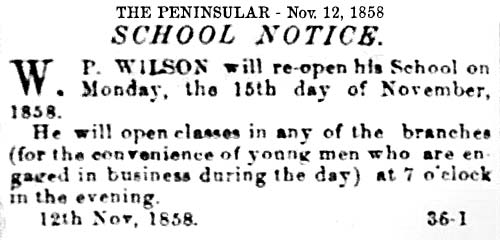
Wilson offered primary and high
school courses located in
Mrs. Petty's school house.
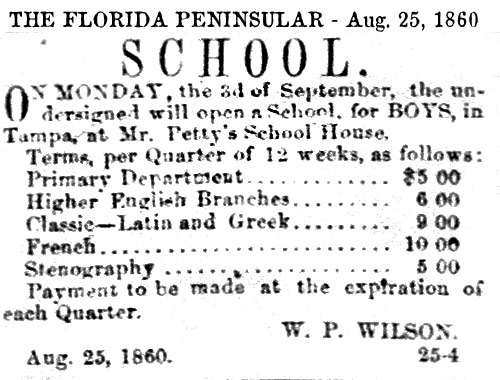 |
Below, Mr. Wm. P. Wilson offers
a night school in his
home, for young
men.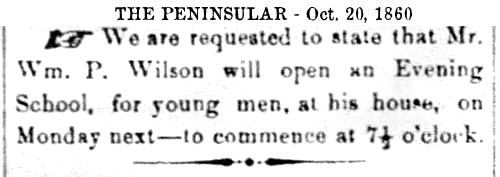
The
legal notice below is the last we
hear of Mr. Wilson in the Tampa
newspapers. Mary Wilson was his wife,
according to his 1860
census record, and it appears
Mr. Wilson has been made the
administrator of her estate. "The
History of Hillsborough County
Schools" states that he moved to
Mango to open a private school there
in 1858.
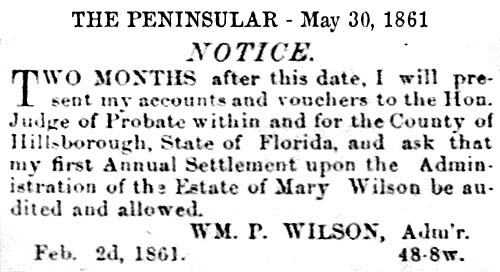 |
|
|
|
|
HAYDEN'S
FERRY CROSSING AT
JACKSON STREET
Students living in Tampa
would have taken the
ferry to get to Carter's
school house.
FERRY
CROSSINGS
BEFORE
HAYDEN -
1846: The
earliest
existing
records of
Hillsborough
Co.
Commissioner
meetings
History
of
Hillsborough
County,
Florida, Narrative
and
Biographical,
1928" by
Ernest L.
Robinson,
Director of
High Schools
of
Hillsborough
County,
Formerly
Principal
of Hillsborough
County High
School.
1846 -
Jan. 5: The
board
members, the
lost book of
1845, pay
and taxes
The first
meeting (for
which
records
still exist)
of the
Hillsborough
County
Commissioners
was held.
The board
consisted of
William
Hancock, M.C.
Brown,
Benjamin
Moody, Simon
Turman, and
James A.
Goff (not
present).
Simon Turman
was Judge of
Probate and
President of
the Board.
At this
meeting, a
small record
book of the
previous
year's
proceedings
was turned
over to the
board by
Manuel
Avilla,
former Clerk
of the
County
Court. This
book has
never been
found. Also
at this
meeting, pay
was
established
for the
board at $2
per day
while in
session.
The county
tax for 1846
was
established
at 50% of
the amount
assessed for
the State.
S.L.
Sparkman was
the tax
assessor and
John parker
the tax
collector. |
|
1846 -
April 7:
Treasury
balance,
build a
courthouse
At this
meeting,
Thomas P.
Kennedy was
the
Treasurer of
the County
and reported
the balance
to be
$267.63. The
commissioners
were
appointed to
"superintend
the building
of a court
house and
other public
buildings in
the Village
of Tampa"
and
instructed
to "select
the spot of
ground for
the said
public
buildings,
make a plan
to start the
building and
finish them
as soon as
practicable
taking into
consideration
the funds on
hand..."
|
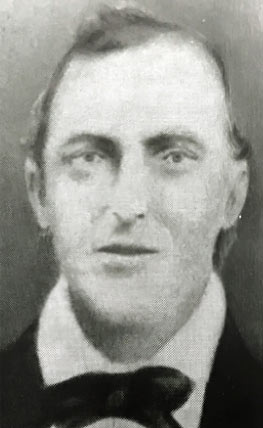
|
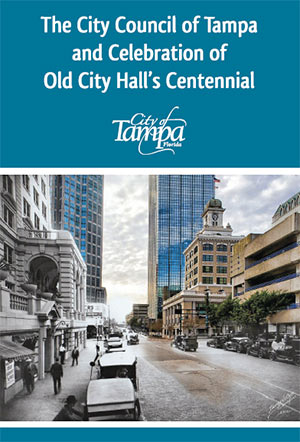 THOMAS PUGH KENNEDY - Tampa City Council member THOMAS PUGH KENNEDY - Tampa City Council member
January 1849 – October 1850
M.G. Sikes, President
Jesse Carter
Thomas Pugh Kennedy
Culbreath A. Ramsey
William Ross
Born in Philadelphia on December 12, 1812, Thomas Pugh Kennedy moved to St. Augustine in 1828. He came to Fort Brooke in December of 1840 as a deputy U.S. Marshal. In 1843, he established a store at Tampa and Whiting Streets and traded with the Seminoles.
Photo and info from The City Council of Tampa, etc. |
| At the end of the First Seminole War, he purchased a schooner and engaged in trade with Central and South America. He served as Fort Brooke's Indian agent and was elected as the first Hillsborough County Treasurer in 1845 and took office in January of 1846. In 1848, he opened the Kennedy & Darling General Store, once the largest such store in South Florida, with future council member John Darling. He died in 1858. |
|
|
1846 -
May 23:
Establish a
ferry, build
a road
At this
meeting,
Thomas Piper
was
granted "the
privilege of
establishing
a ferry
across the
Hillsborough
River at
Tampa." The
grant was to
last four
years and he
was to pay
five dollars
per year for
the last
three
years. The
ferry fees
were fixed
at five
cents per
man and
proportionately
higher for
vehicles. A
road was
authorized
to be
extended as
well. |
|
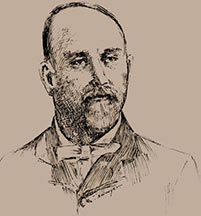
By James McKay, Jr. in "Reminiscences - History of Tampa in the Olden Days" Dec. 18, 1923
In 1852 we opened a ferry at the foot of Jackson street, so as to cross the stage with the mail. It was also used by the public. Ponds that were located on the east end of Jackson street caused the city officials as well as the people, considerable annoyance, especially during the rainy season. One of these ponds at the corner of Jackson and Marion street would take in all four corners and prevent pedestrians from passing in that direction. I have skated rocks over ice on this pond when it was frozen over during the winter.
The authorities dug a ditch in the center of Jackson street to drain these ponds, and in some places it was 12 feet deep. Across Franklin and Tampa streets small bridges were placed so as to permit passage of teams and the public. This did not accomplish what was desired so the ponds were filled in later on. 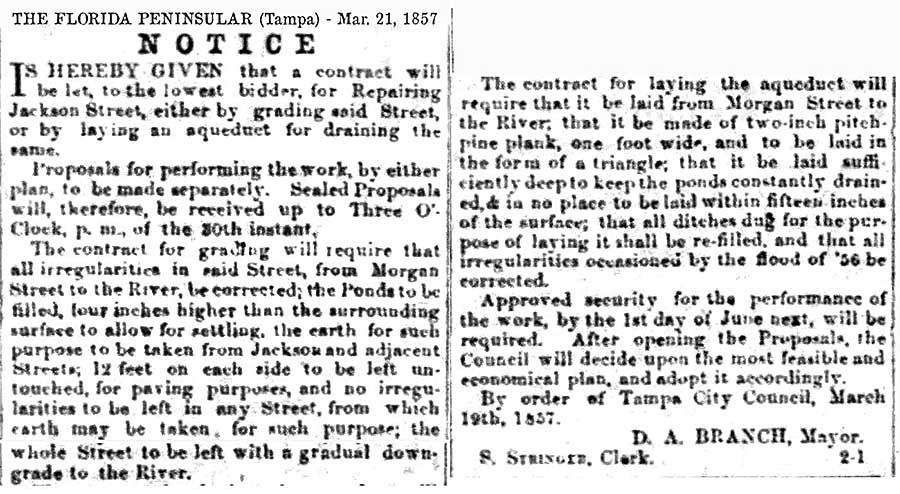
|
|
|
CARTER SELLS HIS LAND,
THE HAYDENS ARRIVE
In 1860, perhaps due to
the imminent secession
of Florida from the
Union and Civil War
looming, Jesse Carter
put up for sale his 800
acres of land in
Hillsborough Co. and 250
acres in Hernando Co. as
well as his improved
land 3½
miles north of Tampa and
the land on which he
currently resided, on
the west bank of the
Hillsborough River,
opposite the City of
Tampa.
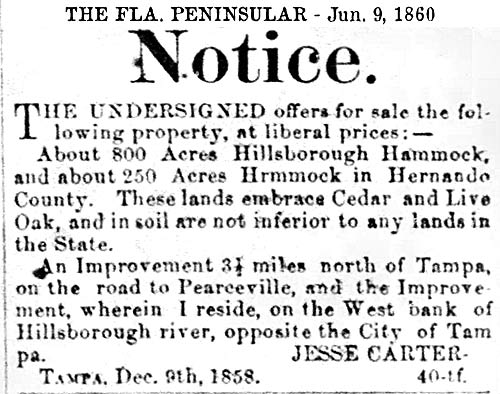
The Haydens came to
Tampa in 1866 and soon
thereafter Jesse J. Hayden
bought some of Carter's
land where the school
was located and filed a
homestead claim for the
adjoining 60 acres. In
those years, the area
was known as Spanishtown
Creek. This was before
Obadiah Platt purchased
land here and created
Hyde Park.
Jesse's granddaughter
Marion A. McKay was born
in the school Oct. 8,
1875. In 1886 Henry B.
Plant bought the
property for his hotel.
He saved the School and
it was used as an
apothecary shop by Dr.
J. M. Grantham. In 1905
the Hotel was sold to
the City of Tampa. The
School was presented to
the DeSoto Chapter DAR
in 1931 by Mayor D. B.
McKay and City
Representatives. Jesse
and Susan’s daughter
Mattie married Donald S.
MacKay, son of sea
captain James McKay,
Sr., and later uncle of
Tampa mayor D.B. McKay.
The Jacksons and the
Haydens were among the
prominent families of
Old Tampa, and along
with the Haskins, owned
most of what would later
become Hyde Park. The
Haskins family, however,
sold their land before
Hyde Park was developed
because of the
inconvenience of
crossing the river with
children. H. B. Plant
later bought fifteen
acres on the west side
of the Hillsborough
River from the Hayden
family and in July 1888,
the Tampa Bay Hotel’s
cornerstone was laid.
|
The 1882
land
ownership
map below,
from the
Library of
Congress,
has been
enhanced
with color
to show
(yellow)
Jesse
Hayden's
property
where he
operated his
ferry.
The map was
drawn
showing
"Ferry" at
that
location.
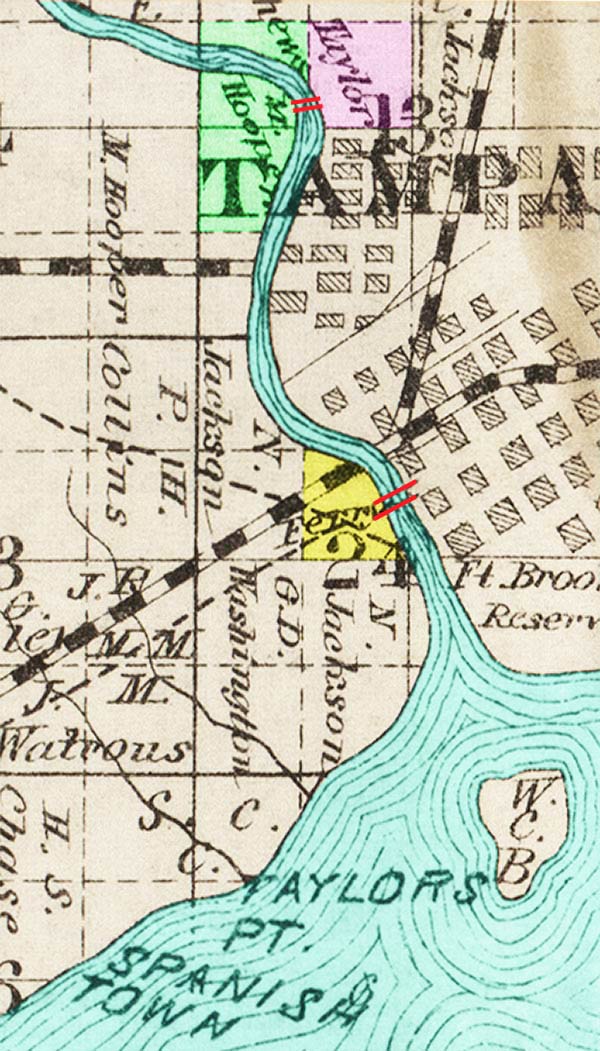
Further
north can be
seen where
Matthew
Hooper
operated his
ferry from
the west
bank of the
river.
Madam
Fortune
Taylor owned
the land on
the other
side, and
this later
became the
site of
Fortune
Street and
the bridge,
now named
the Fortune
Taylor
bridge in
her honor. |
|
TAMPA
CHARTERS
HAYDEN'S
FERRY
In March
1885, the
Tampa town
council
chartered
Hayden’s
ferry
crossing on
the river at
Jackson
Street,
stipulating
that "the
lessee of
any such
ferry shall
keep a good
ferry, flat,
capable of
ferrying
over safely
a six-mule
team and a
wagon loaded
with not
more than
5,000 pounds
weight,
stock
animals, and
goods across
the
Hillsborough,
and two good
skiff boats
for crossing
foot-passengers...He
shall put
across all
persons and
their
property at
any hour of
day or
night...After
9 o'clock
P.M. he may
charge
double
ferriage."
Hayden had
the right to
operate a
ferry, but
Tampa
reserved the
right to
build a
bridge
across the
river, free
or
otherwise.
The town was
growing.
Soon after
the railroad
arrived,
public and
private
interest in
a bridge
increased.
The
completion
of the
first
Lafayette
St. bridge
in 1889
would soon
put an end
to Hayden's
ferry
service.
|
|
|
The photo below shows a
ferry crossing the
Hillsborough River.
The source doesn't give
the specific location
along the river and
provides very wide date
range of 1850 - 1930.
From the ROBERT N.
DENNIS COLLECTION OF
STEREOSCOPIC VIEWS (filtered
for Tampa) at The
New York Public
Library Digital
Collections.
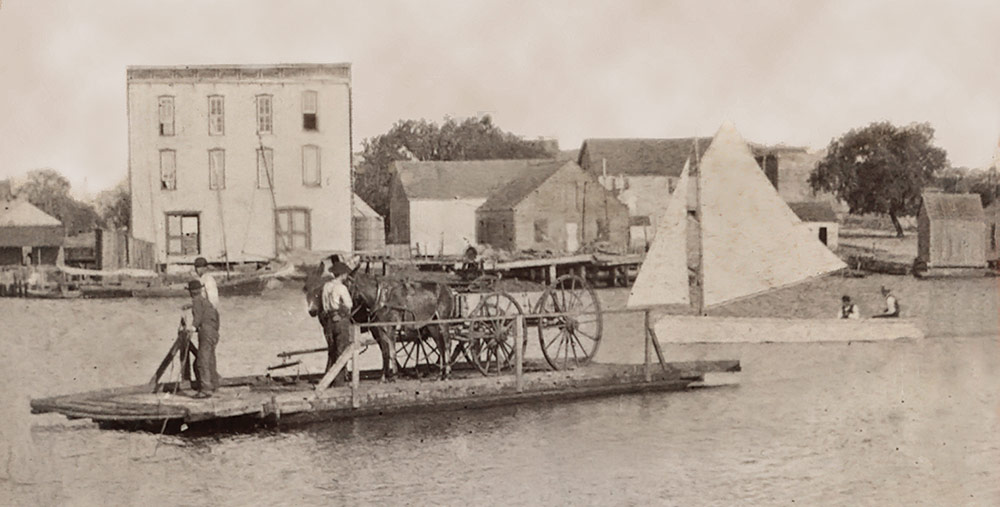
The photo can be proven
to be a view of Hayden's
ferry crossing as seen
from the Hyde Park side
facing east looking at
the Tampa riverbank.
The photo
below is
from the
State
Archives
Florida
Memory
collection
and shows
the same
buildings
from a wider
view and the
same vantage
point from
across the
river.
Notice the
same 3-story
wood-frame
building at
the right of
the photo,
once again
viewed
directly
face-on.
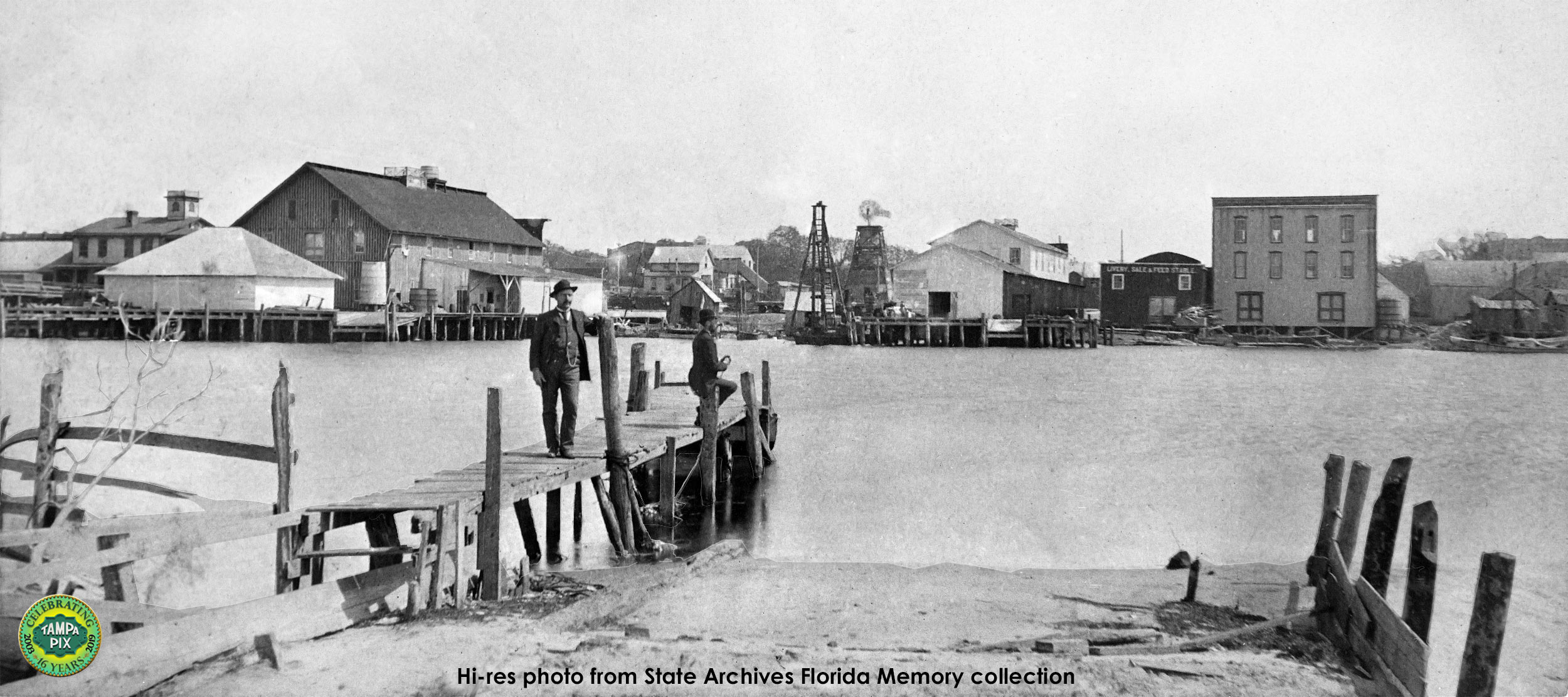
This
photo was most likely
taken sometime from 1890
to 1891. See the
1889 Sanborn map below
for explanation.
|
|
The photo at
right shows
a boy
sitting at a
pier on the
east bank of
the
Hillsborough
River,
facing town.
In the
background
can be seen
Hayden's
ferry
nearing
shore with a
horse and
carriage.
The grassy
islands
which became
Davis
Islands in
1925 are on
the horizon.
Image from
"Tampa Town,
1825 - 1886:
A Cracker
Village With
A Latin
Accent" by
Tony Pizzo,
1968
Proof of
which side
of the river
is being
viewed in
the above
photos can
be found on
this 1889
Sanborn map
below from
the
University
of Florida
digital maps
collection.
Notice the
3-story
wood-frame
building
(#10) is
a
warehouse/carriage
house.
The large
building at
the far left
of the State
Archives
photo above
is the Tampa
Commercial
Co.
warehouse
seen on Pier
No. 2 at the
map below as
#3 and #4.
Hayden's
ferry dock
can be seen
below just
above the
red arrow
|
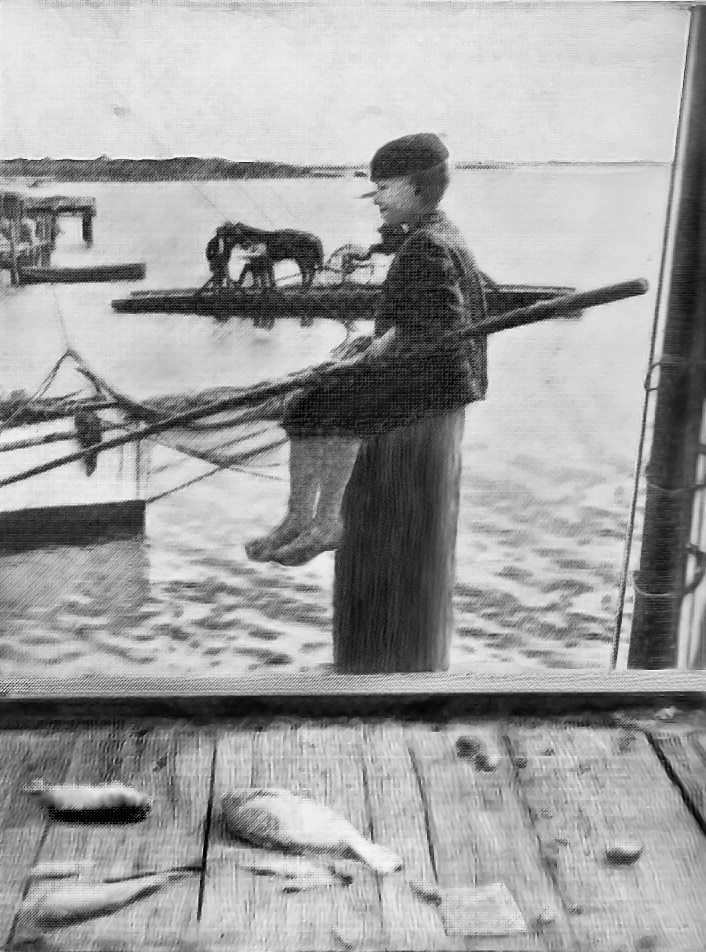 |
|
| |
|
| The 1887 map of this area clearly shows Hayden's ferry dock on the north side of the Jackson St. ditch, which emptied into the river between the dock and the 3-story warehouse. |
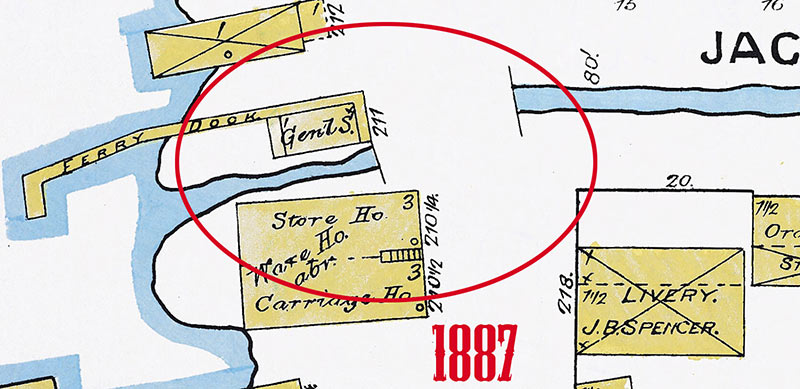
|
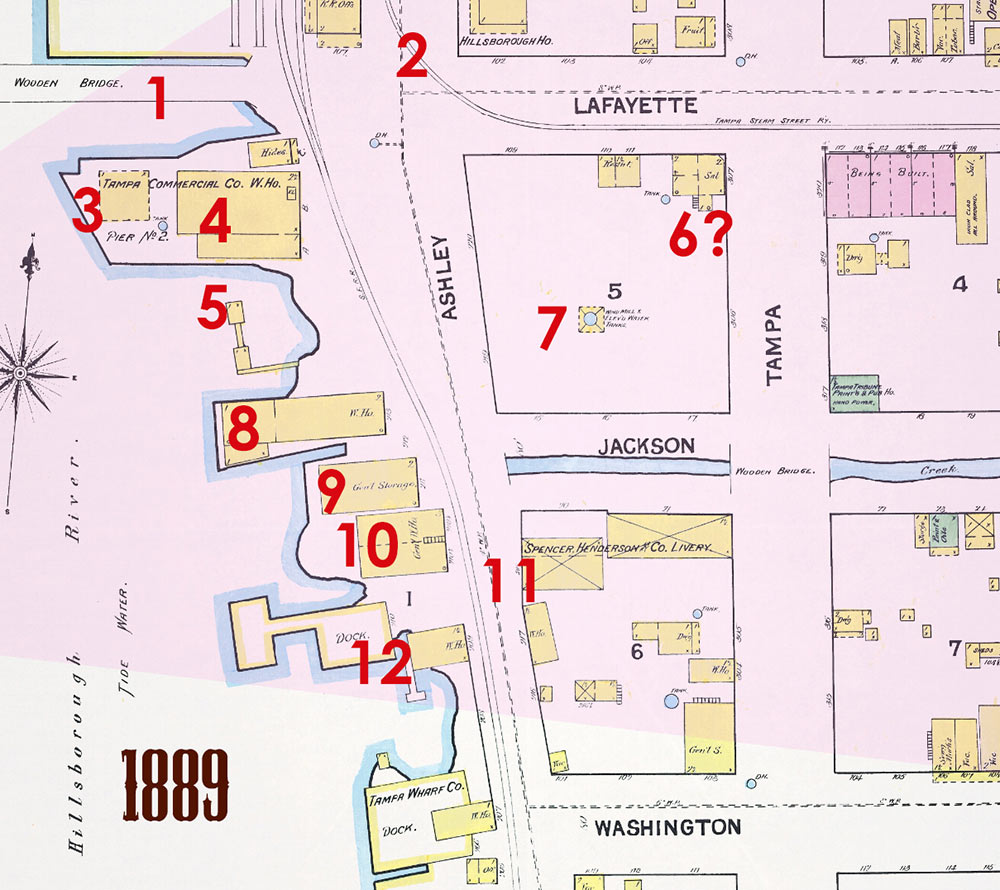 |
|
On the 1889 map above, the dock is no longer shown, the ditch drainage has been routed underground at Ashley St. and another general storage warehouse (#9) has been built where the ferry dock was located. This map most closely portrays this area as compared to the photo below.
PLACE YOUR CURSOR ON THE PHOTO BELOW TO SEE A CLOSE UP OF THE FERRY DOCK AREA. |
|
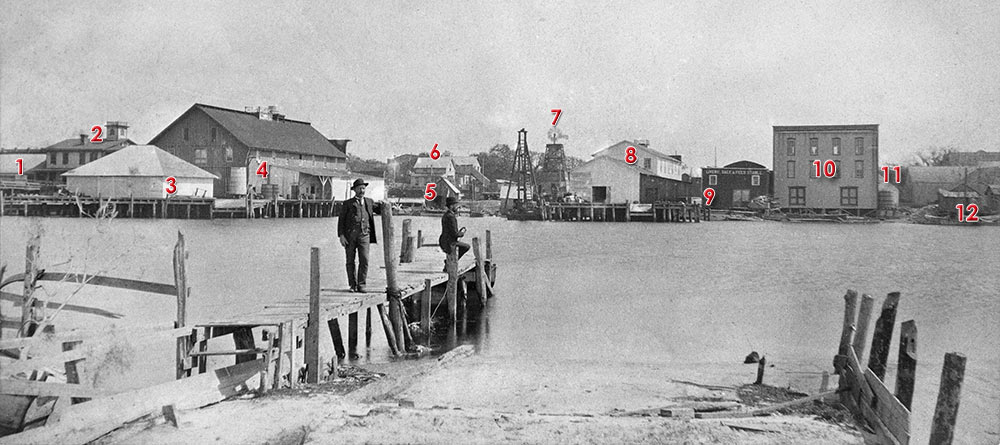
In the photo, the new warehouse at #9 has become a "LIVERY, SALE & FEED STABLE." If it was a stable on the map it would have been marked with diagonals from the corners, an X. This is a possible sign that the photo dates from 1890 - 1892.
|
At #1 can be seen the approach to the new wooden Lafayette St. bridge, which was opened in March 1889.
|
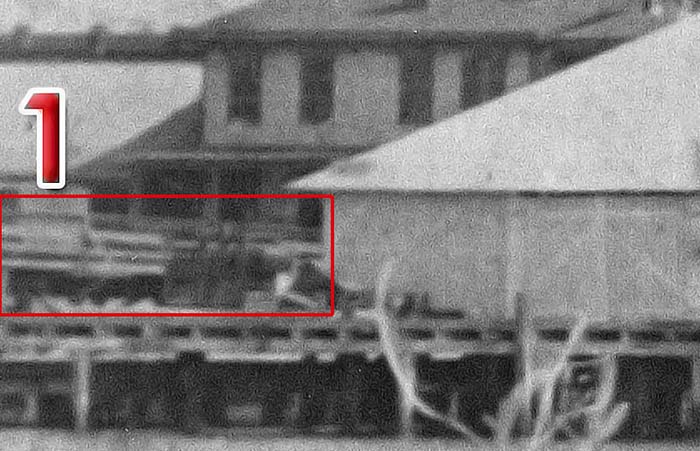 |
|
These two
images below
show the
same area of
Tampa's
riverfront
taken on the
Tampa side
around the
same time,
circa 1886.
The high
camera angle
in the photo
on the left
indicates it
may have
been taken
from the
rooftop of
the 3-story
warehouse
shown in the
above
images.
|
|
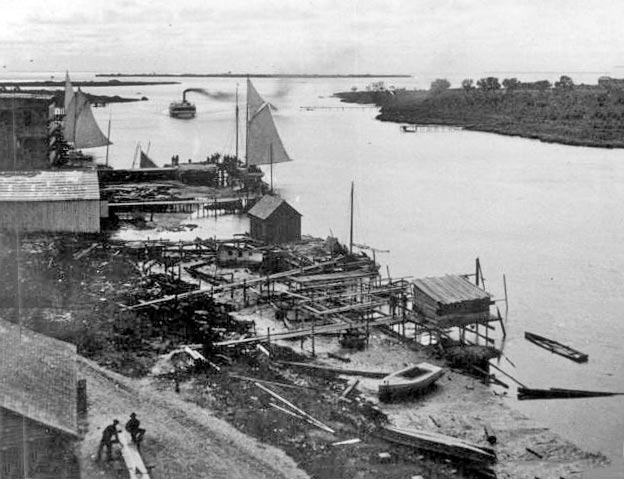 |
Below, an
idealized
etching of
the same
view.
In both
images can
be seen the
undeveloped
area of
Spanishtown
Creek on the
right that
would become
Hyde Park.
The Platt
St. bridge
would be
built in
1926.
On the
horizon can
be seen the
mouth of the
Hillsborough
River with
the two
grassy
islands in
the bay at
far left.
In 1925,
dredging of
these
channels
would fill
them in and
become Davis
Islands.
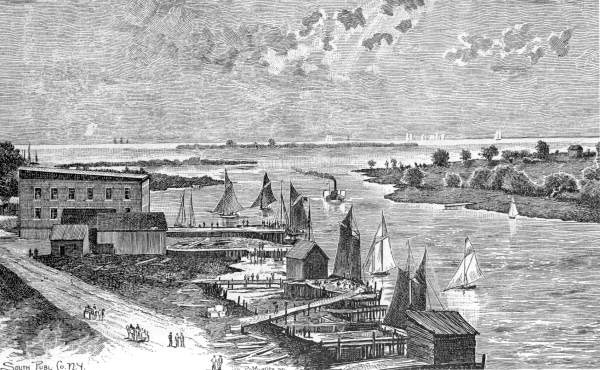 |
|
State
Archives of
Florida
Memory
collection
|
State
Archives of
Florida
Memory
collection
|
PRESENT-DAY VIEW OF
HAYDEN'S FERRY LOCATION

The
ground-level view today
is from 2 Kellar Street,
the cul-de-sac between
the NBC building and the
Kennedy Blvd. Bridge.
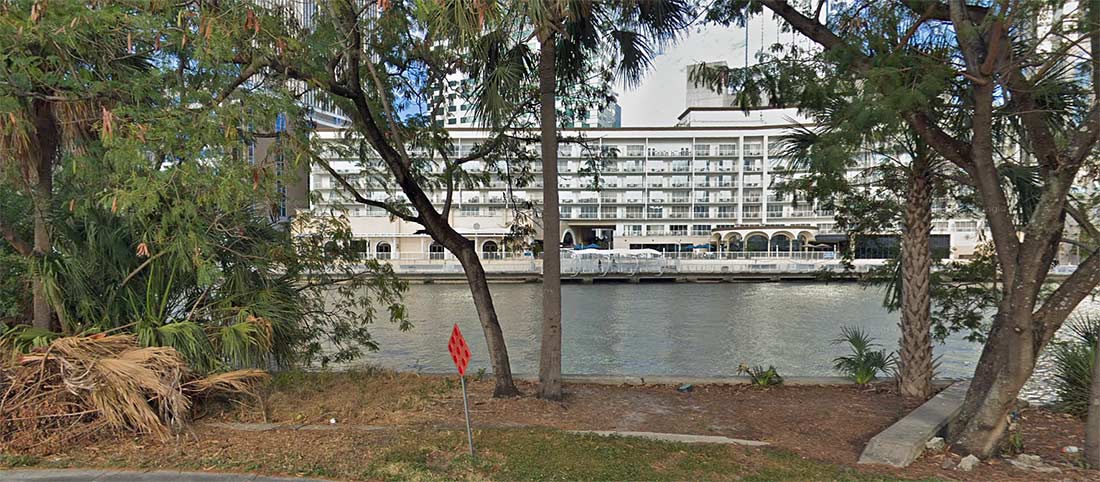 |
|
|
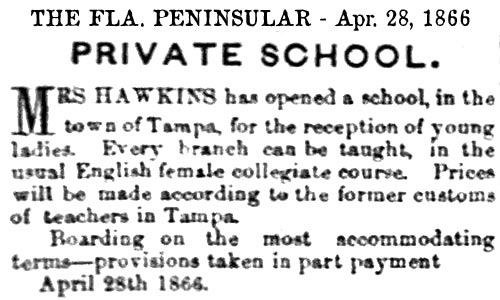
SAM C.
CRAFT'S SCHOOL FOR BOYS
In 1866 Samuel Craft returned to Tampa to open a
school at the Baptist Church initially known as the
"Select and Limited Male School." Craft had
conducted a school earlier in Tampa, but was forced
to relocate to Bartow in 1863 due to a controversy
over misuse of county funds. At one point during the
war, Craft was paid for his services in "bacon,
potatoes, sugar, syrup, and other commodities".
After the war, Craft had a definite effect on the
educational philosophy in regard to discipline
within the Tampa schools. His influence was greatly
magnified by the fact that, besides being the head
teacher of the school, Craft was also the editor of
the local newspaper, the Florida Peninsular. In
addition to arithmetic and English Grammar, Craft
focused on lessons geared to developing the
"character" of the child. Initially, his school was
well received and several dozen students were
enrolled. However, Craft's rigid and harsh methods
caused many students to drop out.
By 1867, the school was closed due to low
enrollment. But his editorials in the
Peninsular had an impact for many years on the
disciplinary practices that existed in the district,
especially in rural schools. Craft's philosophy of
strict order and discipline was the cornerstone of
many small smaller schools for decades after Craft
left Tampa.
Unfortunately, Craft's philosophy was sometimes
carried to extremes by overzealous educators. A
historian from Hernando County reported the
following disciplinary practices used in rural
schools in the late 1860's and 1870's: "The severity
occasionally reached draconian levels. Flogging was
an everyday occurrence as punishment for offenses of
all kinds. There was little regard for age or
sex in such punishment."
Craft did have some positive influence
on the development of schools. He was one of the
leaders of school reform and called for more
uniformity in textbooks and procedures in local
schools. In an editorial in his Florida Peninsular
on February 2, 1867, Craft wrote,
"Teachers are not alone, however, interested in this
enterprise. By adopting a uniform standard of school
books throughout our country, a vast amount would be
annually saved to parents.
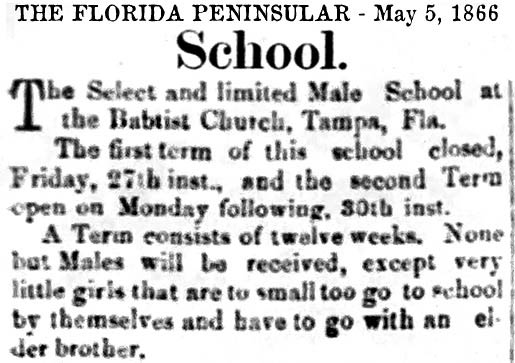 The
first term had already closed and the second term
was due to start next Monday, May 30th, when Sam
Craft placed an article in Tampa's Florida
Peninsular newspaper. Craft routinely placed
ads in the Peninsular concerning his school's
offerings, tuition and schedule. The
first term had already closed and the second term
was due to start next Monday, May 30th, when Sam
Craft placed an article in Tampa's Florida
Peninsular newspaper. Craft routinely placed
ads in the Peninsular concerning his school's
offerings, tuition and schedule.
His
school's terms were for 12 weeks and only for boys,
but with one exception--"very little girls that
are too small to go to school by themselves
and have to go with an older brother." Only
elementary classes would be taught, such as
spelling, reading, writing, arithmetic, English
grammar, geography, history, with emphasis on
arithmetic & grammar.
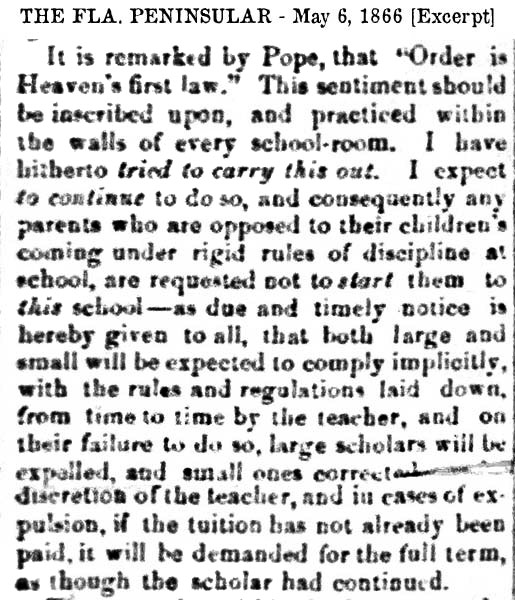
Craft had over 25
years of experience, with testimonials of success.
He believed that "Order is Heaven's first law"
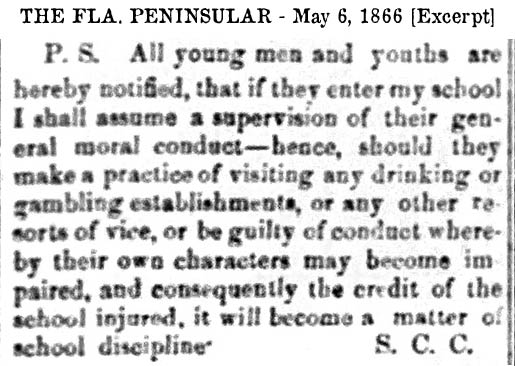 There
would be no deduction of tuition for sick days
except in cases of protracted illness. He ends with
a specific warning: Entering this school puts Mr.
Craft in supervision of the students' moral conduct.
Discipline would be administered to any who visit a
drinking or gambling establishment. There
would be no deduction of tuition for sick days
except in cases of protracted illness. He ends with
a specific warning: Entering this school puts Mr.
Craft in supervision of the students' moral conduct.
Discipline would be administered to any who visit a
drinking or gambling establishment.
See the whole article.
July 21, 1866 - Sam
Craft placed another lengthy ad on this date
announcing the closure of his school due to lack of
income caused by lack of enrollment, which he
attributed to apathy--
"I have never found
a place equal of apathy and apparent indifference on
the subject...as I have found in Tampa. Few
seem to care whether their boys go to school or not,
and the few who do seem entirely indifferent..."
See the article.
THE FIRST COUNTY BOARD OF INSTRUCTION
Dec. 3, 1866 - The first known report of school age
children by race and gender, minutes of the County
Commissioner's meeting.
Boys: White 251, colored 63
Girls: White 235, colored 51
In 1867 the federal government's
Freedmen's Bureau
agreed to erect a school for African Americans,
which was completed in 1871. Historian Canter Brown
described a visit to Tampa from Rev. Duncan, State
Superintendent of Colored Schools to plan for the
construction of the first "colored" school in Tampa.
Records indicate that this early school probably was
Tampa School #2. This school was replaced by a new
two story building known as the "Harlem Academy" in
1889.
|
In 1868 the
Florida Assembly provided for a "unified system
of public education" to include:
-
All counties
to provide a public education for all
children in the county
-
A state
superintendent of education
-
Each county to
have a School Board and Superintendent
-
The
establishment of a state school fund
The following
year, additional state legislation mandated
"public instruction, open without charge, to all
youth in the state between the ages of six and
twenty-one" (1). There was no requirement for
racial segregation in state legislation. |
|
THE FIRST SUPERINTENDENT OF THE HILLSBOROUGH
COUNTY BOARD OF PUBLIC INSTRUCTION
In
1869 the first Board of Instruction was
established in Hillsborough County. A. Watrous
served as the Board's first superintendent and
chairman. The county attempted to appoint
members for the Board of Instruction to
establish the first "real" public system in the
area. However, efforts in Hillsborough, and
other counties in Florida, met with great
resistance from residents. It was reported that
twice in 1869, the men appointed as members of
Hillsborough County's School Board refused to
accept their appointments, leaving 895 eligible
children without public schools.
In 1870 a public school was operated with public
funds in the City Hall of Tampa (in the county
courthouse.) It is believed that this school was
again referred to as Tampa School #l. Also
in 1870, the Florida Peninsular documented the
existence of School #3. The article stated:
"Pleasant Hill School will open in September for
10 months, two miles northeast of Tampa." (8)
Joseph Robles was a trustee of this school,
which later became "Nebraska Ave. School".

Between 1868 and 1871, the Hillsborough County
Board of Education was in operation. Records and
minutes from these early Board meetings,
however, have never been located. It was
reported that the records from this period were
"removed" from the county by A. Watrous when he
moved out of Hillsborough County.
Two public schools
were reported in Tampa (#1 and #2). Their location was
not provided. Six schools were reported in
Hillsborough County. Later Board minutes
(September 26, 1876) identified Tampa School #2
as a "colored" school. This would
corroborate Canter Brown's report that the
Freedmen's Bureau assisted in erecting a school
in Tampa "for the colored people" sometime in
1870.
Despite the laws
passed mandating that counties provide public
education, state funding was grossly inadequate.
During this period, few of the residents of
Hillsborough County possessed enough assets to
generate a sufficient, local tax base necessary
to establish the system mandated by the
legislature.
One source of funding, at that
time, was the Peabody Educational Fund
established privately by northern financier
George Peabody, but this only provided a small
proportion of the necessary funding.
Consequently, by 1871, the Board of Education
still had not purchased any building or property
or property for school construction. Education
continued to be provided in churches, public
buildings, rented buildings, and private homes.
In contrast to Hillsborough, Polk County was one
of the richest counties in the state due to
lucrative cattle trade. Despite their resources,
Polk's educational system remained private for
the most part. |
| |
|
THE PEABODY
EDUCATION FOUNDATION -
From Wikipedia
Founded of necessity due to damage caused largely by
the American Civil War, the Peabody Education Fund
was established by George Peabody in 1867 for the
purpose of promoting "intellectual, moral, and
industrial education in the most destitute portion
of the Southern States." The gift of foundation
consisted of securities to the value of $2,100,000,
of which $1,100,000 were in Mississippi State bonds,
afterward repudiated.
In 1869 an additional
$1,000,000 was given by Mr. Peabody, with $384,000
of Florida funds, also repudiated later. The main
purpose of the fund was to aid elementary education
by strengthening existing schools. Because it was
restricted from founding new schools, it did not
benefit freedmen in the South, as there were no
established schools for blacks. "The fund introduced
a new type of benefaction in that it was left
without restriction in the hands of the trustees to
administer. |
|
Power to close the
trust after thirty years was provided on condition
that two-thirds of the fund be distributed to
educational institutions in the Southern states.1
"The rules of the
Peabody Education Fund were strict, allowing for the
distribution of about $80,000 per year over a period
of thirty years. By the time of the termination of
the fund in 1898, about $2,500,000 had been
distributed. In 1875, the trustees of the Peabody
Education Fund founded the Peabody Normal School of
the South which promptly became the Peabody Normal
College (1875-1911). It was maintained in connection
with the University of Nashville and supported by
annual donations from the Peabody Education Fund. In
1910 the Peabody College for Teachers was organized.
Placed adjacent to Vanderbilt University, the
college opened its doors on June 14, 1914 for summer
school. In September 1915, four new buildings had
been completed at a cost of $750,000. About 1915,
the Peabody Education Fund ceased to exist.
See also
The Creation of the Peabody Education Fund
1L.
P. Ayres, Seven Great Foundations (New York, 1911)
|
|
Oct. 19, 1870 - THE
SOUTH FLORIDA MALE & FEMALE INSTITUTE
The board of trustees of W. P. (William Penn) Haisley's private school consisted
of well-known and successful businessmen of the
community. The ad even advised that good boarding could
be obtained in the homes of private families at moderate
rates. (Back then, "South Florida" referred to the
entire peninsula portion of the state, excluding only
the panhandle portion.)
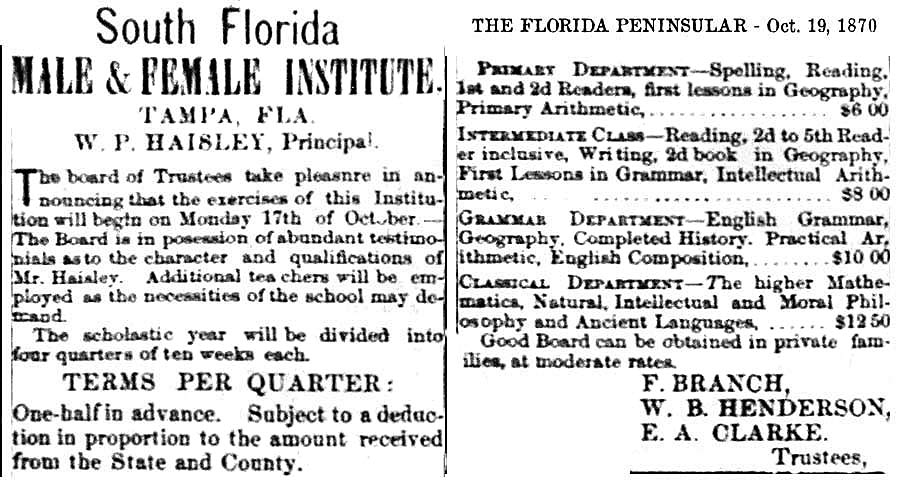
-
Dr. Franklin Branch (1802-1882) was early
druggist, SE corner of Florida and Washington, and owner
of the Branch Opera House on Franklin St.; son Darwin
Austen Branch was mayor from 1857 to 1858.
-
William Benton Henderson
(1839-1909), one of five children of Irishman Andrew
Hamilton Henderson who came to Hillsborough County in 1846. W.B was founder of an early store with Captain John
Miller, editor of the Florida Peninsular and developer
of Tampa Heights, Tampa's first suburb.
-
Edward Austin Clarke came to Tampa in 1853, was
married to a daughter of Dr. Franklin Branch, then
married to a daughter of Judge Perry G. Wall. Clarke was
first mayor of Tampa after the Civil War, big investor
in real estate and was the Clarke in "Clarke & Knight"
hardware store until Perry Wall II turned 21 and took
his place as "Knight & Wall".
WILLIAM BENTON HENDERSON,
EIGHT-TIME TAMPA CITY COUNCILMAN
Information combined from:
The City Council of Tampa
and Celebration of Old City Hall's
Centennial,
a project of the City of Tampa, 7th
Edition - December 2018 and,
TAMPA HEIGHTS: TAMPA’S FIRST
RESIDENTIAL SUBURB,
By Marston C. Leonard
THE SUNLAND TRIBUNE Volume IV No.1 Nov. 1978, Journal of the TAMPA HISTORICAL SOCIETY
-
August 1876 – August 14, 1877
-
August 14, 1878 – August 13, 1879
-
August 13, 1879 – August 14, 1880 (
President)
-
August 12, 1881 – August 14, 1882
-
August 14, 1882 – August 14, 1884
-
August 13, 1885 – July 15, 1887
-
July 15, 1887 – March 8, 1888
-
March 4, 1891 – March 4, 1892
The
following bio on W. B. Henderson was
sourced and combined from:
-
History of the City and the Tampa Bay Region of Florida,
by Karl H. Grismer, edited by D. B. McKay, 1950.
-
Genealogical Records of Tampa
Pioneers, Charles E. Harrison, 1915.
-
The Blue Book and History of
Pioneers, Tampa, Fla. 1914, Mrs. Pauline Brown-Hazen, at
Internet Archives.
-
History of Hillsborough County, by E. L. Robinson, 1928
at the University of S. Florida Digital
Collections
|
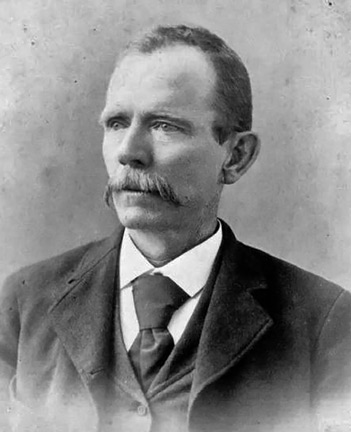
William Benton Henderson, 1891
Photo from Florida Memory,
State Library & Archives of Florida |
|
Born on
September 17, 1839 in Jackson County, Georgia, William
B. Henderson came to Tampa at the age of
seven with his parents in Oct. 1846.
Alexander Hamilton Henderson and Flora
Olivia McDonald arrived with their four
young boys:
William Benton, John Alexander, James
Fletcher, and Andrew Augustus; William
was the oldest. At the time,
Tampa consisted of the Fort Brooke
military post and a small trading
station. In Tampa, Alexander H.
and wife Olivia had one more son, Wesley
P. Henderson, in 1848.
W.B. didn't
have the advantage of an early school training. Being the eldest child of a
large fan1ily, he assumed the
responsibilities of self-support and of
making his own way at the early age of
twelve years, when in 1852, his
father died and so he took a job in
Kennedy & Darling's general store to
help support his mother and his four
younger brothers.
On Feb. 9.
1860, when he turned 21, he married
Caroline Elizabeth Spencer, sister of Sheriff
Thomas K. Spencer. They were children of Palma Ceia homesteader William Samuel Spencer.
W.B and Caroline then bought a small farm on the Alafia
River and there W.B. opened a small
general store. He continued
merchandising and farming until the
outbreak of the. Civil War a year later.
1860
Census, Tampa

W.B. and his young wife,
Elizabeth Spencer, with his two youngest
brothers Augustus and Wesley.
During
the Civil War, W.B. served first in Capt. (judge) James Gettis’ Company D of the 7th Florida
Regiment. He went with this
company to Kentucky and saw service
there for about a year, when he was discharged because he
had become ill with tuberculosis. He returned to Tampa and
when
recovered, he immediately
reapplied to the Sec. of War for
reappointment, but the response was slow
in coming so he enlisted in Capt. John
T. Lesley's company in Tampa. When
Capt. Lesley was severely wounded,
Henderson took command until the CSA
surrendered. W.B. named one of his
sons "Gettis Augustus" in honor of
Capt. James Gettis.
W.B. quickly developed
unusual talents in business affairs and
financial management. After the war, he
engaged in the cattle trade and stock
raising business for the next 10 years,
by which he accumulated a handsome
fortune.
1870
Census, Tampa

Henderson, William, Stock
raiser, wife Caroline E, son Gettis A.,
dau Blanche, dau Cora, cook Harrison,
Ema and probably her three daughters
Sarah (servant), Malica, and Julia.
It was a conspicuous peculiarity of W.B's
businesses that although he
was the real head and the
responsible financial backer
of most of them, his name
never appeared in the chief
place as the senior partner
or head of the business.
He then bought an interest in Captain
John Miller's steamboat and mercantile
business, forming the partnership of Miller &
Henderson, which became Tampa’s largest
store. With Miller he also founded the
Tampa Steamship Company. Together, the
steamship and mercantile business
dominated Tampa’s commercial contact
with the outside world, conducting
the
largest wholesale and retail grocery
business in the southern half of the
state. They also owned a number of
steamships and sailing vessels that
plied the Gulf waters, and in those days
furnished almost the only means enjoyed
by the people of Tampa and this section
of the state of communication with the
outside world.
W.B. was a diversified
and dynamic promoter: he introduced
Durham bulls into the Florida cattle
industry; he built Tampa’s first
telegraph line; he started the banana
trade with Central America..
This ad below
was one column, top to
bottom of the page.
The unused vertical space
has been removed and the ad
split into 3 columns.

This
partnership had continued about ten
years, when the Tampa Commercial Company
was organized with Mr. Henderson as
President and A. C. Wuerpel as general
manager. The Taliaferros, Stocktons and
D. G. Ambler, of Jacksonville, were also
stockholders in this company.
|
 |
|
August C.
Wuerpel
Circa 1883 |
August
Wuerpel came to Tampa from New Orleans
with his wife and four children in the
early 1880s. He and Henderson were
prime movers in the effort to start
Tampa's first organized fire department
which consisted of volunteers. On
June 2, 1884, sixteen local citizens
formed Hook & Ladder Company No.1, a
volunteer department with W. B.
Henderson as foreman, Fred Herman,
assistant foreman, and C. P. Wandell,
treasurer. Other members were P. F.
Smith, Dr. Duff Post, Ed Morris, J. C.
Cole, E. L. Lesley, Phil Collins, S. P.
Hayden, Frank Ghira, H. L. Knight, A. J.
Knight, C. L . Ayres, S. B. Crosby and
A. P . Brockway. In 1885, August
C. Wuerpel was appointed to be the
department Chief.
Five or
six years later, on the dissolution of
the Tampa Commercial Co., W.B.
retired from active business and
channeled his energies
into financial investments and public
service. But he still retained
interests in various enterprises and
became identified with others: the
Tampa Harness and Wagon
Co., a partnership with Henry
Clay Giddens of the Henry Giddens
Clothing Company, selling men’s
apparel. With real estate investor
William H. Beckwith, they founded
Beckwith & Henderson, a real estate firm
which later became Beckwith, Henderson
and Warren.
This active involvement brought him even
greater influence,
W.B. served
as president of the Bank of West Tampa,
president of the West Tampa Land and
Improvement Company, president of the
Tampa Building and Loan Association,
president of the Tampa Publishing
Company (consolidating two local papers
into the Tampa Times), president of Tampa’s first
Railway Company, for ten years W.B. the president of the State
Board of Health,.
|
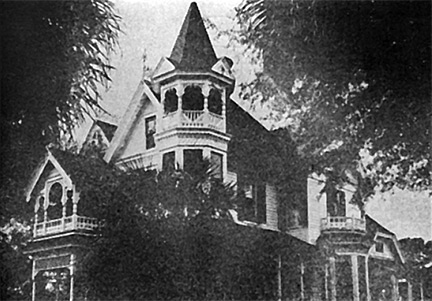 |
|
Henderson's home on 7th Ave, in
1902
|
When he built a large
house, complete with observation turret,
on the bluff at Tampa Heights, he was
soon surrounded by so many business and
family associates that the two block
section of Seventh Avenue East resembled
a Henderson corporate center which would
heavily influence Tampa’s economic
growth for many years.
Unlike many of Tampa’s
identifiable sections, Tampa Heights was
an area of many small subdivisions,
established by original homesteaders or
developers. Most of the early homes were
constructed by individual contractors
and while the area had its share of land
speculators, the Heights was designed
for Tampans with little newspaper
promotion and attractions for Northern
winter visitors. Perhaps the four block
Tampa Heights subdivision, created in
September of 1889, by William Benton
Henderson, best reflected the growing
prestige of Tampa Heights in the last
decade of the nineteenth century.
W. B.
was as prominent in the social and
political life of Tampa as in its
financial affairs. Though he
might have easily attained prominent
positions in the politics of the
state, it was well known that he
never sought political office nor
accepted a salaried position at the
hands of the public. He always
declined and devoted his activities
in that line to local and county
matters, and
his efforts were
always directed toward securing good
government and an honest and fair
administration of the Jaws.
The only state office that he ever
held was that of member of the State
Board of Health, as its first
president.
For
for several years W. B. was the
Chairman of the County School Board,
and numerous terms as City
Councilman.
He was several times a
member and chairman of the Board of
County Commissioners of Hillsborough
Co., in which position his financial
ability was largely instrumental in
promoting the prosperity and upbuilding the material
fortunes of this section.
He
served a total of eight terms on
Tampa’s City Council
He was prominent in the church's
affairs, being for many years a
steward and liberal contributor to
the finances of the First Methodist
Church, of which he was a member and
trustee. He was chairman of the
building committee that supervised
the construction of the present
[1915] house of worship of that
church. He was a trustee of
the church from the time of the
commencement of his membership.
He loved his church and was
interested in all the would make it
succeed. He not only gave of
his wealth in capital, he gave it
his thought, time and attention.
W.B took
a prominent part in fraternal and other
organizations. He was a member of the Order of
Odd Fellows, a Mason, and a Confederate
Veteran. He also belonged to the
Tampa Yacht and Country Club.
W.B. was
largely interested in the orange
business for many years. At one
time he owned nine groves, totaling 85
acres in fruit-bearing trees. He
owned property all over South Florida.
In De Soto, Manatee and Hillsborough
Counties, he owned 8,000 head of cattle;
he was undoubtedly the principal shipper
of cattle to Cuba from Florida for many
years.
W.B. was
also one of the founders of Tampa’s
Board of Trade in 1885, being a part of
it for over 25 years, and through all
those years, he was one of the most
active and steadfast workers in
promoting its interests.
DEATH OF W. B. HENDERSON
W.B.
died on May 7, 1909 in
Dwight, Illinois. He had gone
there to recover at "a well known
sanitarium" from what was described as
"a nervous breakdown."
The
relationship between him and the schools
of the County and of Tampa were always
very intimate to him, and as an
appreciation of what he had done to
promote education in the county, all the
public schools were closed the day of
his funeral, which was held on May 10,
1909 in Tampa. It was one of the
largest ever held in Tampa. The
Rev. W. J. Carpenter, Pastor of the
First Methodist Church, conducted the
service at the church building.
An
extract taken from his eulogy of W.B.:
"History is made up
of the acts and deeds of men and women.
The growth of the city, state or nation
is the crystallized history of those who
have been the leaders of its progress
and the champions of its development.
Biography, expressed in the
intellectual, commercial, social, and
religious growth of a people makes the
history of that period of that people.
Those who in their public acts in their
progressive ideas reflect the growth and
sentiments of their people are the real
makers of history.
To attempt to eliminate the individual from the
movements of civilization is to fail to
truthfully record the real facts of
history. How true these
observations are is most forcibly
illustrated in the life and achievements
of our friend and fellow citizen, W. B.
Henderson. No man can write the
history of Tampa or of South Florida and
leave his name out; and it is equally
true that the biography of W. B.
Henderson cannot be truthfully written
without writing a large part of the
history of the growth and development of
Tampa and of South Florida."
|
From his
obit: "While never
aspiring to the position of
boss, it was recognized in
the county for many years
that two men could swing its
sentiment for a candidate
and that their approval was
almost equal to election.
One was Col. Henderson, and
Capt. John T. Lesley was the
other."

Read his whole obit, it is
long. (When it
opens, click it again to see
it full size.)
|
 |
(Read about his
descendants on the next page of this
feature.)
|
|
|
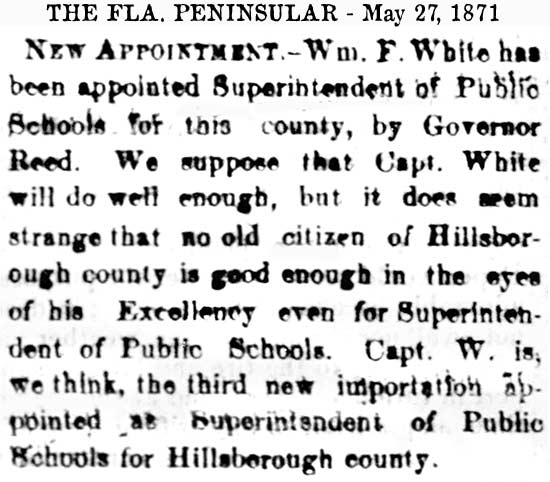 W. F. WHITE
SUCCEEDS A. WATROUS AS SUPERINTENDENT OF PUBLIC
INSTRUCTION IN 1871 W. F. WHITE
SUCCEEDS A. WATROUS AS SUPERINTENDENT OF PUBLIC
INSTRUCTION IN 1871
William F. White was
appointed to the position by Florida's Governor Reed.
It appears that White was a young man, as the Peninsular
questioned his youth by stating, "but it does seem
strange that no old citizen of Hillsborough County is
good enough in the eyes of his Excellency even for
Superintendent of Public Schools. Capt. W(hite)
is...the third new importation appointed as
Superintendent of Public Schools..."

The Tampa
School was a reference to Haisley's male & female
school; the terms were used interchangeably in the
newspaper. By Feb. 1871, this school had 55 pupils.

The two
articles at left were probably a reference to the same school, the
South Florida Male & Female Institute. Their ad
below was the same one they ran in the previous year,
and it ran all year long in 1871, each week, even past
the Oct. 17 opening date. No articles could be found
about the progress of the school after opening. The tuition per quarter was subject to a
deduction proportional to the funding it received from
the county and state school boards.
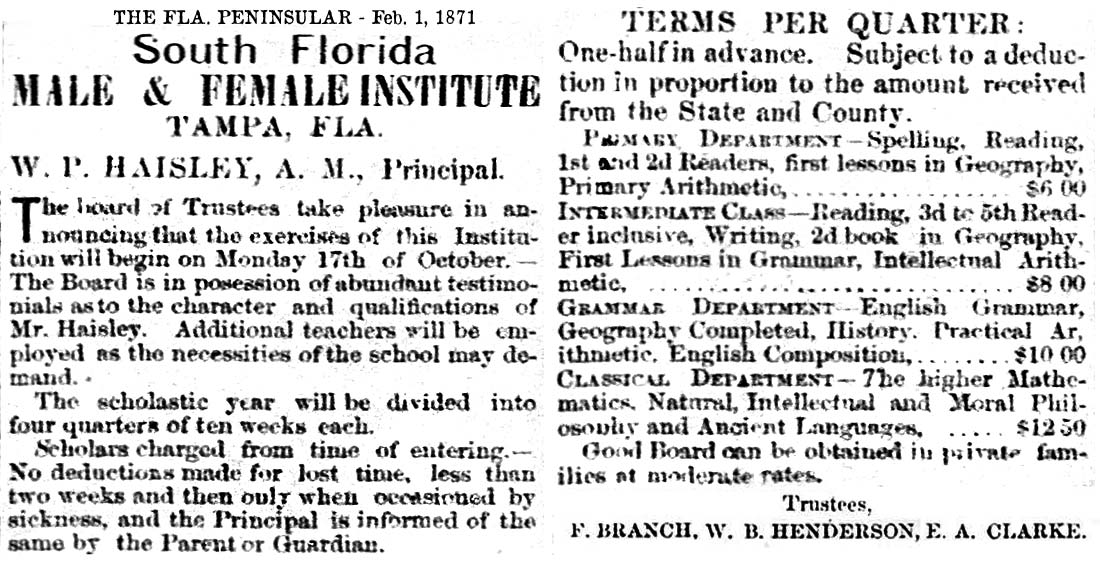
This school had the most
complete curriculum, especially for the intermediate and
higher level courses, but it was far from being a public
school, as the state and county funding would have been
minimal at best.
This school was the
most consistent over a period of several years in the
1870s, advertising in just about every weekly
issue of the Florida Peninsular.
THE
SCHOOL BOARD FORMS A COMMITTEE TO ESTABLISH
QUALIFICATIONS FOR TEACHERS
white superintendent education branch givens spencer
school schools instruction commissioners board meeting
The first available minutes to exist from school board
meetings was one from Aug. 28, 1871. Continuous
records exist of the Board of Education's meetings, took
place in the county courthouse on Dec. 10, 1871, at
which time the Board recognized that a teacher must have
some sort of qualifications other than a willingness to
teach. The Board, consisting of Chairman
John T. Givens, T. K. Spencer , Dr. F. Branch, and W. F.
White, Superintendent and Secretary, appointed a
committee to examine and to "certificate" teachers.
SUPT. WHITE
REPORTS ON THE DEC. 10TH MEETING
Male & Female Academy becomes Tampa School No. 1 with
change in one trustee
This
article in the Dec. 23, 1871 Fla. Peninsular published
the results of that Dec. 10th meeting as provided by W.
F. White, the county schools superintendent. Nine
schools and their trustees were approved, including
Tampa School No. 1 with Trustees E. A. Clarke, W. B.
Henderson, and D. I. Craft. These were the same
trustees as the Tampa Male & Female Institute except for
D. Isaac Craft in place of Dr. Franklin Branch.
The Board
decided to meet on the first of each month so that
teachers could be examined and trustees appointed.
Those who wanted a school in their neighborhood were to
submit the names of the trustees and teachers to the
Board for approval and examination. Supt. White
assured the public that the school funds had NOT been
expended in the Tampa Schools and would be distributed
among all nine schools. He was expecting the
funding for the next school term would be enough forat
least three months of free school in every neighborhood
of the county, as soon after Jan 1 as possible.
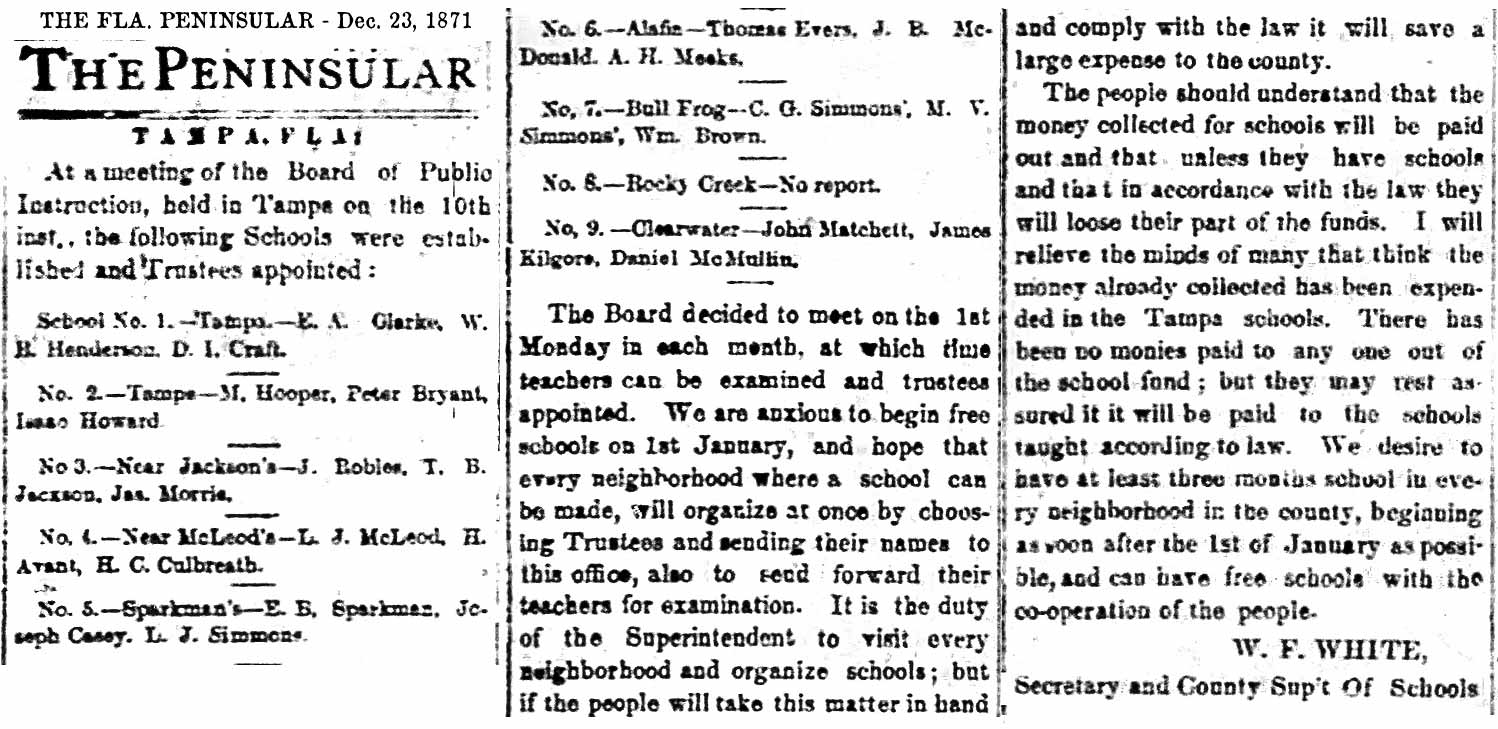 |
|
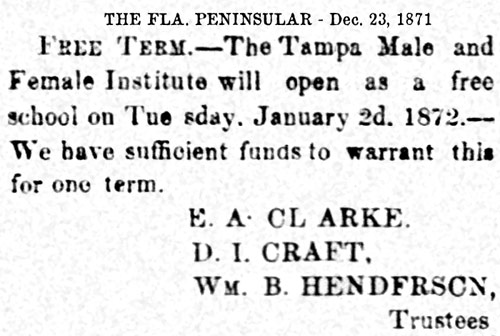
Franklin
Branch had probably resigned as Trustee and was replaced by D. Isaac Craft
as it became Tampa School No.1, maybe due to
Branch being appointed to
the School
Board.
In the next years of the 1870s into 1880, it is this
school that would grow in attendance and County funding,
and finally, move into a building specifically built and
paid for by the county and becoming Tampa's first graded
public school.
On the same page as the
above notice, the Tampa Male & Female Institute
announced that it was being funded enough to offer one
term for no charge, starting on Jan 2, 1872. This
was a reference to funding by the County and possibly by
the Peabody Fund.
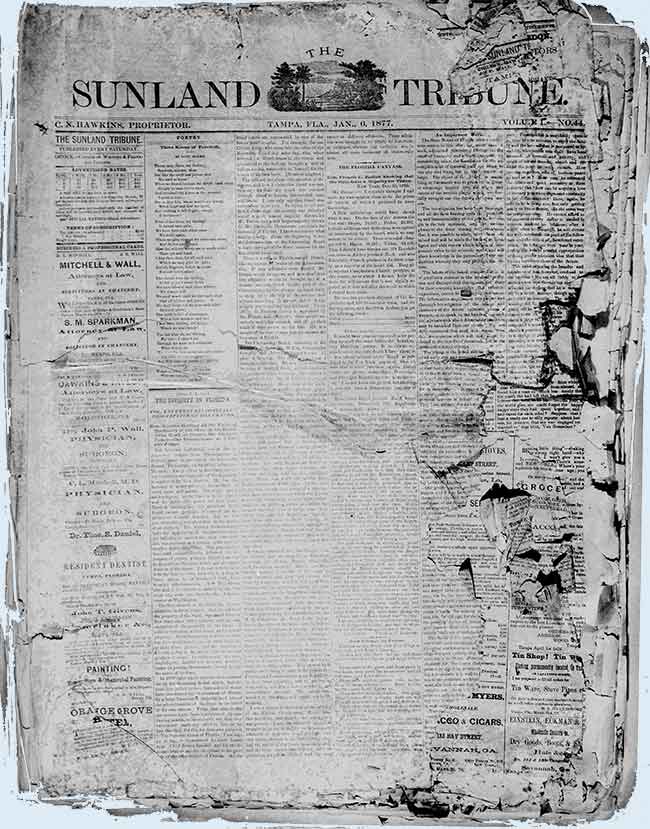 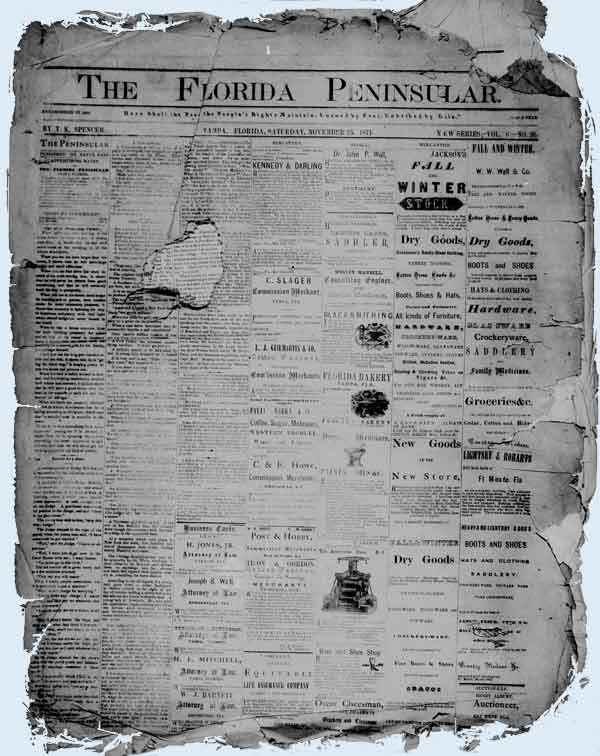 THE
GAP IN TAMPA NEWS HISTORY THE
GAP IN TAMPA NEWS HISTORY
There are no Tampa newspapers
online for 1872 through 1876. The
issues of the Fla. Peninsular leading
up the gap starting 1872 are in extremely
damaged condition. With the resumption of
newspapers in Jan. 1877 as Sunland Tribunes,
those too are extremely damaged for the
first few months.
These were the beginning years of a
well-organized school system, including the
construction of the first public school
building. But all the news of it has
be lost with the destruction of the
newspapers, leaving only the county school
board minutes. |
| |
TEACHER
QUALIFICATIONS AND FUNDING
During the 1870s, there were very few qualified teachers
throughout Florida. However, there is evidence that
there was some form of teacher certification at that
time. During a Board meeting in 1873, a Hillsborough
County teacher's certificate was revoked for cause. The
actual number of "certified" teachers in the district at
the time is unknown.
On
Jan. 6, 1872, the Board of Education passed its first
school tax of 5 mils. At this time, school taxes
were used only for the operation of schools. The primary
cost of operation was the meager salaries earned by
teachers and administrators. Communities typically paid
most of the cost of constructing their schools and
parents supplied most of the school materials for their
children.
The practice of charging tuition was still
permitted in most public schools and many did this to
supplement the limited funds they received from the
Board of Education. Taxing for the purpose of school
construction was still prohibited by law.
In
1872, schools were funded based on their enrollment. Although the minutes do not provide names, their
attendance and appropriations were reported as follows:
Tampa School #1 housed 147 students and received $331.74.
Tampa School #2 housed 39 students and received
$91.11.
School #4 (possibly Grange Hall) housed 12
students and received $28.00.
School #7 (Joseph Casey's
School) housed 31 students and received $72.44.
The
per pupil allocation in this early record is
interesting. Tampa School #I was allocated $2.26 per
pupil, while Tampa School #2 was allocated $2.37 per
pupil. The rural schools also received a higher per
pupil allocations.
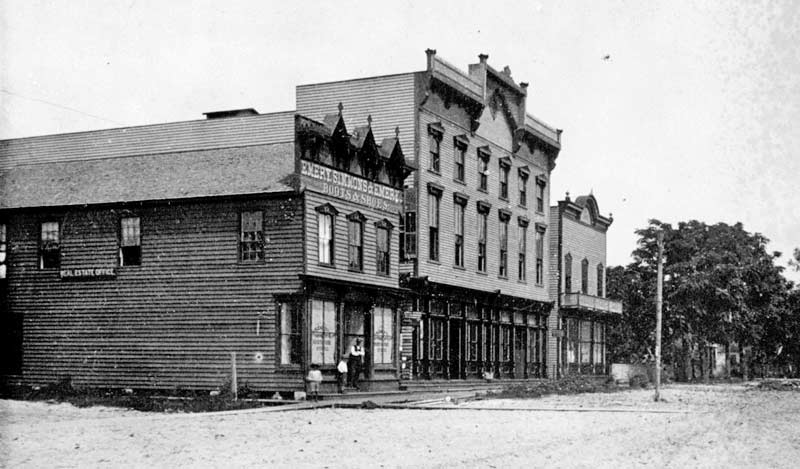 So
where were the students of
the Tampa Male & Female
Institute, and now the
nearly 150 students of Tampa
School No. 1 being taught
without a public school
building? Probably Dr.
F. Branch's opera house on
the 400 block of Franklin
St. After all, Dr.
Branch was a trustee of the
Institute. Interesting
to note that the first
commencement ceremony for
Hillsborough County High
School in 1886 was held at
the Branch opera house.--TampaPix So
where were the students of
the Tampa Male & Female
Institute, and now the
nearly 150 students of Tampa
School No. 1 being taught
without a public school
building? Probably Dr.
F. Branch's opera house on
the 400 block of Franklin
St. After all, Dr.
Branch was a trustee of the
Institute. Interesting
to note that the first
commencement ceremony for
Hillsborough County High
School in 1886 was held at
the Branch opera house.--TampaPix
The opera
house occupied the upper
floors of the taller
building. |
|
|
|
MISS VERDIER'S SCHOOL |

|
|
On Jan. 1,
1877, the Sunland Tribune published this
letter (at right) to its Editor from a
visitor to Tampa on the past Christmas.
The visitor, who only identifies themselves
as "VIATOR" relates various experiences of
their visit during the holidays, "Like a
busy bee I flew around and gathered the
sweets from every flower."
A large
portion of the letter is devoted to their
visit at Miss Verdier's school, apparently a
girls school, where the "young ladies
displayed not only much talent, but other
accomplishments in which school girls are
generally deficient...ease, grace,
appropriate gesticulation and proper
modulation of voice." The event
was apparently a play or skit. "A
happy and original idea it was on the part
of Miss Verdier to have the Southern States
represented. Each State was
personified by a fair maiden exhibiting in
her dress, or on her person, some of the
products of the State represented..."
So who was
Miss Verdier?
See this
separate page:
The
Search for Miss Verdier |
DR. JOHN P. WALL SUCCEEDS W. F. WHITE
AS SUPERINTENDENT OF PUBLIC INSTRUCTION IN 1876
|
|
JOHN GIVENS
BUILDS THE FIRST COUNTY-FINANCED SCHOOL HOUSE IN TAMPA
Between 1873 and 1875, the Board
struggled with finding funds for the construction of new
school buildings. There is no record of how the funds
were raised or of the actual cost of the first school
building in Tampa erected by the Board. However,
it would be known as Tampa School (i.e., School #I)
and would completed in 1876.
(But was it really? Probably NOT.)
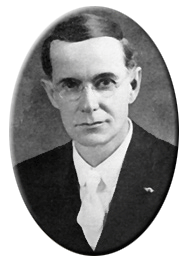 By
E. L. Robinson: By
E. L. Robinson:
In
1872 a tax of five mills for school purposes was
asked by the Board of Education. In March of that
year a committee was appointed to solicit stock for
building a school house and to determine whether it
was advisable to build. At a later meeting it was
voted to see if help could he obtained from the
Peabody fund. Evidently there had been some
difficulty in securing the funds for the school
building. There is no further record as to the
method of raising money for the building or how much
it cost. But in 1876 the first public school
building in Tampa was erected by Mr. John T. Givens
and his son, Darwin Branch Givens. This building
facing on Franklin Street occupied one-half of the
block between Madison and Twiggs Streets about where
the Shaw-Clayton book store now is in the "Sparkman
block."
(The
History of Hillsborough County Schools adds
that it was built on land sold to the County for
$400 by John Givens.)
This development was met with great dissent from
county
residents who felt that the Board had exceeded its
authority in constructing the school. The controversy
was finally settled through a statement from the
Attorney General of Florida, who reasserted the
authority of the School Board.
In 1888 the property
here was divided into lots and sold. The last three
lots were bought by Sparkman & Sparkman for $3,000.
John
T. Givens and his family came to Tampa on Dec. 25,
1848, to help rebuild two months after the
disastrous hurricane of 1848. He is credited by
some sources as having built Tampa's oldest and still
existing house, the old Dr. Stringer/Imboden Stalnaker
house.
|
It is the
opinion of TampaPix that the plans to build
the public school facility may have been begun in
1876, but it was not fully completed and
ready for use until Jan. 1878. This is
based on a Jan. 12, 1878 article by the
School Board in the Sunland Tribune.
See below. |
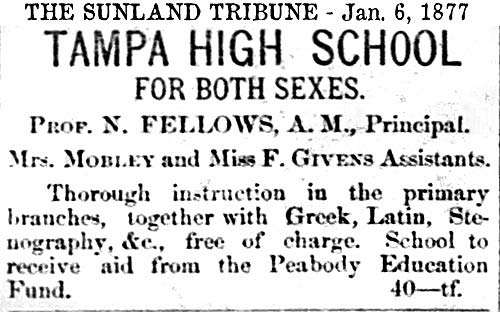 THE
FIRST PUBLIC HIGH SCHOOL
(According to
"The History of Hillsborough Co. Schools) THE
FIRST PUBLIC HIGH SCHOOL
(According to
"The History of Hillsborough Co. Schools)
The
first high school was opened in Tampa as Tampa High
School.
The advertisement in the Sunland Tribune, dated
1-6-1877, documented
the existence of the first public high school program
in the area**. "Tampa High School" operated
with only three instructors, including the principal.
The School Board
minutes concur with this newspaper ad. Board minutes
in 1876 appointed Professor Fellows as a teacher of
School # 1 and principal of all other schools in
Tampa. Later in 1877, Board minutes documented the
appointment of Dr. Fellows as the first principal of
Tampa School #1, also known as Tampa High School.
Perhaps the introduction of the name "Tampa High
School" was an effort to differentiate the
first
high school program** from
grammar school section of School #I. The high
school and elementary school shared the same
facility during these early years.
|
** The ad
specifies a thorough program in the
primary branches, but only three
classes apart from the primary branches:
Greek, Latin and Stenography. This
hardly constitutes a High School
curriculum, regardless of what it or the
county calls it. It also was meeting
in a privately owned facility due to not yet having
moved into the Givens-built public school
building, as you will see later in a Jan. 12,
1878 article by the School Board in the
Sunland Tribune. |
In 1877,
W. P. Haisley, who had been the principal at the Tampa
Institute, was elected to the position of State
Superintendent of Public Instruction.
This Apr. 28, 1877
editorial below by the Sunland Tribune expresses the
dissatisfaction with the current school funding system.
Apparently the whole county was treated as one big
school district resulting in the majority of taxes
raised in the denser population areas being appropriated
to the schools in the less populated areas. It
points to the successful application of individual
school districts in the North as an example. It
advocates dividing the county into school districts and
letting each district be independent in regard to
levying taxes and appropriating them in support of its
schools.
It also speaks to the lack of a
free public
High School program.
"Unless it can be rendered more successful than it
has proven to be so far, it will continue to prove a
positive disadvantage by its debauching effect on a
large proportion of parents who depend solely on the
school authorities to educate their children...
Again, under existing laws, there is but one class
of schools, so that all farther advances beyond a
mere primary English education must be acquired at
private expense."
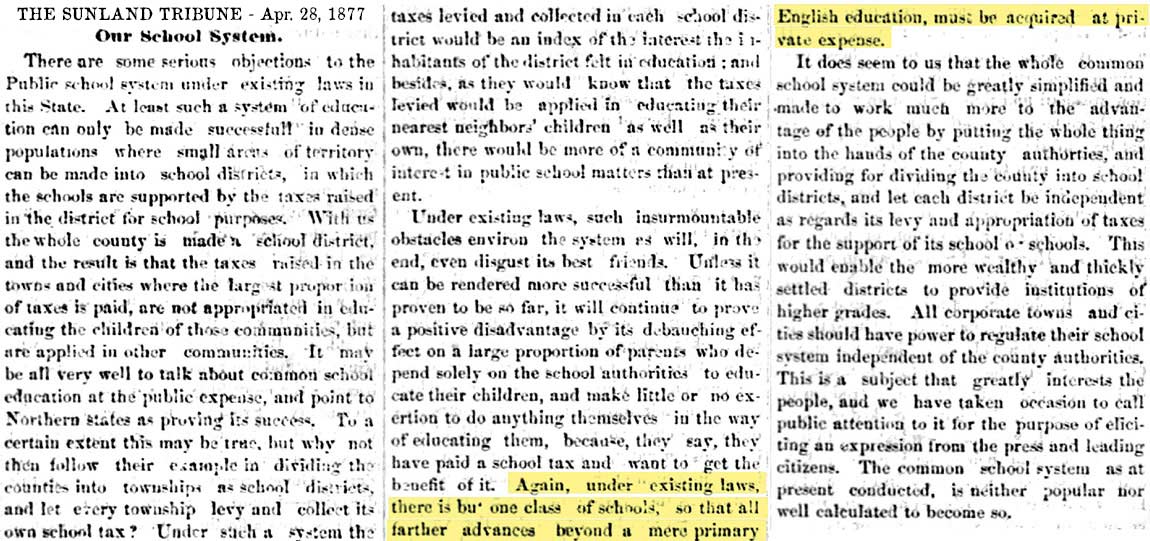
|
This is evidence that a
High School program in a free public school was still
lacking. |
WILLIAM PENN HAISLEY
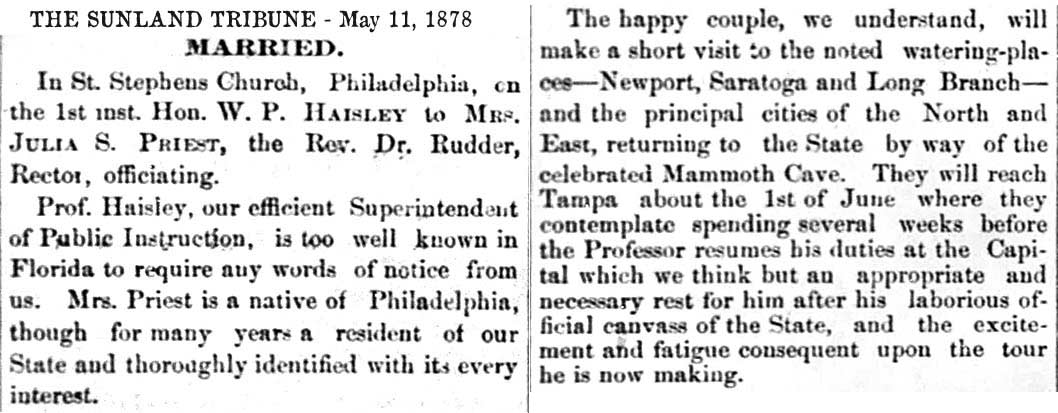 W. P. wasn't listed on
Tampa's 1870 Census, he may
have arrived just before he
became the Principal at the
Tampa Institute for Males &
Females (a private school)
in Oct. 1870. W. P. wasn't listed on
Tampa's 1870 Census, he may
have arrived just before he
became the Principal at the
Tampa Institute for Males &
Females (a private school)
in Oct. 1870.
In 1877 W.
P. Haisley became the State
Superintendent of Public Instruction, a
position he held until 1881.
On May 1,
1878 he married Julia (Simmons) Priest
in Philadelphia. She was a widow
of Mr. Priest.
1880 Census, Marion County
(location of Ocala), Fla.
William P. Haisley, Supt. of Public Instruction
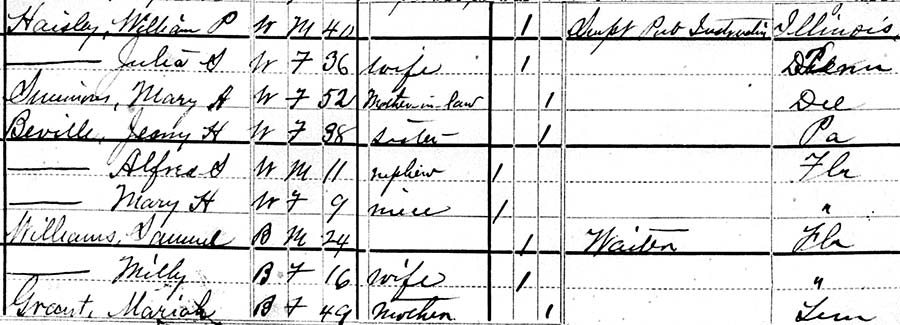
By the time of this census, W. P. Haisley had moved to
Marion Co, Fla. and was the State Superintendent of Public
Instruction. According to his age (40) he was born
c.1839-40. In his home was his wife,
Julia S., her widowed mother, Mary Simmons, his widowed sister, Jeany H. Beville, her
two children, a waiter, his wife and his widowed mother.
Julia's mother may have provided the info for this
census because his age is about 9 years too young and
his birth place of Illinois is also incorrect, he was
born in Indiana.
1885 Census, Marion Co.,
Fla.
W. P. Haisley

William was now 53 which
puts his birth at
1831-32. At this
time, he was a "Gr.
Owner" (Grove owner,
probably oranges.)
Julia S. was 46, her
mother M. (Mary) M.
Simmons was 75.
1900
Census, Marion Co, Fla.
W. P. Haisley
 |
|
This census is their most
consistent with their
cemetery info. William was a
landlord, age 68, b. Dec.
1831 in Indiana and had been
married 22 years.
Julia as 62, b. Dec. 1837 in
Penn. She had one
child who was no longer
living. Her mother,
Mary M. Simmons was b. Jun.
1809 in Delaware, age 90,
widowed.
OBIT OF W. P. HAISLEY
W.P.'s mother-in-law Mary
Simmons may have moved back
to her hometown in Delaware
after the 1900 Census
because his obituary on July
10, 1906 in the Wilmington
(Delaware) Evening Journal
says he (and probably Julia)
had come up there (Lewes)
"some months ago" to attend
the funeral of Julia's
mother and ever since then
he had been ailing to the
point of being bedridden.
The article itself was from
the June 10 Lewes news.
The article shows they
thought he was a judge in
Florida (he never was), and
that Florida was his home
state (it wasn't) because he
"was interested in several
large orange groves in his
native state."
Cemetery info and images from Find-A-Grave
provided by Sheila (Horn)
Strickler |
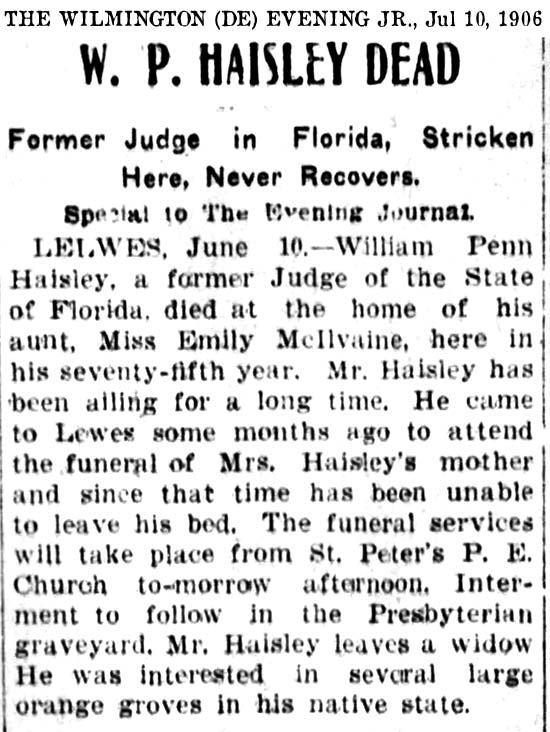 |
|
|
|
|
FLORIDA PEABODY FUNDING CUT |
|
|
In the fall of 1877, a
Peabody Fund agent contacted State Schools
Superintendent W. P. Haisley to notify him of a pending
cut in funding.
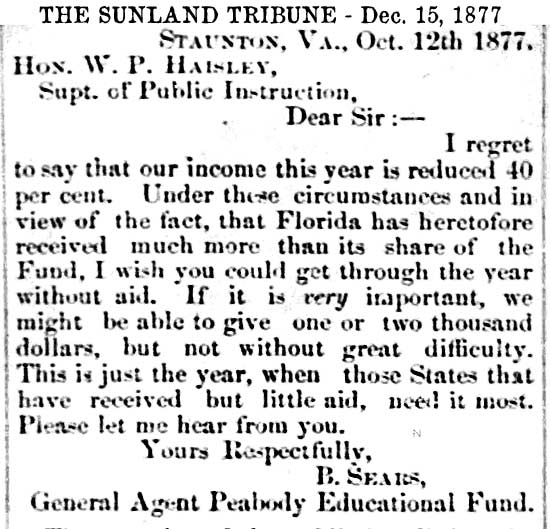
.
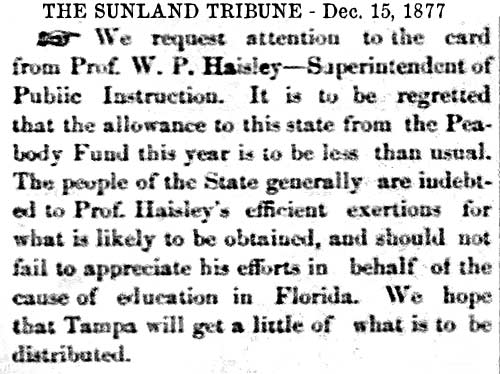
|
Haisley had actually asked for more funding for the
upcoming year, but in view of Mr. Sears's letter,
Haisley responded asking that Florida not be cut off
entirely, and be funded with enough so that schools
here which have not yet been benefited by the fund
could still be funded. He asked for about
one-half of the amount of funding from last
year--$3,000.
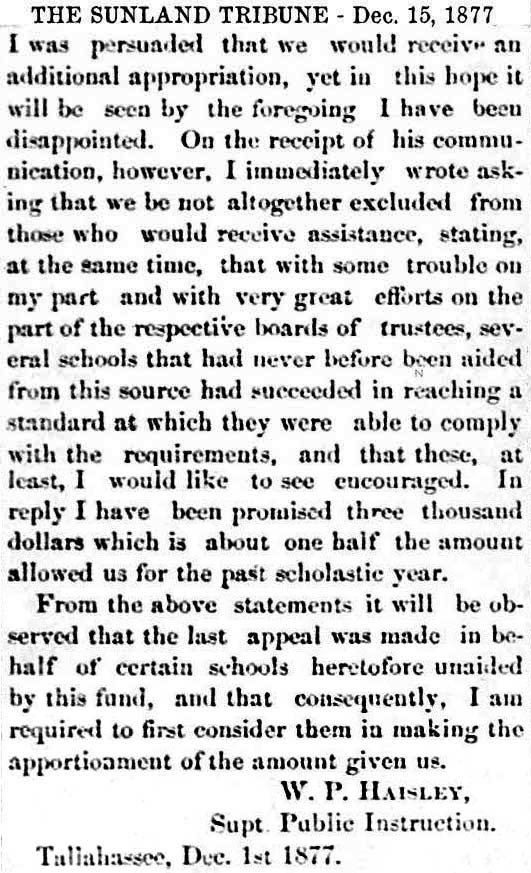
|
CONTINUING SUPPORT ENCOURAGED FOR THE NEWLY-BUILT SCHOOL
AND BOARD AUTHORITY TO HAVE FINANCED IT
Tuition payment
requested from those who could afford it, additional
funds coming from the Peabody Fund.
Tampa School to be moved into the new building today.
A Jan. 12,
1878 article (below) in the Sunland Tribune from the School Board encouraged Hillsborough County
citizens to maintain the progress of the school system
as it has been flourishing. It asked that they support
the new school for at least one quarter and they won't be disappointed.
The trustees of the school (W.B. Henderson, E.A. Clarke,
and J.T. Lesley) would accept payment of tuition from
those who felt they could afford it, so they could make
up the salaries of the teachers for one quarter.
They needed to keep up the high level of enrollment, but
those who could not pay should not keep their children
from attending, that "no false pride...will induce
them to keep their children from the school, for by
doing so they will be inflicting a serious injury on the
community by depriving it of the benefit of the Peabody
Fund." This subject ends with a plea to the
trustees and teachers to "spare no pains and efforts
to have things go on harmoniously" and if they could
get through the year, there should be no more problems.
It goes on
and speaks to the controversy created by some
believing that the school board had no authority to fund
the building of a new structure from county school
funds. It seems that opposition from outlying
areas, "in the country," questioning the
authority of the county-financed structure was due to
its location, in the heart of Tampa. The outer
areas wanted a building in their own areas, and with the
location selected, their tax dollars were spent where
they felt they weren't being benefited. To this
issue, the Attorney General of Florida was consulted and
ruled that the Board had the authority, not only to
finance the building of a school structure, but "to
do...almost anything else which in its judgment would
promote the educational interests of the country."
[sic] (probably "county.")
It ends
with the Board stating that they are authorized to say
(to put it bluntly,) when you are able to keep a large school going
for a whole scholastic year, the Board will build a
school for it. "This school (Tampa No. 1) is open
to pupils from every section of the county as much so as
it is to those of the town."
|
It
certainly sounds like they're
getting ready to start something
new, "...support it for at least
one quarter..." The third
column begins with "the
school will be moved today into
the new school house, recently
erected by the Board of Public
Instruction of this county."
If
the building was completed in
1876, why now in 1878 would the
school board call it "the new
school house, recently erected?"
And the fact that the school was
moving in there at all means it
was NOT in there previously.
So did
the building sit vacant, unused for a
year and a half to two years?
Not likely. This is
evidence that the
building wasn't completed in
1876 and had just recently been
completed.
Regarding the
great controversy over whether
or not the County could legally
use the tax-generated funds to
build a school house, it is
highly unlikely they would have
proceeded with its construction
before the opinion of the
Attorney General was rendered. |
|
|
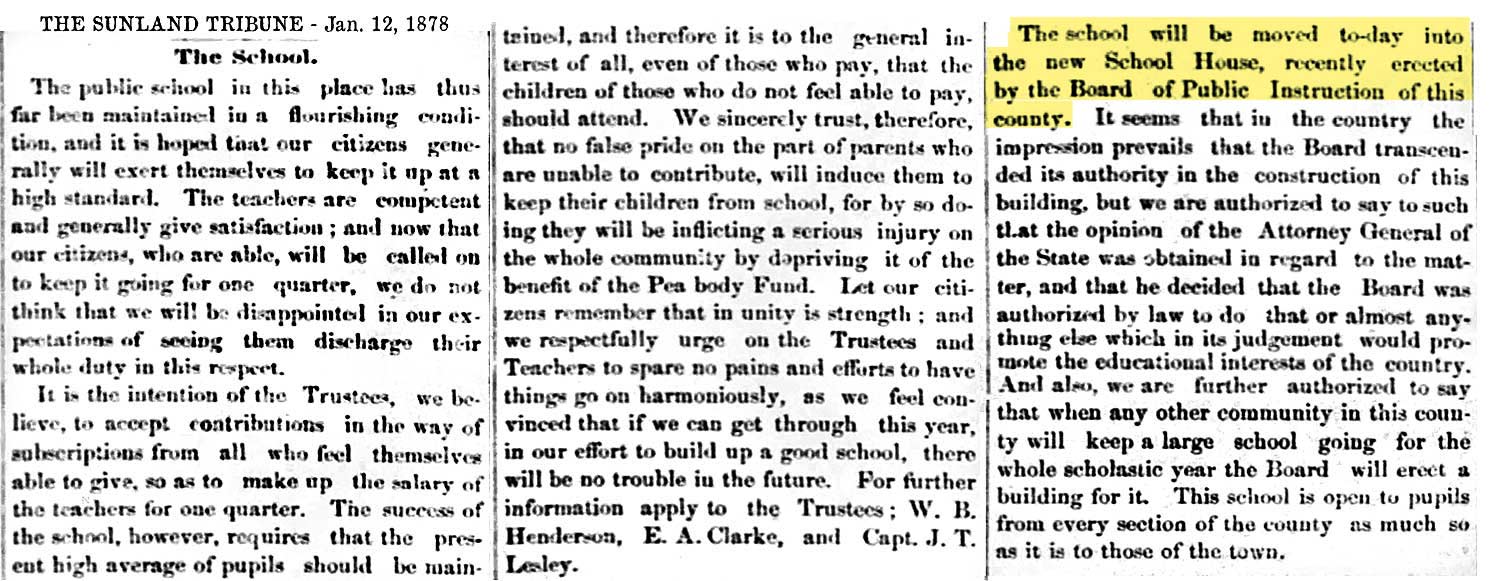
|
The article makes
no mention of the High School,
public or private, so in this
regard it is the opinion here
that this was a move of the
elementary or primary level
classes into the newly built
public school building.
|
In
1878, Tampa School, sometimes referred to as the "Tampa
Institute," was fully operational with three teachers.
These teachers and their salaries were as follows: Mr.
S. Sparkman ($166.66 per year) Miss M. Prevatt ($80 per
year) Mr. W. Hensley ($135.30 per year)
|
A RARE
DESCRIPTION OF THE COUNTY-FINANCED TAMPA SCHOOL No. 1
BUILDING
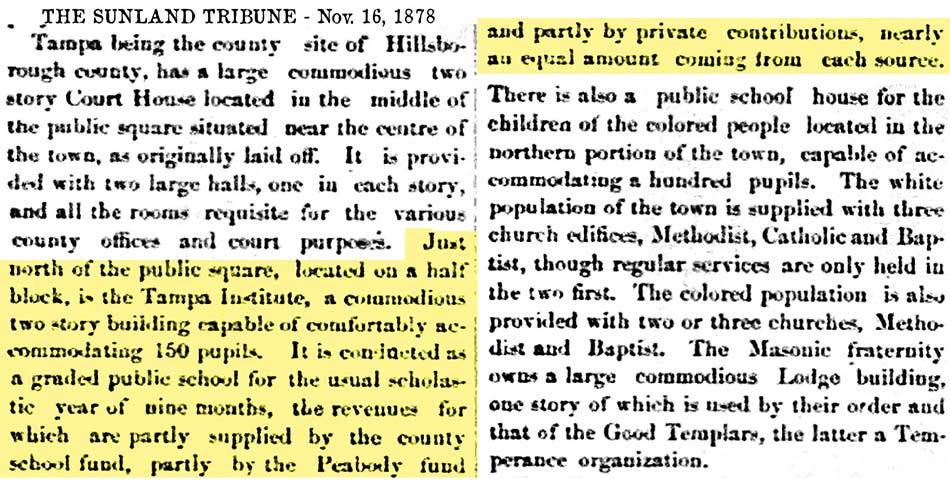
The building was
located on the block north of the courthouse square.
It was a 2-story building that could easily
accommodate 150 students. It was being used as
a graded public school for a scholastic year of nine
months (not yet), and it was being funded from three sources:
the County school fund, the Peabody fund, and
private contributions, nearly in equal amounts.
|
If the building
was being
used for the high school,
the editor of the Tribune most
likely would have taken
the opportunity to boast about
this great achievement. To
this point, no sources indicate
that the high school operated in
this building teaching a full
high school program. |
 THE
FIRST COUNTY-FINANCED & BUILT SCHOOLHOUSE THE
FIRST COUNTY-FINANCED & BUILT SCHOOLHOUSE |
|
The Tampa School No. 1 building was
located at what was in 1911 the 500 block of Franklin
Street,1
between Madison and Twiggs Streets. This is the block
just north of the county courthouse as Doris' history
states.
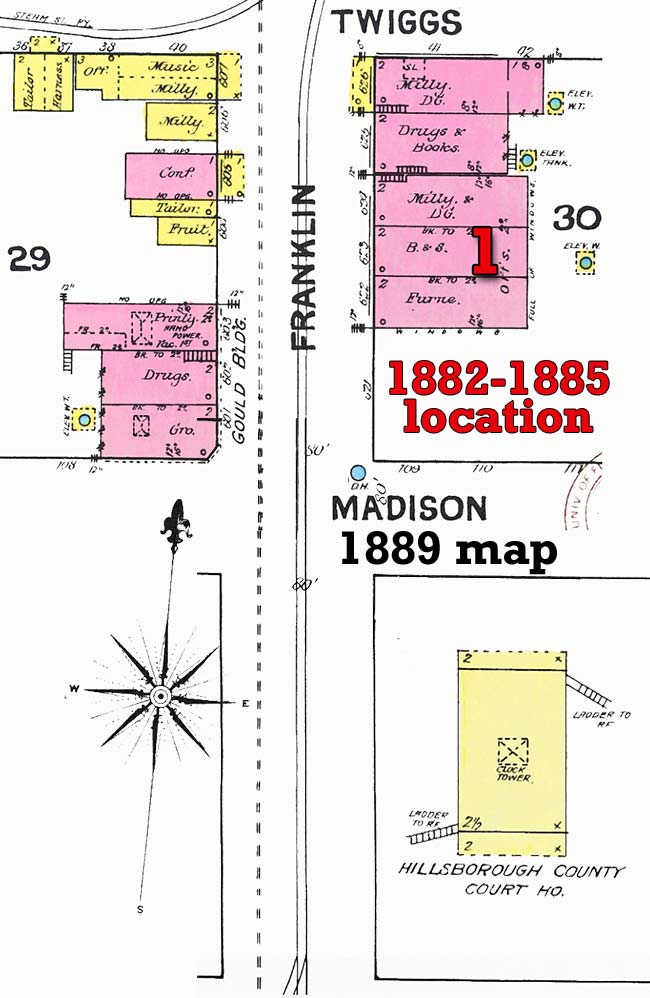
1889 Sanborn Fire Insurance Map from University of Florida
Digital Collections |
In E. L. Robinson's
"History of Hillsborough County" published in 1928, he states that
the schoolhouse was located "where the Shaw-Clayton bookstore
is now." Tampa's 1927 city directory shows this bookstore
was located at 509 Franklin St.
1Although
the 1889 map at left shows the block north of the
courthouse, between Madison and Twiggs, was the 600 block,
the 1892 map below shows the addresses along Franklin St.
were renumbered by 1892, and shows both the old 623 and the
new address 509 Franklin St. When Doris wrote her
history in 1911, that location was 509.
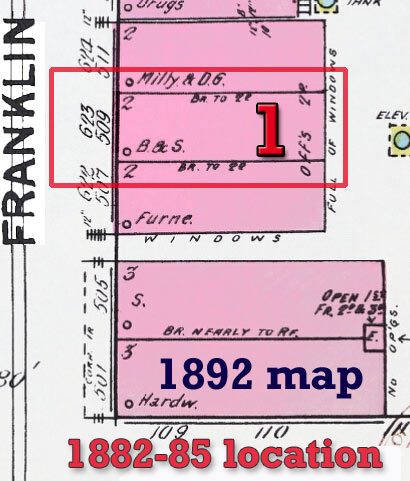
The school's location was at
the middle of the block of Franklin St., on the east side of
the street around where this map shows "B & S" (which could
stand for Books & Stationery.)
Since yellow structures were
wood frame buildings and the pink ones were brick, the
old wooden school building (everything was built from
wood in the 1870s) was apparently torn down and replaced by
the brick structures seen here in 1889. |
|
|
|
Present day
aerial view of this block.
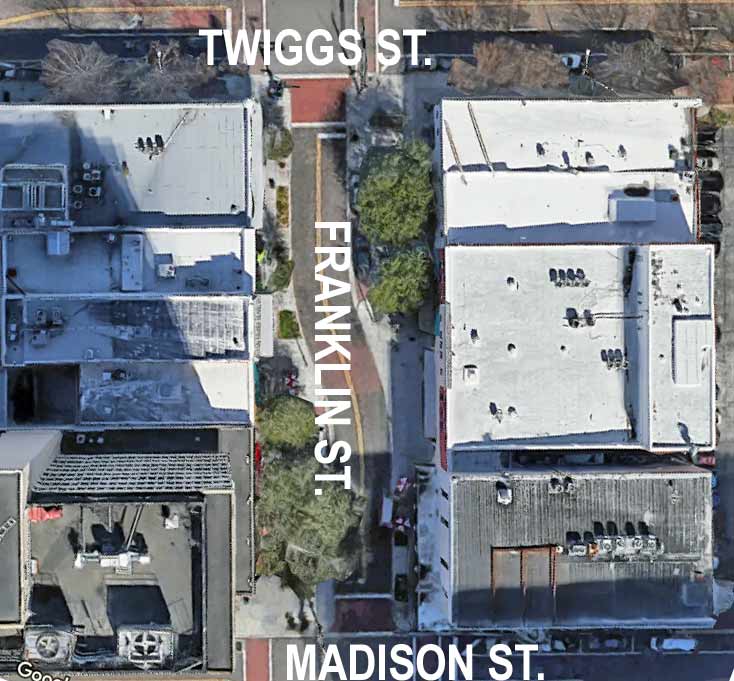
Recently, this address is
occupied by the CI Group.
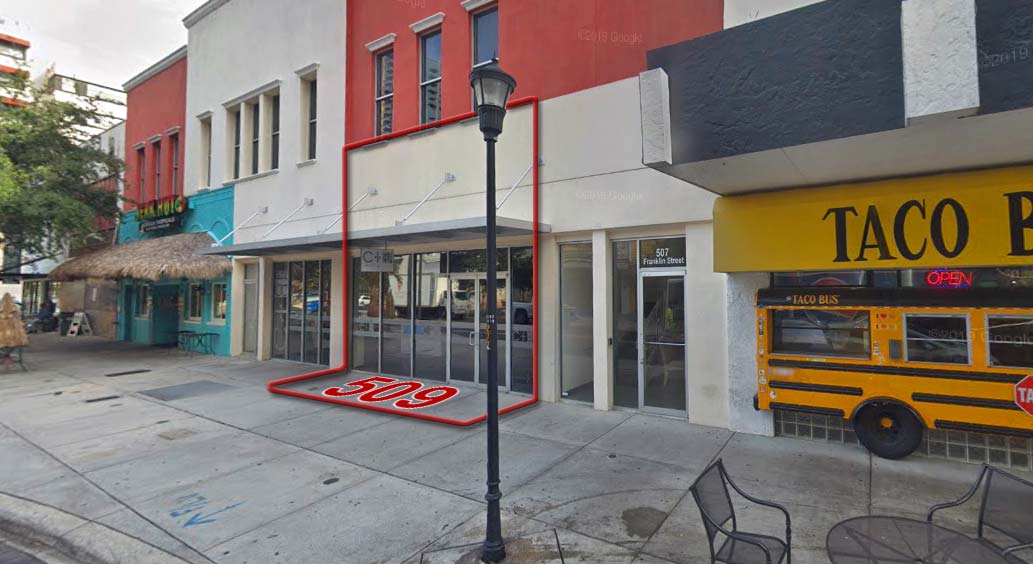
In 1929, E. L.
Robinson provided the early history of Hillsborough County's
education system in a Tribune article. Having just published
his book on the history of the county, the info would have been
fresh on his mind. This is an edited version with quite a bit
of the mid-section removed.
See the
WHOLE article here.
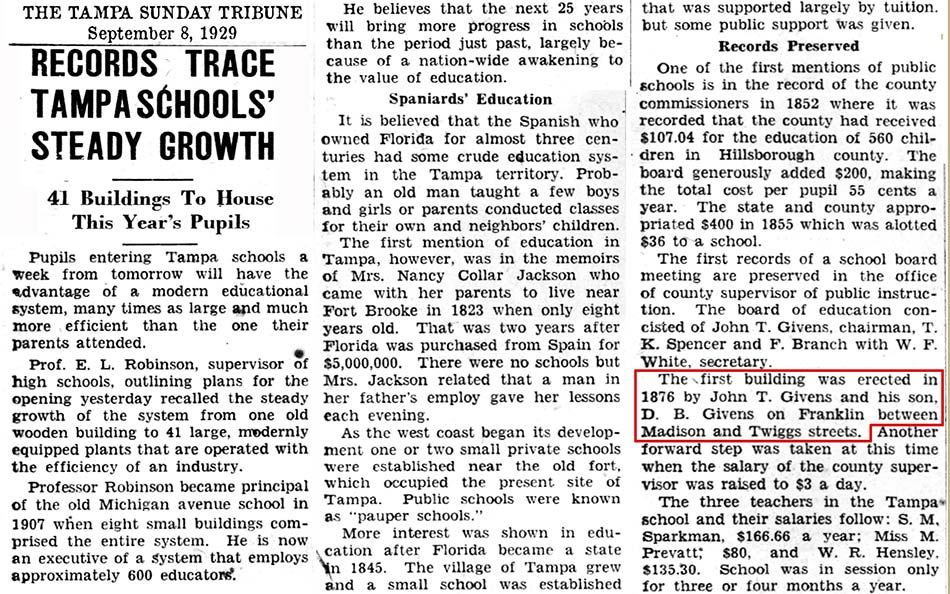
|
|
TAMPA INSTITUTE IS FLOURISHING,
BUT LACKS PROFESSIONAL CAREER
TEACHERS
Mar. 30, 1878 -
John P. Wall, editor of the
Tribune, physician & surgeon,
Mayor of Tampa and
Superintendent of County
Schools, praised the success of
the school, but indicated that
the present teachers and
principal were not people who
were pursuing education as their
career:
"Considering
that it is the first
successful attempt made in
Tampa to maintain a graded
school, the result so far is
very gratifying, indeed, and
speaks well for the public
spirit of our citizens...By
commencement of the next
scholastic year, the
Trustees of the school will
be able to provide the
Institute with experienced
teachers who have followed
teaching as a profession and
consequently feel more
identified with the success
of the school than those who
take such positions for
temporary employment without
expecting to follow it as a
life business...success must
depend on application and
devotion to the calling..."
|
|
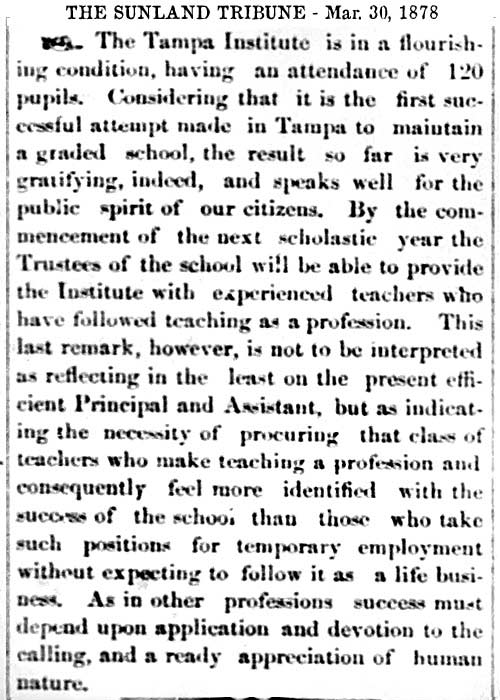
|
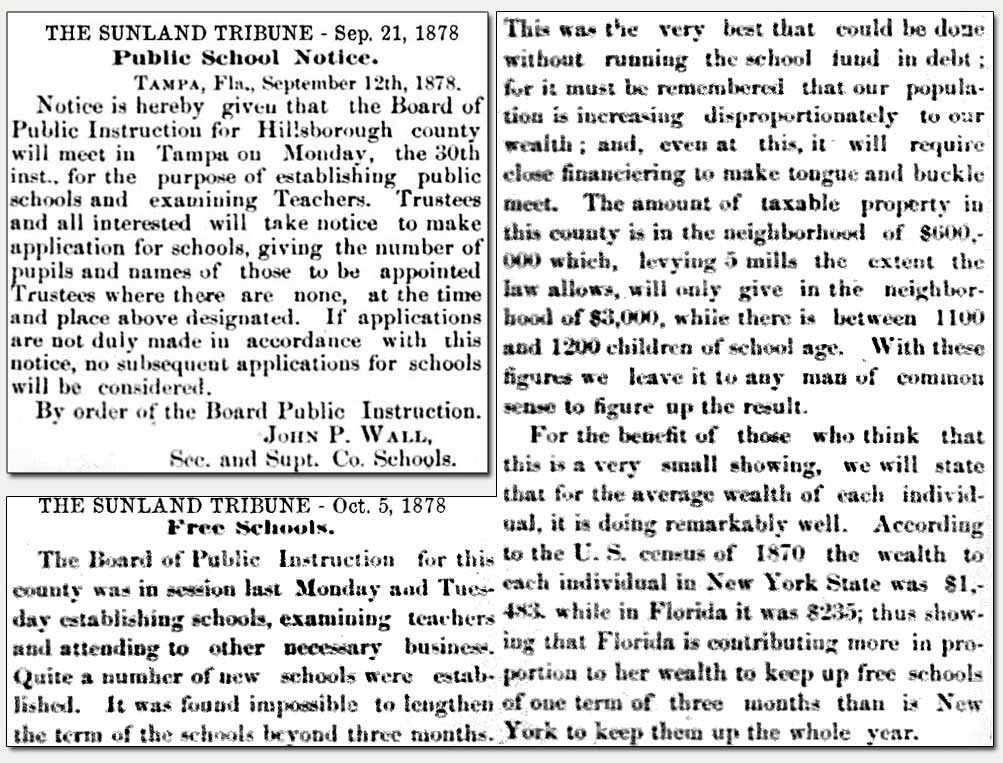
|
|
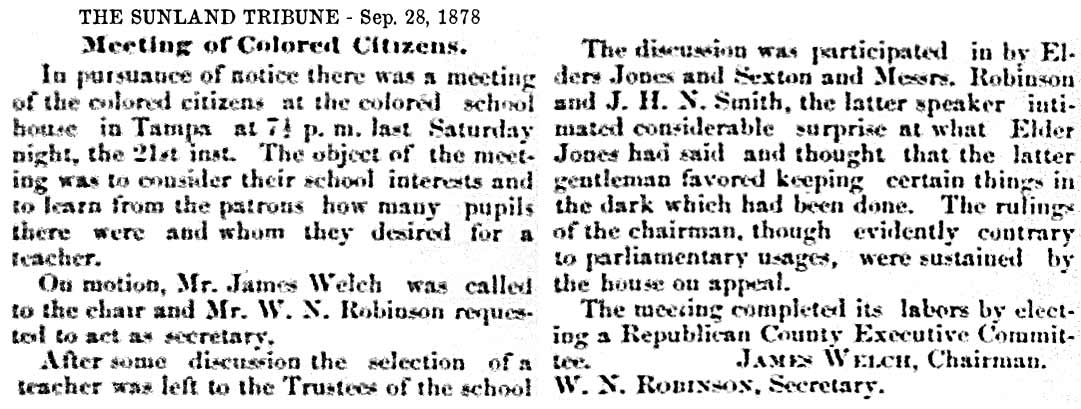
Oct. 5, 1878 -
REPORT OF THE Sep. 30/Oct. 1 SCHOOL BOARD MEETING
Teachers were examined and other business attended
to, including establishment of new schools. It
was found impossible to lengthen the term of the
schools beyond three months without running the
school fund into debt due to "our population
increasing disproportionately to our wealth."
The county taxable property was $600,000 and even
with a maximum tax rate allowed by law, 5 mils, it
would only yield around $3,000, yet there were
between 1,100 to 1,200 children of school age.
(Under $2 per child.) Citing 1870 Census
figures, Florida was contributing more to free
schools in 3 months than New York for the whole
year, in proportion to their wealth.
In 1878, the "Tampa Institute" or School #1 was
the first "graded" public school in the entire area
of southwestern Florida.
Soon after, other schools followed with the "grading
system," but most were private schools.
Schools' terms in the county were limited to three or
four months, except for Tampa School which provided
classes for 5 or 6 months. (Teachers were paid according
to their "class" (i.e., certification & experience). -
Class Two teachers received $30 per month. - Class Three
teachers received $25 per month. - Superintendent's
salary was set at $100 per year.
|
|
Although the
above articles speak of a "graded school" it doesn't
specifically mention a High School.
If the Tampa Institute had a
complete high school curriculum,
its population would likely have
been given in two groups,
primary and high school. A graded school is one where
students have been segregated
into various levels of learning
capability and achievement,
which generally advances with
age: 1st Grade, 2nd Grade,
etc. This is in
contrast to the old "Little Red
one-room Schoolhouse" where
students of all levels were
taught in one big class
simultaneously. The High
School was still being operated
independently of the County
School system, and therefore
would not have occupied the the
county-owned facility yet, as evidenced
below in the Dec. 6, 1879 Tampa
Journal. |
|
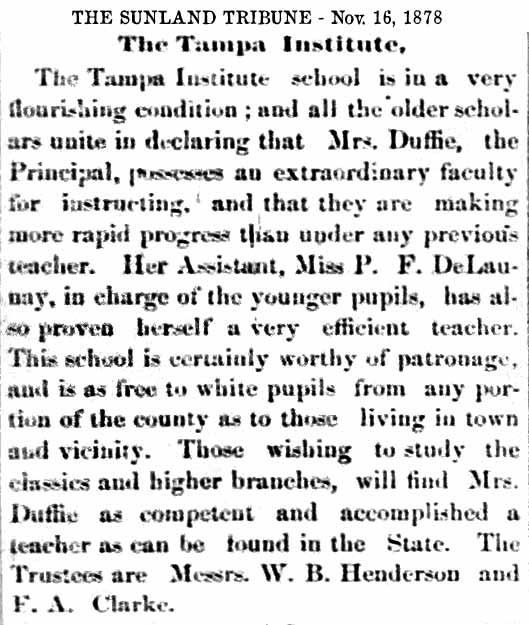
TAMPA INSTITUTE FLOURISHING
No article could be found in the
Sep. or Oct. 1878 Tribunes
regarding the start of the
school term, however this Nov.
16 article indicates it had
started with Mrs. Duffie as the
Principal and Miss P. F.
DeLaunay as her assistant, in
charge of younger pupils.
The article states the school
was free to all whites in any
portion of the county or living
in town.
There was an offering made
of "the classics and higher
branches" being taught by Mrs. Duffie, but no specific mention
was made as to what the classes
were.
The Trustees now were Wm. B.
Henderson and F. A. Clarke.
|
It would appear
that there still was no fully
organized or complete high
school curriculum, probably due
to the teachers still not being
professional, accredited career
instructors. This is evidenced
by the fact that every school
term that commences has a
different teacher and Principal
from the previous term.
The higher classes probably
still consisted of Latin, French
and Stenography. |
WHO WERE MRS. DUFFIE and P.
F. DELAUNAY?
A search of Hillsborough County
censuses for 1870, 1880 & 1885
finds no Duffies in 1870, two
Duffie families in 1880 living
in a rural area:
James M Duffie
and wife Mary. James is a
blacksmith, Mary is keeping
house.
George Duffie and
wife Julia M, George is a
farmer, Julia is keeping house.
Both Duffie families are on the 1885 census
with neither of the wives having
an occupation. It appears that
Principal Mrs. Duffie was
another non-career instructor
who had talent to teach or lead
a school.
P. F. DeLaunay
was Pauline DeLaunay, a daughter
of Tampa's 2nd Mayor and former
Postmaster of Tampa, Alphonso
DeLaunay, and his wife Victoria
(Montes de Oca) DeLaunay. (She
was his 2nd wife.)
They are on the 1860 Census of
Tampa with "Polene" age 5.
His son, John A. DeLaunay,
became the editor of the Tampa
Morning Tribune in the late
1890s.

Widowed Victoria
and her children are on the 1880
Census of Tampa with Pauline's
occupation showing Teacher.
 |
|
PUBLIC APATHY
Even with the first
successful construction of
school buildings owned by
the Board, great resistance
continued from the public.
Enrollment and attendance
were disappointing,
especially at the secondary
level. A reporter for the
Sunland Tribune appeared to be
chastising the public when
he wrote, "We regret the
fact, but it seems
nevertheless so, that a
large majority of our
citizens do not appreciate
the advantage of education.
They seem to be careless as
to whether their children
attend school or not and
appear to leave it entirely
to the option of the child.
" In a later article, he
continued in his attempt to
convince the public by
stating, "All money expended
in educating our children is
the most profitable
investment that parents can
make for their children's
future."
|
The above portion
in bold comes from the Feb. 15,
1879 article below, which is
actually in praise of the public
for for taking more interest in
supporting the schools, citing
"a little upwards of 100 pupils
on the register of the high
school." This doesn't seem to be
an attempt to convince as much
as it does praise. The earlier
article alluded to above has not
been located, but the source of
the above cites the entire
paragraph as being from the Feb.
15, 1879 Tribune article. --TampaPix |
|
|
This article specifically speaks of the
success of the Tampa high
school, now in its 5th month,
which would indicate it started
in Oct. 1878. A page by
page inspection of all the
Sunland Tribunes finds no
mention of school starting in
Sep. or Oct. |
|
This article refers to the Tampa
High School as being independent
of the "present school system"
and expresses optimism in that
regard. Citizens of Tampa
were growing dissatisfied with
the present system of funding
the schools as one school
district. |
|
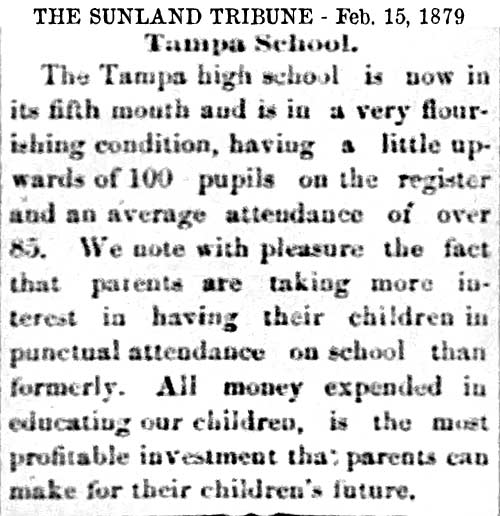 |
|
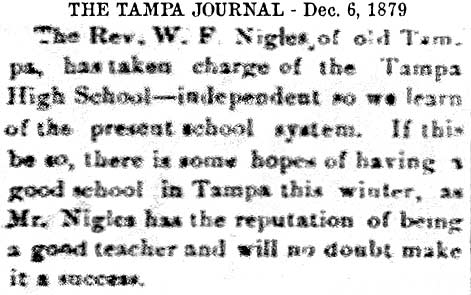
WHO WAS REV. W. F. NIGLES?
See his censuses below. |
|
1870 Census, Hillsborough
Co, Pct. 4
Although this census shows
his middle initial as "S,"
he was William F. Nigels as
seen on his 1900 Census.

William was a farmer, age
37, born in Prussia.
His wife was Harriet, age
23.
1880 Census, Hillsborough
Co., Pct. 4
William F. Nigles

Again, we see Mr. Nigles/Nigels
was a farmer, born in
Prussia (soon to become
united as Germany.)
He also appears on the State
of Fla. agricultural census.
1900 Census of William F.
Nigels, Pct. 4

Here Mr. Nigels had no
occupation, age 66, married
37 years to Harriet, born in
Germany, immigrated in 1850,
was a naturalized citizen.
His reputation as being a
"good teacher" was probably
in his church, but he was no
career educator with a
degree.
|
|
SUPERINTENDENT HENRY L. CRANE
Before 1877, the
school term was seldom more than three months,
except in Tampa School No. 1 where it was sometimes
five or six months. In 1877 the minimum school
term was fixed at four months and the teachers'
salaries at $30 per month for 2nd class teachers and
$25 for 3rd class teachers. The county
superintendent's salary was $100 per year.
In 1879 Henry L. Crane
became superintendent and secretary to the Board,
serving until 1881.
In 1880, Crane illustrated the problem faced by
the Board in NOT owning the facilities used for
public education. He stated to the Board,
"There are
but few permanent buildings over which the Board has
any control, and schools are often dependent and
subject to the will of those owning the buildings,
and are not always conveniently located. This makes
a necessity for two schools sometimes, where one
would be sufficient if the convenience of the whole
community was looked to by the trustees."
|
|
HENRY L.
CRANE -
TAMPA CITY
COUNCILMAN
-
Councilman,
August 11,
1873 –
August 1874
-
President,
August 14,
1877 –
August 14,
1878
-
President,
August 14,
1883 –
August 13,
1885
-
President,
August 13,
1886 – July
15, 1887
-
Councilman,
March 4,
1892 – March
10 – 1893
-
Councilman,
March 10,
1893 - March
9, 1894
Henry L. Crane's
father,
Henry A. Crane,
was born in New
Jersey in 1811
and worked as a
clerk in
Washington DC.
He came to
Florida during
the 2nd Seminole
War and had a
modest but
successful
military career
in the 2nd and
3rd Seminole
Wars.
H.A. Crane was a
man of moderate
means, but his
literary
abilities
provided him
with the
opportunity to
serve in many
minor political
positions. After
his enlistment
expired, he
settled in St.
Augustine where
he met and
married Sophia
Allen. Their
only son,
Henry Lafayette
Crane, was
born there on
Sept. 25, 1838.
In the 1840s the
Cranes settled
Orange County,
near Fort
Mellon, now part
of Sanford. H.
A. was a Clerk
of the Circuit
Court and in
1844, Gov.
Moseley
nominated him
for judge of
probate at
Orange Co.
In 1852 H.A.
Crane brought his
family to Tampa,
gave up farming,
and founded the
Tampa Herald
newspaper in
1852,
working full
time as its
printer and editor.
Later he was
editor of the
Florida
Peninsular
newspaper.
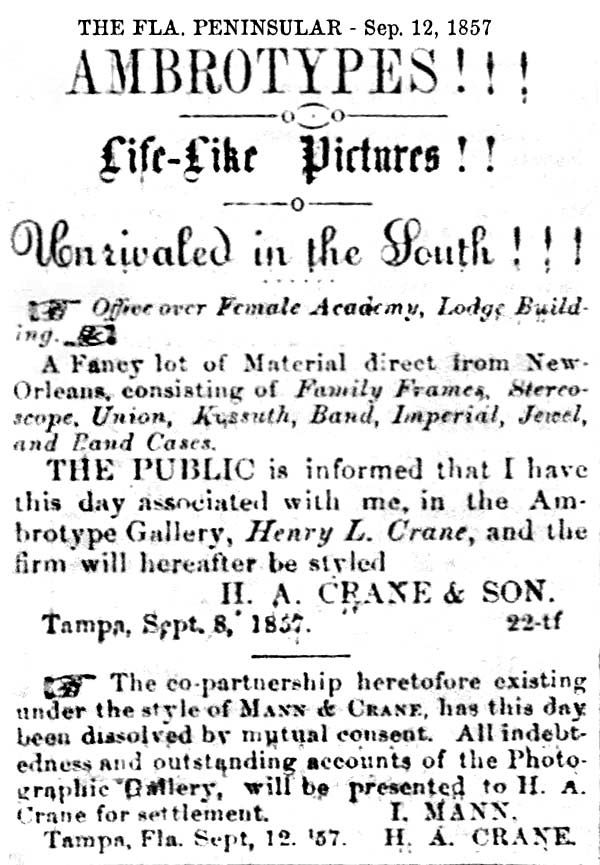
H. A Crane was
intelligent and
inquisitive
enough to profit
from his
readings about
new inventions
elsewhere in the
world. He became
interested in
photography
during its early
development, and
six years after ambrotype
photography was
introduced, he
listed his
occupation as an
ambrotype
artist.
During the Civil
War H.A. was a
Unionist, a
captain and
later a major in
the Second
Florida Cavalry,
U. S. Army. After the war,
the Republican
H.A. settled in
Key West where
he served as
clerk of the
circuit court
and as state
senator. He was
also editor of
the Key West
Dispatch and,
subsequently,
founder and
editor of the
Key of the Gulf.
But his son, H.
L. Crane joined
the Confederate
forces as Chief
Musician of the
Fourth Florida
Infantry, CSA.
H.L.
Crane and the
Ferris brothers,
Josiah and
William, had
been members of
the Tampa Brass
Cornet Band,
organized March
31, 1860, by J.
A. Butterfield. H.L. was captured
near Spring
Hill, Tennessee,
Dec. 21, 1864,
confined at Camp
Chase, Ohio, and
released Feb.
18, 1865.
H. L. Crane
later owned
and operated the
Orange Grove
Hotel with his
wife for many
years in the
1870s and 1880s.
It was located
near the present
day intersection
of Madison St.
& East St. There
is a historical
marker in
downtown Tampa
where hotel was
once located.
The hotel was
built in 1859
originally as
the home of
cattleman
William B.
Hooker,
Florida's
pre-Civil War
"cattle king."
During the Civil
War, it was used
as Tampa's
Confederate
Headquarters. It
is where Tampa
pioneer Joe
Robles marched
his captive
Union soldiers
in the winter of
1863.
|
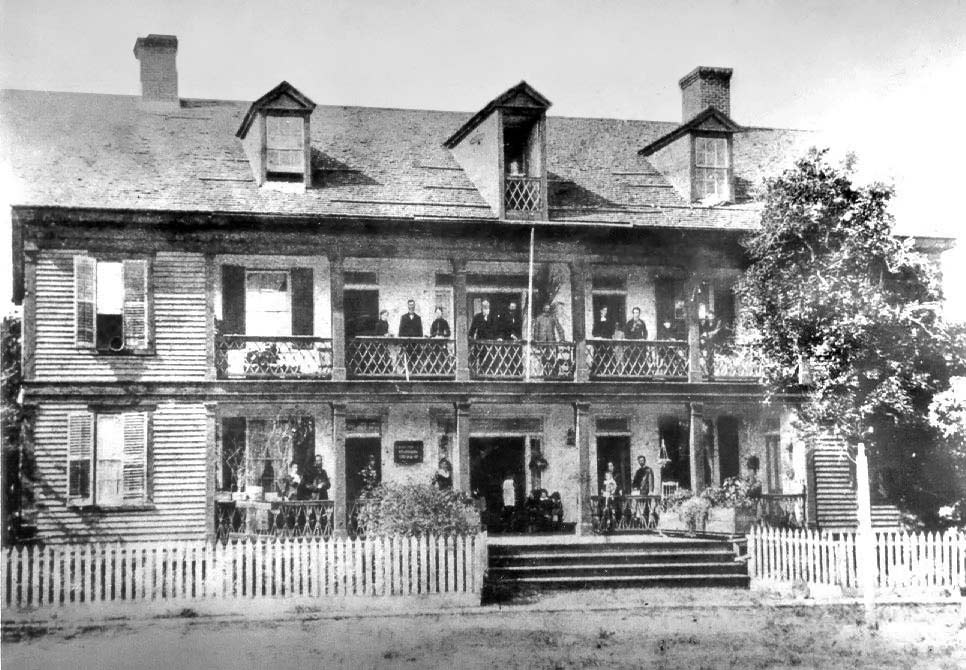
|
|
Judge Henry L.
Crane and his
wife, who
operated the
hotel in 1876,
are said to be
standing on the
left side of the
second floor
porch. Poet
Sidney Lanier
has been
identified by
contemporaries
as the man
standing on the
far right side
of the second
floor porch with
his leg propped
on the rail. But
D. B. McKay in
the Tampa
Tribune, March
6, 1955, said
Lanier is
standing at the
left end of the
first floor
veranda. Located
at 806 Madison
Street. The
original of this
photo was owned
by Mrs. Samuel
E. (Mary Hooker)
Hope, later Mrs.
Clara (Hope)
Baggett and then
by Mr. and Mrs. L.E. Vinson of
Tarpon Springs. |
|
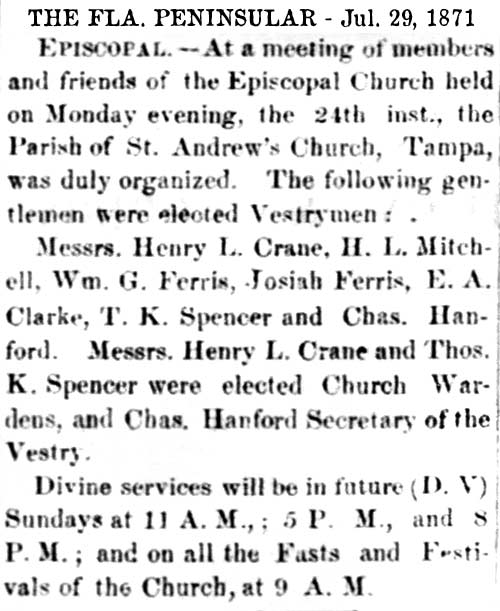 In 1866, Hooker
converted his
home into a
hotel and sold
it to D. Isaac
Craft, father of
Isaac S. Craft.
D.I Craft, who
at the time was
the Sheriff, was
in charge of the
jail.
While he tended
to the prisoners
in the jail, his
wife ran the
hotel.
Later, he sold
the hotel to
Judge Crane,
whose wife was
Meroba Hooker,
dau. of Wm. B.
Hooker.
Meroba was
widowed for
several years
from her first
marriage as Mrs.
Solon B. Turman.
Together, Henry
L. and Meroba
Crane
operated the
hotel for many
years into the
1880s. In 1866, Hooker
converted his
home into a
hotel and sold
it to D. Isaac
Craft, father of
Isaac S. Craft.
D.I Craft, who
at the time was
the Sheriff, was
in charge of the
jail.
While he tended
to the prisoners
in the jail, his
wife ran the
hotel.
Later, he sold
the hotel to
Judge Crane,
whose wife was
Meroba Hooker,
dau. of Wm. B.
Hooker.
Meroba was
widowed for
several years
from her first
marriage as Mrs.
Solon B. Turman.
Together, Henry
L. and Meroba
Crane
operated the
hotel for many
years into the
1880s.
H.L.
was
elected as
Tampa’s City
Clerk in 1869,
but like the
council members
who were elected
from 1869-1973,
he never served
due to the
dissolution of
the government
when the City of
Tampa
intentionally
let its City
Charter elapse.
Along with
fellow council
members Edward
A. Clarke and
Josiah Ferris as
well as former
council member
William Gould
Ferris, Sr.,
Judge Crane
was one of the
founders of St.
Andrew’s
Episcopal
Church.
|
 |
|
On Aug.
11, 1873, the
registered
voters in Tampa
held an election
and voted to
establish the
Town of Tampa.
Crane was
elected as one
of the new
council members
and go on to
serve a total of
six terms on
Tampa’s City
Council.
In 1879 Henry L.
Crane was
elected as
Superintendent
of Public
Education and
served until
1881. He was
also appointed
to U.S.
Commissioner in
the 1870s as
judge, a
position he held
for about 40
years.
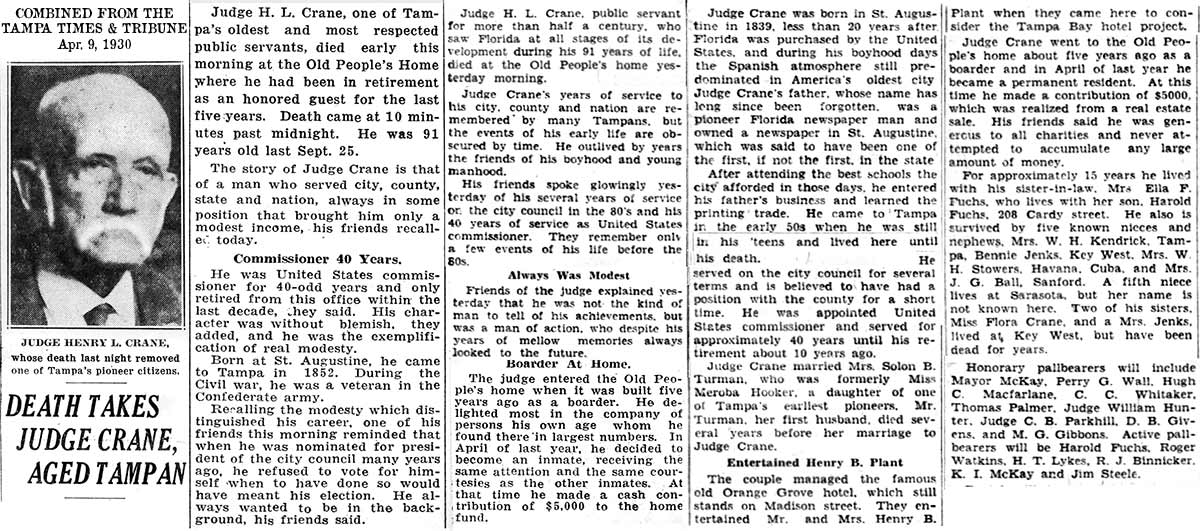 |
|
|
MORE COUNTY-OWNED BUILDINGS
AND BETTER PAY NEEDED TO ATTRACT
PROFESSIONAL TEACHERS
Throughout the late 1800's, the salary teachers received
from the Board remained very low. In most cases, these
wages were not sufficient for the living expenses of the
times. To compensate for this, teachers commonly
received a range of "fringe benefits" from the community
in which they taught. For example, in the rural areas of
the county, teachers commonly lived in a home of a
school trustee, or in the home of one of their students.
In many of these "living arrangements," teachers also
were provided with their meals. However, the problem of
this living arrangement was the lack of freedom and
privacy in the personal life of the teacher. In addition
to room and board, schools were still permitted to
charge some form of "tuition" even though they were
considered "public schools". It is likely that this
"tuition" varied greatly based on each family's
socioeconomic status. Tuition, along with other forms of
contributions from the participating families, was used
to supplement the meager salaries provided by the Board.
|
AN IMPASSIONED
PLEA FOR SCHOOL
BUILDING FUNDS -
May 3, 1879
A
Tribune reader
wrote the editor
of the Tribune
addressing the
need for funds
to build a
school house on
Nebraska Ave.
Apparently a
circular was
being passed
around
soliciting aid
for this
purpose.
There weren't
enough residents
in the area to
provide funding
themselves and
states that
everyone should
be interested in
the need, not
just the local
residents,
because it would
benefit the
community at
large.
The necessity
was made known
about a year
earlier, by the
women of the
community, and
"the wheel
revolved very
well until some
of the spokes
fell out and the
tire tired out."
Fearing a
complete
abandonment of
their need, they
had a meeting,
elected
officers, made
some rules and
regulations, and
prepared
themselves with
determination to
have a building
constructed
before half the
summer was over.
Joe Robles,
early Tampa
pioneer,
merchant, and
civic leader who
lived in the
area, donated
land for a
school building.
The writer
praises Robles,
and adds "long
may he live to
see his good
work increase
and 'flourish
like a green bay
tree.'"
He pleads for
support not just
in word, but to
"put your hands
in your pockets
giving us
liberally,
knowing after
many days it
will come back
to you ten-fold,
for this
building is
intended for all
purposes of
public benefit."
He apologizes
for asking the
Editor directly
in this way, and
adds "but you
may hear from us
gain."
|
|
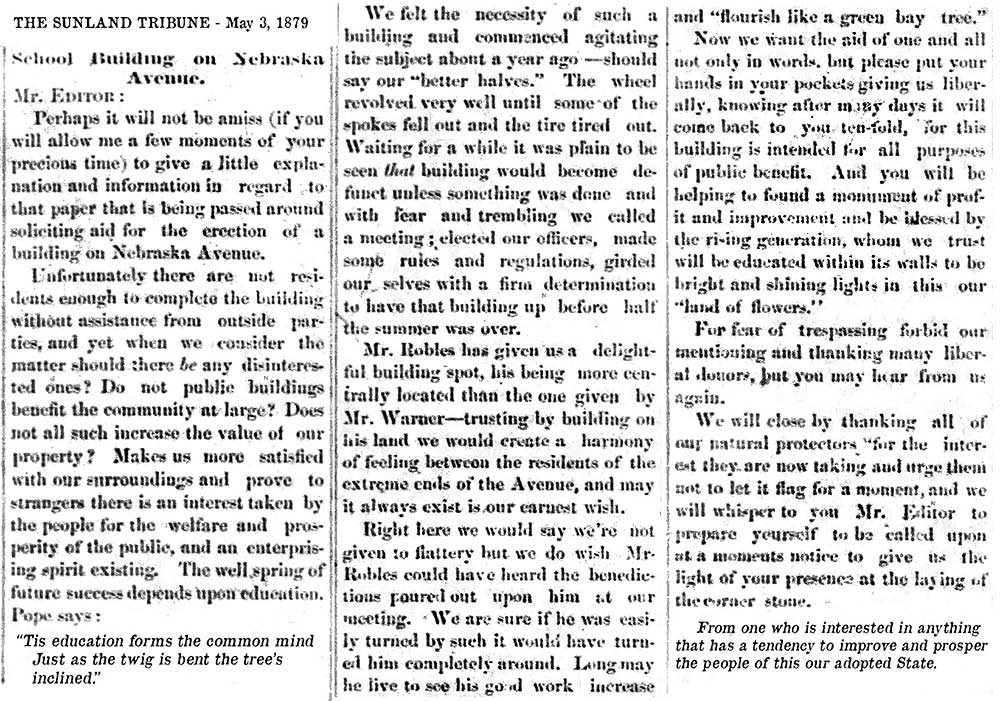 |
|
TRIBUNE EDITOR
CRITICIZES
MOTHERS FOR
OVERDRESSING
THEIR CHILDREN
FOR SCHOOL
Dr. John P.
Wall, Mayor of
Tampa and Editor
of the Tribune,
turns his sharp
tongue from
criticizing
political
opponents, to
criticizing
mothers who
"have been too
busy with their
[children's]
clothes, to pay
much attention
to their
[children's]
brains. He
says the purpose
children being
in school "...is
not the display
of the wealth or
tenderness of
their parents"
and that
anything that
diverts
attention from
learning is an
injury to the
student,
instead, working
against them.
Even teachers
would agree that
"fine clothes
oftener work
mischief to
their wearers
than mean
clothes do."
He believes
simplicity
should
characterize
their dress,
that the
"highest-minded
children are
oftenest found
in plain garb,
while these
be-ringed and
be-ruffled and
otherwise
showily attired
are generally
quite destitute
of intellectual
home culture."
He stresses
personal
cleanliness over
dress, and in
that regard he
suggests the
student have two
suits, "for in
the crowded
school-room the
clothing soon
becomes
saturated with
the exhalations
floating in the
atmosphere, and
an airing of the
clothes every
three days is
necessary to
keep them fresh
and sweet."
|
|

|
|
TEACHERS CHOSEN
FOR THE FALL
TERM OF 1880
The fall school
term for 1880
was to start on
Oct. 4 with Mrs.
Scull and Mrs.
Nunez as
teachers.
 WHO
WAS MRS. SCULL? WHO
WAS MRS. SCULL?
Her obituary in
1904 would
reveal that she
was the widow of
Rev. William D.
Scull, and a
daughter of John
M. Verdier of
Beaufort, SC.
This means she
was a sister
of Miss Verdier,
the teacher in
charge of the
aforementioned
"Miss Verdier's
School."
The missing
Verdier "puzzle
pieces" linking
the two ladies
are found on the
separate page, "The
Search for Miss
Verdier" and
her school of
1876.
WHO WAS MRS.
NUNEZ?
The other
teacher would
have been Arabella Nunez, found on the 1880
Federal Census of Tampa, age 34, widowed, living with
her teenage children Ruby & Robert.
-Teacher-b.jpg)
Robert F.
Nunez in Tampa
by 1850 Census,
b. GA, Laborer,
apparently
unmarried.
Grismer:
|
It
was the next superintendent, Wesley P. Henderson, who
began reaping the benefits of the strong arguments
that Crane presented for more facilities owned and
directed of the Hillsborough Board of Education.
 Wesley
P. Henderson was
elected
Superintendent
of Hillsborough
County Schools
in 1881
at the salary of
$150 per year.
Under W.P.
Henderson's
administration a
more
businesslike
management of
school finances
was established,
and there was
clear evidence
that he county
schools were
growing into a
real system. The
county
experienced
major growth and
expansion
including the
first
professional,
accredited
career
teacher/principal,
a full high
school
curriculum, the
purchase of
facilities for
schools and the
new construction
of school
buildings.
The Hillsborough County
public school system and
High School begins to take a
shape. Wesley
P. Henderson was
elected
Superintendent
of Hillsborough
County Schools
in 1881
at the salary of
$150 per year.
Under W.P.
Henderson's
administration a
more
businesslike
management of
school finances
was established,
and there was
clear evidence
that he county
schools were
growing into a
real system. The
county
experienced
major growth and
expansion
including the
first
professional,
accredited
career
teacher/principal,
a full high
school
curriculum, the
purchase of
facilities for
schools and the
new construction
of school
buildings.
The Hillsborough County
public school system and
High School begins to take a
shape.
In 1882
it was estimated that the cost of the 57 schools in
Hillsborough County would be $4,775. The
length of the term for these schools was fixed at
five months and in the Tampa schools at six months.
The
meager salaries of the teachers were paid at the end
of the year in one sum. An effort was made to
have monthly payments for the teachers but the Board
voted to continue yearly payments. It must
have been difficult for a teacher to work six months
with no pay and then at the end of the years' work
to receive as payment in full $150, or possibly $180
for the year. This made it necessary for the
teacher to have some other source of income or
occupation for the remainder of the year, and it
made it almost impossible to secure well-trained
teachers. Yet there were in those days men and
women who, as public school teachers, were a
splendidly constructive influence of training the
boys and girls who, partly because of that training,
were the leaders in the development of the sparsely
settled expanse of Hillsborough County into the
great center of agricultural, commercial and
industrial life of a great part of the state of
Florida.
We find
mere mention in these records of the names of a few
teachers, as Stephen M. Sparkman who for many years
afterwards was the chairman of the important Rivers
and Harbors Committee in Congress; William P.
Haisley, who in later years was a strong influence
in Florida as state school superintendent; Marietta
Cuscaden, Miss Prevatt and Mrs. A. H. Nunez, whom
great numbers of the leading citizens of the county
have remembered with gratitude and affection because
of their wise guidance during their childhood school
years. |
|
|
CONTINUED ON
NEXT PAGE
The First
High School Curriculum at Tampa School No. 1
TampaPix HOME
|
|
SOURCES
-
History of Hillsborough
County Public Schools, Compiled by the Department of Research
and Development: Judith Lombana Ed.D., Supervisor Richard Bair,
Ph.D. Jim Cain Author Graphics, Layout, June 2000, p. 42ff
(All
text in this feature presented in blue
italics is from this source.)
-
History of the City and the Tampa Bay Region of Florida,
by Karl H. Grismer, edited by D. B. McKay, 1950.
-
History of Hillsborough County, by E. L. Robinson, 1928
at the University of S. Florida Digital
Collections
-
History of Hillsborough High School,
by Lewis Rex Gordon, Class of
1984
-
Hillsborough High School, the First 100 Years 1885-1985, a
manuscript written by the faculty and alumni of Hillsborough
High School, 1985, published in the Sunland Tribune, Vol. 12,
Nov. 1986,
Journal of the
TAMPA HISTORICAL SOCIETY at the University of S. Florida Digital Collections
-
Hillsborough High School website
-
Wynelle Davis Gilbert,
Jefferson High School Alum & former curator of the JHS Museum in
the D. W. Waters Career Ctr.
-
Florida Homes Magazine (M. Leo Elliott)
-
Scanned newspaper images from
Newspapers.com - The Florida Peninsular, The Tampa
Herald, The Sunland Tribune, The Daily and Weekly Tampa Tribune,
The Tampa Times, The Charleston Mercury.
-
Various official records such as U.S. Censuses, Marriage
licenses & indexes, death & birth records at Familysearch.org.
-
Scanned newspaper images from Newspapers.com
The Florida Peninsular, The Tampa Herald, The Sunland
Tribune,
The Daily and Weekly Tampa Tribune, and the Tampa Times.
|
| |
| |
|

